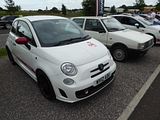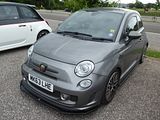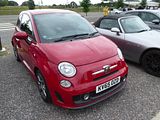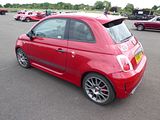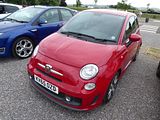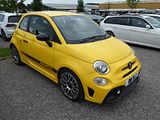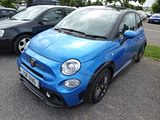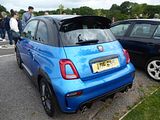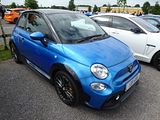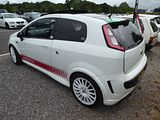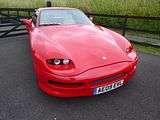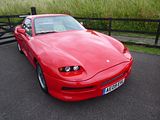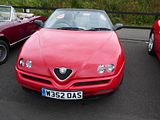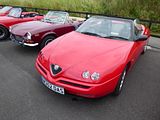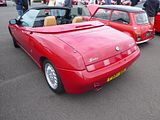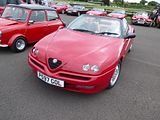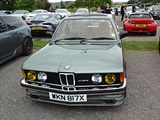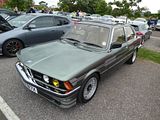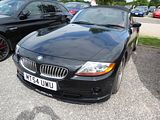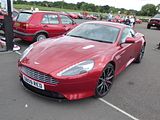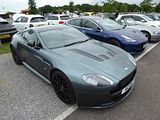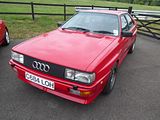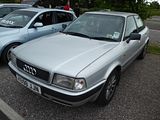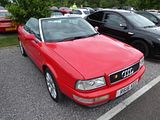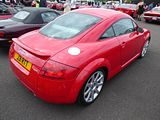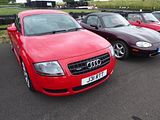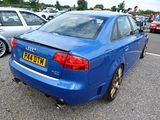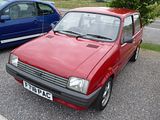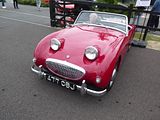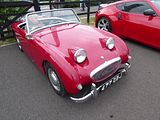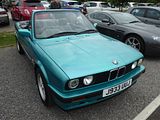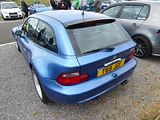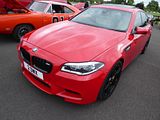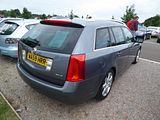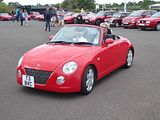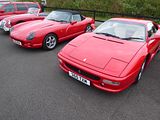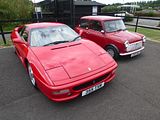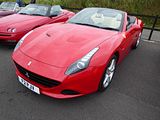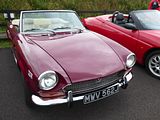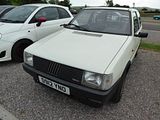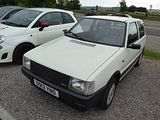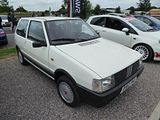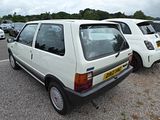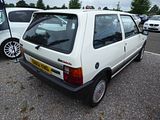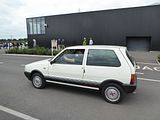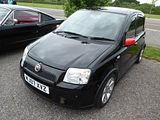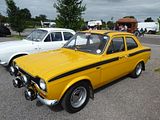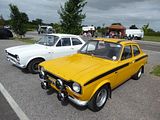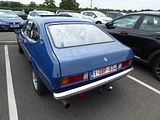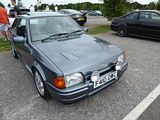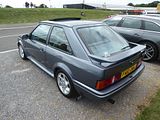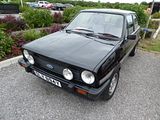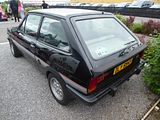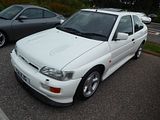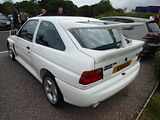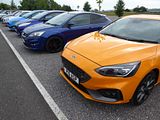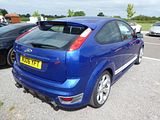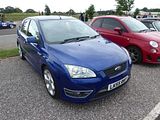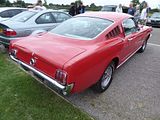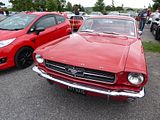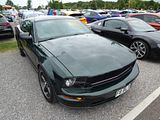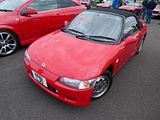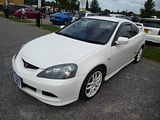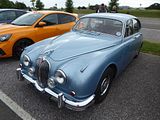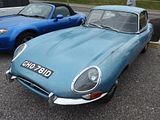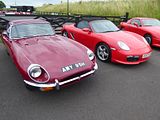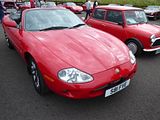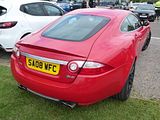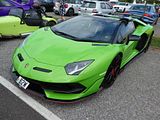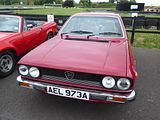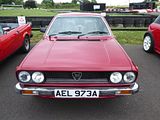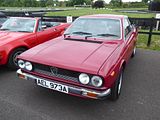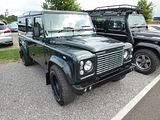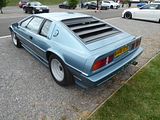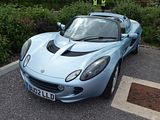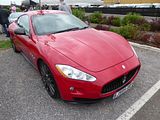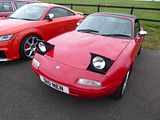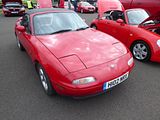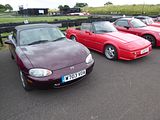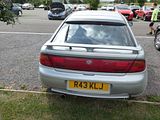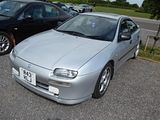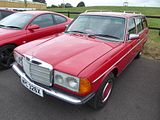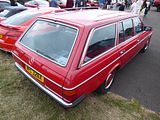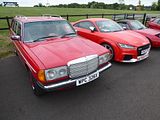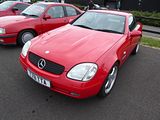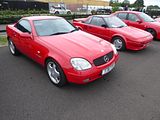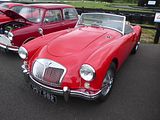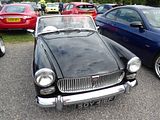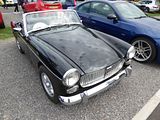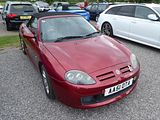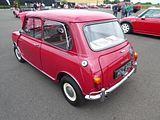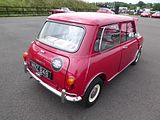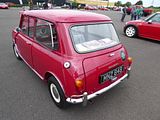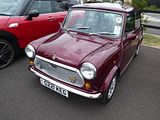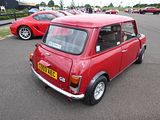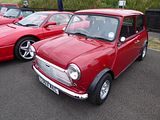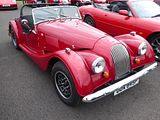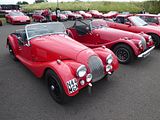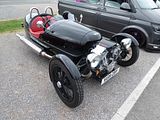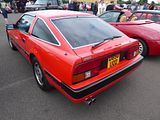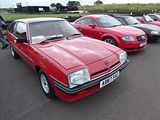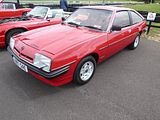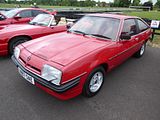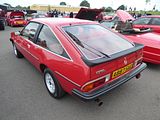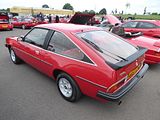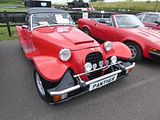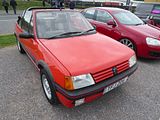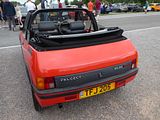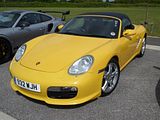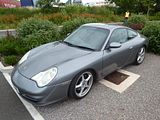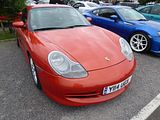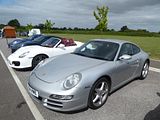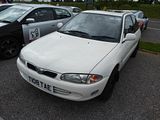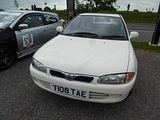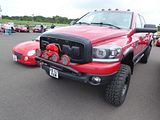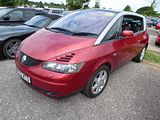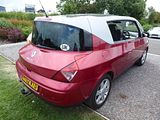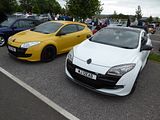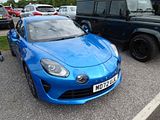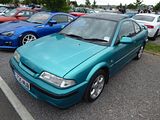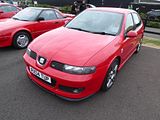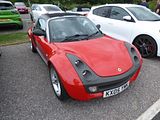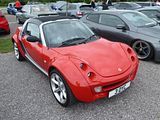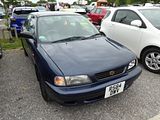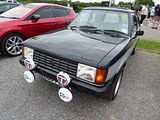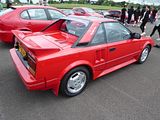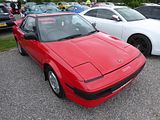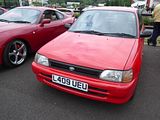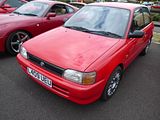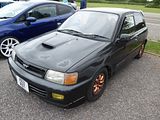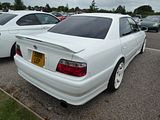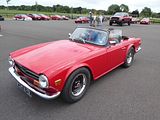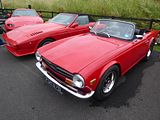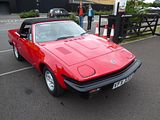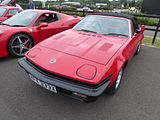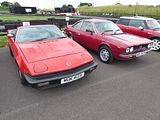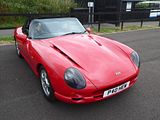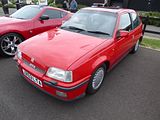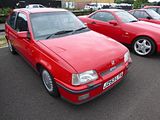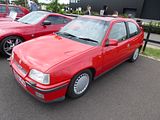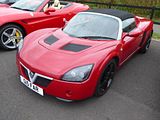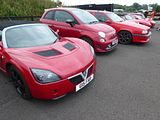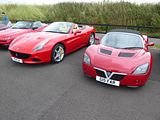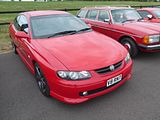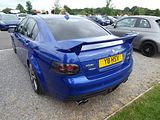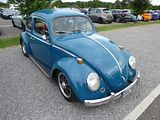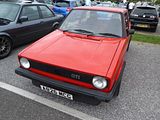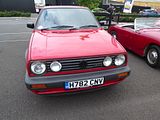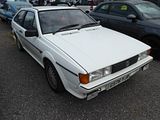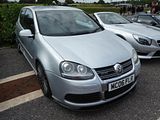Such is the pressure on my diary, with a huge number of events that it has taken until July to get to my first Haynes Breakfast Club event. These take place on the first Sunday of every month throughout the year, and as all parking is on hard-standing these days, they do not pause for a winter break and nor are they subject to the challenges of parking on grass that are issues some events face. These meets have become exceedingly popular and for some time now, it has been necessary to purchase a ticket well in advance, as they always sell out. A more recent innovation is to designate a theme for each event and the area that is called the Paddock is reserved for theme-compliant cars. You have to apply for this when buying a ticket and may or may not get lucky depending on numbers. For this event the theme was “red”, so needless to say that influenced my decision to take the Abarth, and to apply for a paddock display, which I was granted. There were a lot of different shades of red in this area, just as there are in the Red Room in the museum, but it certainly made for a very colourful display area, with a huge variety of cars included. There were plenty of other interesting cars in the rest o the event, too, as this report which showcases some but not all of them, evidences:
ABARTH
Having used the legendary 695 badging from the 1960s on the Tributo cars, at the 2012 Geneva Show, Abarth dusted off the 595 name that had been used on the less powerful of the Nuova 500 based cars of the same generation, and created two new versions which we should think of as Series 2 cars, the 595 Turismo and Competizione, both of which could be bought in either closed or open top C guise, with either the 5 speed manual or robotised automated gearshifts. Both models had the 160 bhp engine as standard. Effectively they were a replacement for the Esseesse kit, and it meant that the cars were produced complete at the factory, rather than needing the dealer to undertake the upgrade (and the associated paperwork), though Abarth did not withdraw the Esseesse kits from the market for some while. Turismo, as the name suggests was aimed slightly less extreme in intent, featuring standard leather upholstery, upgraded dampers and climate control, Xenon headlights and Alutex interior details. The sportier Abarth 595 Competizione replaced the leather seats with Sabelt cloth sport seats and Alutex with aluminium, while adding p-cross-drilled brakes and the Record Monza dual-mode exhaust.
Some new colours were introduced, and very soon one of those, Record Grey, frequently combined with a tan interior became one of the most popular choices. There were several examples of this popular colour here and there is no denying that this combination suits the Abarth shape very well.
Rumours started to circulate towards the end of 2014 that Abarth were going to upgrade the Competizione model, so as better to bridge the gap between the Turismo and the 190 bhp 695 Biposto that had been added to the range earlier in the year. It was Geneva 2015 when the result was finally shown to an expectant fan base. Most exciting news was that thanks to a bigger Garrett Turbo, the engine had been tweaked to 180 bhp, and with reduced CO2 emissions. A standard spec that included Koni Dampers, Brembo brakes, Xenon lights, Sabelt seats, Climate Control, parking sensors as well as other refinements that had been added like the TFT instrument display all proved very compelling, so not long after the first cars reached the UK in June of 2015, I found temptation too hard to resist, and as is well documented here, swapped my 2010 car for one of these. At the time I ordered it, Cordolo Red, a tri-coat pearlescent paint which shimmers in bright sunlight looked set to become one of the most popular colours of the lot, even though it is a cost option. Indeed, the Launch Edition models were all offered either in this colour or Scorpion Black, with black wheels. Surprisingly, the colour was not carried over to the Series 4 cars.
What is known as the Series 4 version of the familiar 595 reached the markets in the middle of 2016. After rumours had circulated all winter following the launch of the facelifted Fiat 500 last year, Abarth finally unveiled the Series 4 at the end of May 2016. Initially, we were told that the cars would not be available in the UK until September, but that came forward somewhat, with dealers all receiving demo cars in June, and the first customers taking delivery in July. Three regular production versions of both the closed car and the open-topped C were initially available, all badged 595, and called Custom, Turismo and Competizione, as before, though numerous limited edition models have since appeared and in most case disappeared. The most significant changes with the Series 4 are visual, with a couple of new colours, including the much asked for Modena Yellow and a different red, called Abarth Red, which replaces both the non-metallic Officina and – slightly surprisingly – the tri-coat pearlescent Cordolo Red. as well as styling changes front and rear. The jury is still out on these, with many, me included, remaining to be convinced. At the front, the new air intake does apparently allow around 15 – 20 % more air in and out, which will be welcome, as these cars do generate quite a lot of heat under the bonnet. Competizione models for the UK retain the old style headlights, as they have Xenon lights as standard, whereas the Custom and Turismo cars have reshaped units. At the back, there are new light clusters and a new rear bumper and diffuser. Inside, the most notable change is the replacement of the Blue & Me system with a more modern uConnect Audio set up, which brings a new colour screen to the dash. Mechanically, there is an additional 5 bhp on the Custom (now 145) and Turismo (now 165 bhp) and the option of a Limited Slip Diff for the Competizione, which is likely to prove a popular option. Details of the interior trim have changed, with a filled-in glovebox like the US market cars have always had, and electric windows switches that are like the US ones, as well as a part Alcantara trim to the steering wheel in Competizione cars. These cars have now been on offer for seven years and with Abarth sales on the rise, it was no surprise that they were particularly well represented here.
This is the Abarth 695 Tributo 131 Rally, and as you may have guessed from the name it pays homage to the fantastically-boxy Abarth 131 Rally. It was launched to mark 40 years since the 131 Rally’s last official race, and that is absolutely a car worth celebrating. In the late 1970s and early 80s, the 131 won three WRC manufacturer titles and two drivers’ championships. It looked ridiculously cool while doing so too. The 695 Tributo is perhaps slightly less cool, with no more power than the standard 178bhp 695 and the same 1.4-litre turbo engine. There’s the same Koni front and rear shocks too, plus Brembo brakes and the adjustable ‘Spoiler ad Assetto Variabile’ that was first shown on the 695 Esseesse. The Tributo 131 Rally was limited to just 695 examples though, with each one costing a fairly hefty £32,325. For that you’ll also get a Record Monza Sovrapposto exhaust, diamond-cut 17-inch alloys and three-layer Blue Rally paint. There’s also plenty of 131 Rally silhouettes to let everyone inside and out know that you’ve bought a very special version of the special Fiat 500. There was a long interval between announcement and the cars hitting the UK, and I’ve only ever seen a couple of them at events, so these look like they are going to be among the rarer of the many special editions of the 500-based car.
The Punto Evo was launched at the 2010 Geneva Show, with the cars reaching UK buyers in the summer of that year, and it incorporated many of the changes which had been seen a few months earlier on the associated Fiat models, the visual alterations being the most obvious, with the car taking on the nose of the associated Fiat, but adapted to make it distinctively Abarth, new rear lights and new badging. There was more to it than this, though, as under the bonnet, the T-Jet unit was swapped for the 1.4 litre Multi-Air, coupled to a 6 speed gearbox, which meant that the car now had 165 bhp at its disposal. Eventually, Abarth offered an Esseesse kit for these cars, though these are exceedingly rare. For those in the know – which never seemed to be that many people – this was a really capable and desirable car, and the owners love them, lamenting the fact that the model had quite a short production life and has not been replaced
AC
The AC Brooklands Ace is a roadster built by the British automotive company AC Cars. Launched in 1993 following two previous concept cars of 1986 and 1991, the Brooklands Ace underwent small scale production until 1997 when it received a facelift and reengineering under AC’s new owners and was relaunched. The Brooklands Ace did not prove popular, and production ceased in 2000 after a total production run of approximately 58. The Brooklands Ace traces its history back to the 1986 concept car called the Ace of Spades that featured a high proportion of Ford parts including the 2.9 V6 engine and four-wheel drive system. The car underwent significant development before reappearing in 1991 with a new design by IAD, a stainless steel chassis and a Ford 3.0 V6 engine. The second prototype was a standard two-seater, dropping the 2+2 design of the Ace of Spades. In 1993 the production model was launched, with a new specification and went into small scale production for two years before AC Cars folded in 1996. The production model is powered by a 5.0 L V8 engine from Ford and is shared with the AC Cobra, producing 225 bhp. The final version included an electric hood mechanism but the pop-up headlights from the earlier prototype had been abandoned, but the aluminium body was kept. Production ended with 46 of the original versions made between 1993 and 1996, by which time AC Cars had gone into receivership. Under new ownership in 1996, the Brooklands Ace underwent a significant redesign and re-engineering, with a relaunch at the 1997 London Motor Show as the Ace V8, dropping the Brooklands name. Sales started in 1998, but despite the changes, production reached only 12 units before ending in 2000. The external changes included a significant re-design to the bumpers, grille, lights (now rectangular instead of round), and a new bonnet. As well as production of some elements outsourced to South Africa, final assembly was undertaken in Coventry. A change of some manufacturing techniques to reduce cost and weight was also included in the refreshed design. The second generation Ace weighs 1,453 kg (3,203 lb), sits on a wheelbase of 2,472 mm (97.3 in) and an overall length of 4,420 mm (174.0 in). The engine range was increased with two 5.0 L V8 options, in 240 bhp and 320 bhp V8 supercharged variations; a 4.6 litre 320 bhp V8 32-valve fuel injected quad cam engine, and a Lotus 3.5 V8 producing 251 bhp. The 1999 London Motor Show car was originally fitted with the Lotus engine, but as it was never operational a 4.6-litre Cobra engine was later installed. A four-seater version called the AC Aceca, reviving an old AC model name, was also launched with the 4.6 L V8 engine. The 5.0 V8 achieved a top speed of 135 mph (217.3 km/h) and could accelerate from 0 to 60 in 6.9 seconds. The supercharged 5.0 could reach 155 mph (249.4 km/h) and accelerate to 60 mph in 5.5 seconds.
ALFA ROMEO
The 916 Series cars were conceived to replace two very different models in the Alfa range. First of these was the open topped 105 Series Spider which had been in production since 1966 and by the 1990s was long overdue a replacement. Alfa decided to combine a follow on to the Alfetta GTV, long out of production, with a new Spider model, and first work started in the late 1980s. The task was handed to Pininfarina, and Enrico Fumia’s initial renderings were produced in September 1987, with the first clay models to complete 1:1 scale model made in July 1988. Fumia produced something rather special. Clearly an Italian design, with the Alfa Romeo grille with dual round headlights, recalling the Audi-based Pininfarina Quartz, another design produced by Enrico Fumia back in 1981, the proposal was for a car that was low-slung, wedge-shaped with a low nose and high kicked up tail. The back of the car is “cut-off” with a “Kamm tail” giving improved aerodynamics. The Spider would share these traits with the GTV except that the rear is rounded, and would feature a folding soft-top with five hoop frame, which would completely disappear from sight under a flush fitting cover. An electric folding mechanism would be fitted as an option. Details included a one-piece rear lamp/foglamp/indicator strip across the rear of the body, the minor instruments in the centre console angled towards the driver. The exterior design was finished in July 1988. After Vittorio Ghidella, Fiat’s CEO, accepted the design, Alfa Romeo Centro Stile under Walter de Silva was made responsible for the completion of the detail work and also for the design of the interiors, as Pininfarina’s proposal was not accepted. The Spider and GTV were to be based on the then-current Fiat Group platform, called Tipo Due, in this case a heavily modified version with an all new multilink rear suspension. The front suspension and drivetrain was based on the 1992 Alfa Romeo 155 saloon. Chief engineer at that time was Bruno Cena. Drag coefficient was 0.33 for the GTV and 0.38 for the Spider. Production began in late 1993 with four cars, all 3.0 V6 Spiders, assembled at the Alfa Romeo Arese Plant in Milan. In early 1994 the first GTV was produced, with 2.0 Twin Spark engine. The first premiere was then held at the Paris Motor Show in 1994. The GTV and Spider were officially launched at the Geneva Motor Show in March 1995 and sales began the same year. The cars were well received. At launch, many journalists commented that Alfa had improved overall build quality considerably and that it came very close to equalling its German rivals. I can vouch for that, as I owned an early GTV for eighteen months, and it was a well built and reliable car. In 1997 a new engine, a 24-valve 3.0 litre V6, was available for the GTV along with bigger, 12.0 inch brakes and red four-pot calipers from Brembo. The console knobs were changed from round central to rectangle ones and to a three-spoke steering wheel. Some versions were upgraded with different front bumper mesh to bring the wind noise down to 74 dBA. In May 1998 the cars were revamped for the first time, creating the Phase 2 models. Most of the alterations were inside. The interior was changed with new centre console, painted letters on skirt seals, changed controls and switches arrangement and different instrument cluster. Outside, the main changes included chrome frame around the grille and colour-coded side skirts and bumpers. A new engine was introduced, the 142 bhp 1.8 Twin Spark, and others were changed: the 2.0 Twin Spark was updated with a modular intake manifold with different length intakes and a different plastic cover. Power output of the 2.0 TS was raised to 153 bhp. Engines changed engine management units and have a nomenclature of CF2. The dashboard was available in two new colours in addition to the standard black: Red Style and Blue Style, and with it new colour-coded upholstery and carpets. The 3.0 24V got a six-speed manual gearbox as standard and the 2.0 V6 TB engine was now also available for the Spider. August 2000 saw the revamp of engines to comply with new emission regulations, Euro3. The new engines were slightly detuned, and have a new identification code: CF3. 3.0 V6 12V was discontinued for the Spider and replaced with 24V Euro3 version from the GTV. 2.0 V6 Turbo and 1.8 T.Spark were discontinued as they did not comply with Euro3 emissions. By the 2001-2002 model year, only 2 engines were left, the 2.0 Twin.Spark and 3.0 V6 24V, until the Phase 3 engine range arrived. The Arese plant, where the cars had been built, was closing and, in October 2000, the production of GTV/Spider was transferred to Pininfarina Plant in San Giorgio Canavese in Turin. In 2003 there was another and final revamp, creating the Phase 3, also designed in Pininfarina but not by Enrico Fumia. The main changes were focused on the front with new 147-style grille and different front bumpers with offset numberplate holder. Change to the interior was minimal with different centre console and upholstery pattern and colours available. Instrument illumination colour was changed from green to red. Main specification change is an ASR traction control, not available for 2.0 TS Base model. New engines were introduced: 163 bhp 2.0 JTS with direct petrol injection and 237 hp 3.2 V6 24V allowing a 158 mph top speed. Production ceased in late 2004, though some cars were still available for purchase till 2006. A total of 80,747 cars were made, and sales of the GTV and Spider were roughly equal. More V6 engined GTVs than Spiders were made, but in 2.0 guise, it was the other way round with the open model proving marginally more popular.
The Alfa Romeo 4C is a two-seater, rear-wheel drive coupé with technology and materials derived from the Alfa Romeo 8C Competizione, with a 1750 cc turbo petrol engine with direct injection, the “Alfa TCT” twin dry clutch transmission, and the Alfa DNA dynamic control selector. The 4C concept version was unveiled in the 81st Geneva Motor Show in March 2011, followed by the Mille Miglia 2011 parade, Goodwood Festival of Speed 2011,2011 Frankfurt Motor Show. It was displayed for the first time outside in Concorso d’Eleganza Villa d’Este in 2012. Compared to the production version, it is very similar, with the biggest differences being front lights, side vents and mirrors. The Alfa Romeo 4C Concept was voted the ‘Most Beautiful Concept Car of the Year’ award by the readers of German magazine Auto Bild, and won the Auto Bild Design Award 2011. It was awarded the “Design Award for Concept Cars & Prototypes” by referendum of the public in Villa d’Este. The production car was unveiled at the 2013 Geneva Motor Show, followed by 2013 Essen ‘Techno Classica’, Goodwood Festival of Speed 2013, Moscow Raceway, 2013 Frankfurt Motor Show. The bare ‘4C000’ chassis was also shown at the 2013 Geneva Motor Show. Ordering of European models began in October 2013 at Alfa Romeo dealerships in Europe. As part of the Alfa Romeo 4C launch, Alfa Romeo Style Centre and Compagnia Ducale designed a 4C IFD (Innovative Frame Design) Bicycle, inspired by the Alfa Romeo 4C coupé. The vehicle went on sale in December 2013 and marketed in Europe, Asia and America. Production of the 4C began May 2013 at Maserati’s plant in Modena, with an expected production of up to 2500 units per year. It was the first mass-produced Alfa Romeo model to be sold in the US market since 1995 when the 164 sedan stopped being sold in the US. Production of the Alfa Romeo 4C was originally estimated to be over 1000 units per year, with an upper limit of 3500 units per year, depending on the quantity of carbon fibre chassis that can be built by the supplier Adler Plastic.Within the 3,500-unit quota, 1,000 units are earmarked for Europe. Delivery of the European Alfa Romeo 4C Launch Edition took place at Balocco (Vercelli, Italy) Test Centre. In 2018, the 4C coupe was discontinued for the North American market. The 4C Spider, however continued to be sold there for model year 2019 and model year 2020. In other markets, such as Australia and Japan, both the coupe and Spider continued. In late 2020, a new tribute-edition named the 4C Spider 33 Stradale Tributo was announced. The car was designed by Centro Stile Alfa Romeo (Style Centre) and developed by Alfa Romeo. The chassis is composed of a central carbon fibre tub, with aluminium subframes front and rear. The carbon fibre tub is produced by TTA (Tecno Tessile Adler) in Airola, as a joint venture between Adler Plastic and Lavorazione Materiali Compositi. The carbon fibre components that make up the chassis are cut using CNC technology. The entire carbon-fibre monocoque chassis (“tub”) of the car weighs 143 pounds (65 kg). Front and rear aluminium subframes combine with the tub, roof reinforcements and engine mounting to comprise the 4C chassis giving the vehicle a total chassis weight of 236 lb (107 kg) and a total vehicle curb weight of just 2,465 lb (1,118 kg). The 4C has a single carbon fibre body, similar to the body of many supercars. The outer body is made of a composite material (SMC for Sheet Moulding Compound) which is 20% lighter than steel. The stability is comparable to steel and better than aluminium. The 4C employs double wishbone suspensions at the front and MacPherson struts at the rear. The resultant weight distribution is 38% on the front and 62% on the rear axle. Wheels and tyres have different diameters and widths front and rear: 205/45 R17 front and 235/40 R18 back as standard, with optional 205/40 R18 and 235/35 R19. Both wheel options come equipped with Pirelli P Zero tyres. The 4C uses vented disc brakes on all wheels; Brembo 305 millimetres (12.0 in) on the front and 292 millimetres (11.5 in) on the rear. The car can stop from 100 km/h (62 mph) in 36 metres. To save weight and increase steering feel, the 4C has no power steering. Its centre of gravity height, at 40 centimetres (16 in) off the ground, is 7 centimetres (2.8 in) lower than that of the Lotus Elise. The 4C uses a new all-aluminium 1,742 cc inline 4 cylinder turbocharged engine producing 240 PS at 6000 rpm. The engine has been designed for minimum weight. The engine’s combined fuel consumption 6.8 l/100 km (42 mpg‑imp; 35 mpg‑US).[4] 0–62 mph (0–100 km/h) acceleration is achieved in 4.5 seconds and the top speed is 258 km/h (160 mph), the power-to-weight-ratio being just 0.267 hp/kg (8.22 lb/hp) A journalist from Quattroruote car magazine demonstrated how the 4C accelerates from 0–100 km/h (0–62 mph) faster than 4.5 seconds. In race mode, with left foot on the brake pedal, if you pull the right shift paddle the engine will rev to 3500 rpm, but if you also pull the left paddle the engine will rev to 6000 rpm and 0–100 km/h (0–62 mph) time will go down to 4.2 seconds. Italian car magazine Quattroruote published the lap time of 4C around Nürburgring. It lapped the ring in 8:04. The 4C is equipped with a six speed Alfa TCT Dual Dry Clutch Transmission, and can be operated via gearshift paddles on the steering wheel. It also has an Alfa ‘DNA’ dynamic control selector which controls the behaviour of engine, brakes, throttle response, suspension and gearbox. In addition to the modes already seen in Giulietta, the 4C has a new “Race” mode. The U.S. version of the 4C was introduced in the 2014 New York International Auto Show with the first 100 4C’s being shipped to the U.S. early July, with a total of 850 being shipped by the end of 2014. The U.S. model includes extra bracing and strengthening required to meet U.S. crash regulations (including aluminium inserts in the carbon fibre chassis), resulting in 100 kg (220 lb) of weight increase. This version also has new headlamps similar to those seen before in the 4C Spider version. In 2018, the 4C coupe was discontinued for the North American market due to US DOT NHTSA FMVSS 226 Ejection Mitigation. The regulation called for a progressive compliance date based on volume and, due to low volume, the 4C was allowed to continue until the last compliance date of 9/1/2017, thus all 2018 4C coupes in North America have build dates of 8/2017 or earlier. The 4C Spider, however continued to be sold in North America for model year 2019 and model year 2020. The Spider version of the 4C was previewed showing a pre-production prototype at the 2014 Geneva Motor Show. Sharing its engine with the Coupé version, the 4C Spider has different external parts such as the headlights, exhaust and engine hood, as well as a different roof section that features a removable roof panel. The North American spec 4C reflects a weight difference of only 22 lb (10 kg) (2,465 lbs vs. 2,487 lbs) for the Spider variant. Top speed is quoted at 257 km/h (160 mph) and acceleration from 0 to 100 km/h (62 mph) at 4.5 seconds. The 4C Launch Edition was a limited and numbered edition, unveiled at the vehicle’s launch at the 2013 Geneva Motor Show. The vehicle came in a choice of four paint colours (Rosso Alfa, Rosso Competizione tri-coat, Madreperla White tri-coat or Carrara White matte). 500 examples were reserved for Europe/ROW, 500 for North America, 88 for Australia (Rosso Alfa and Madreperla White only), 200 to Japan and 100 for the Middle East. Note that the original press release cited 500 for North America, 400 Europe, and 100 ROW; however, the plaques on actual cars suggest that more were built and are the numbers referenced above. Distinguishing features of the Launch Edition were carbon fiber trim (including headlight housings, spoiler and door mirror caps), rear aluminium extractor with dark finishing, Bi-LED headlights, dark painted 18-inch front and 19-inch rear alloy wheels, additional air intakes on the front fascia, red brake calipers, racing exhaust system, BMC air cleaner, specific calibration for shock absorbers and rear anti-roll bar, leather/fabric sports seats with parts in Alcantara and a numbered plaque. Alfa Red coloured cars got matching red stitching on the steering wheel, handbrake, mats, handles and sports seats. In Europe the vehicle went on sale for 60,000 euros including VAT. The 4C Competizione is a limited edition version of the 4C introduced in the 2018 Geneva Motor Show, finished in matte Vesuvio Grey, with carbon details on the roof, rear spoiler, mirror caps, side air vents and headlight moulding. The run reportedly consisted of 108 units. The Japanese market received 25 units, and 10 units were assigned to Australia. The US-market received no Competizione editions. The car had a very mixed reaction. The UK press hated it at launch, but owners generally disagreed and loved it. A total of 9117 were built before production ceased in 2020.
ALPINA
The Alpina C1 was based on the E21 323i and was among their most popular early models, providing superior performance over the unmodified car. The C1 2.3 made 168 bhp and 225 Nm (166 lb/ft) of torque. 0–100 km/h (0-62 mph) is achieved in 7.8 seconds. Top speed was 213 km/h (132 mph). The extra power is due to special Mahle pistons, and a special exhaust and ignition system. It also received dry-sump lubrication and a short-ratio five-speed gearbox. Only 35 C1 cars were built, making it one of the rarest Alpina models. As BMW released the 325i, Alpina responded with the C2 2.5, and later the 2.7 models, providing between 190–210 hp. The brakes and suspension were also upgraded. The C1 2.5 and early C2 / 2.6* models used the M20B23 (2,3L) engine, but bore and stroke were increased to achieve a displacement of 2552 cc. Alpina reworked the head which was ported and polished, installed harder valve springs and a hotter cam. The intake manifold was also reworked, and Alpina used a larger throttle body. It produced 182 bhp, with 246 Nm (181 lb/ft) of torque. Alpina claimed 0–100 km/h (62 mph) acceleration in 7.1 seconds. Top speed was 220 km/h (137 mph). Production is unclear, with estimates ranging from 35 cars built to around 400 depending on the source.
The Alpina version of the E85 Z4 came at the 2003 Frankfurt Show and was called the Roadster S. Based on the 3 litre Z4, it used an Alpina tuned version of the older N52 engine to give 300 bhp which was coupled to a 6 speed auto box. Alpina modified the suspension and made minor tweaks to the exterior as well as applying their usual changes to the interior.
ARIEL
The Ariel Atom is a road-legal high performance open-wheel car made by the British Ariel Motor Company based in Crewkerne, Somerset, England, and under license in North America by TMI Autotech, Inc. at Virginia International Raceway in Alton, Virginia. The Atom began as a student project by Coventry University transport design student Niki Smart. Known then as the LSC (Lightweight Sports Car), it was developed at the university in 1996 with input and funding from various automotive industry members, including British Steel and TWR. Ariel Motor Company boss Simon Saunders was a senior lecturer whose responsibility for the project was primarily as financial manager and design critic for Smart, whom he described as “The best all-round design student I’ve ever seen.” The car was first shown publicly at the British International Motor Show at the NEC in Birmingham in October 1996. The Ariel Atom features a prominently visible chassis (i.e., an exoskeleton, no roof or windows, a small optional windscreen) and a drag coefficient of 0.40 There have been eight Ariel Atom generations to date: Ariel Atom, Ariel Atom 2, Ariel Atom 3 (including the Ariel Atom 3 Mugen Limited Edition and Honda Racing Edition – of which only one was made) Ariel Atom 3.5, Ariel Atom 3S, Ariel Spec:Race Atom, Ariel Atom 500 V8 Limited Edition (only 25 to be made), and the Ariel Atom 4. The limited production Ariel Atom 500 V8 featured a 500 bhp V8 engine. The Ariel Atom 4 uses a turbocharged 2.0 litre engine, also used in the Honda Civic Type R, with 3-stage boost.
ASTON MARTIN
Follow on to the DB7 was the DB9 (there has never been a car called DB8 – supposedly because people might have assumed this meant a V8 engine), and there was a nice example here. The Aston Martin DB9, designed by Marek Reichmann and Hendrik Fisker, was first shown by Aston Martin at the 2003 Frankfurt Auto Show, in coupe form. It was widely praised for the beauty of its lines. This was the first model to be built at Aston Martin’s Gaydon facility. It was built on the VH platform, which would become the basis for all subsequent Aston models. The Aston Martin DB9 was initially launched equipped with a 6.0 litre V12 engine, originally taken from the V12 Vanquish. The engine produced 420 lbf·ft of torque at 5,000 rpm and a maximum power of 444 hp at 6,000 rpm, allowing the DB9 to accelerate from 0 to 60 mph in 4.7 seconds and a top speed of 299 km/h (186 mph). The engine largely sits behind the front-axle line to improve weight distribution. Changes to the engine for the 2013 model year increased the power to 503 hp and torque to 457 lb-ft, decreasing the 0 to 60 mph time to 4.50 seconds and with a new top speed is 295 km/h (183 mph). The DB9 was available with either a six-speed conventional manual gearbox from Graziano or a six-speed ZF automatic gearbox featuring paddle-operated semi-automatic mode. The gearbox is rear-mounted and is driven by a carbon-fibre tail shaft inside a cast aluminium torque tube. The DB9 was the first Aston Martin model to be designed and developed on Ford’s aluminium VH (vertical/horizontal) platform. The body structure is composed of aluminium and composites melded together by mechanically fixed self-piercing rivets and robotic assisted adhesive bonding techniques. The bonded aluminium structure is claimed to possess more than double the torsional rigidity of its predecessor’s, despite being 25 percent lighter. The DB9 also contains anti-roll bars and double wishbone suspension, supported by coil springs. To keep the back-end in control under heavy acceleration or braking, the rear suspension has additional anti-squat and anti-lift technology. Later versions of the car also features three modes for the tuning: normal, for every-day use, sport, for more precise movement at the cost of ride comfort, and track, which furthers the effects of the sport setting. The Aston Martin DB9 Volante, the convertible version of the DB9 coupe, followed a few months later. The chassis, though stiffer, uses the same base VH platform. To protect occupants from rollovers, the Volante has strengthened windscreen pillars and added two pop-up hoops behind the rear seats. The hoops cannot be disabled and will break the car’s rear window if deployed. In an effort to improve the Volante’s ride while cruising, Aston Martin have softened the springs and lightened the anti-roll bars in the Volante, leading to a gentler suspension. The retractable roof of the Volante is made of folding fabric and takes 17 seconds to be put up or down. The Volante weighs 59 kilograms (130 pounds) more than the coupe. The coupe and Volante both share the same semi-automatic and automatic gearboxes and engine. The car was limited to 266 km/h (165 mph) to retain the integrity of the roof. Like the coupe, the original Volante has 420 lb·ft of torque at 5,000 rpm and a maximum power of 450 hp at 6,000 rpm. The 0 to 60 mph slowed to 4.9 seconds due to the additional weight. The DB9 was facelifted in July 2008, which mainly amounted to an increase in engine power, to 476 hp and a redesigned centre console. Externally, the DB9 remained virtually unchanged. For the 2013 model year revision, Aston made minor changes to the bodywork by adapting designs from the Virage, including enlarging the recessed headlight clusters with bi-xenon lights and LED daytime strips, widening the front splitter, updating the grille and side heat extractors, updating the LED rear lights with clear lenses and integrating a new rear spoiler with the boot lid. .On newer models, like the coupe’s, the Volante’s horsepower and torque increased to 517 PS (510 hp) and 457 lb·ft respectively. As a finale for the model, a more powerful DB9 was released in 2015, called the DB9 GT. This had 540 bhp and 457 lb-ft of torque at 5500 rpm, giving a 0 to 60mph time of 4.4 seconds and 0 to 100mph in 10.2 seconds, with the standing quarter mile dispatched in 12.8 to 12.9 seconds and a top speed of 183mph. Production of the DB9 ended in 2016 being replaced by its successor, the DB11.
Following the unveiling of the AMV8 Vantage concept car in 2003 at the North American International Auto Show designed by Henrik Fisker, the production version, known as the V8 Vantage was introduced at the Geneva Motor Show in 2005. The two seat, two-door coupé had a bonded aluminium structure for strength and lightness. The 172.5 inch (4.38 m) long car featured a hatchback-style tailgate for practicality, with a large luggage shelf behind the seats. In addition to the coupé, a convertible, known as the V8 Vantage Roadster, was introduced later in that year. The V8 Vantage was initially powered by a 4.3 litre quad-cam 32-valve V8 which produced 380 bhp at 7,300 rpm and 409 Nm (302 lb/ft) at 5,000 rpm. However, models produced after 2008 had a 4.7-litre V8 with 420 bhp and 470 Nm (347 lbft) of torque. Though based loosely on Jaguar’s AJ-V8 engine architecture, this engine was unique to Aston Martin and featured race-style dry-sump lubrication, which enabled it to be mounted low in the chassis for an improved centre of gravity. The cylinder block and heads, crankshaft, connecting rods, pistons, camshafts, inlet and exhaust manifolds, lubrication system and engine management were all designed in house by Aston Martin and the engine was assembled by hand at the AM facility in Cologne, Germany, which also built the V12 engine for the DB9 and Vanquish. The engine was front mid-mounted with a rear-mounted transaxle, giving a 49/51 front/rear weight distribution. Slotted Brembo brakes were also standard. The original V8 Vantage could accelerate from 0 to 60 mph in 4.8 seconds before topping out at 175 mph. In 2008, Aston Martin introduced an aftermarket dealer approved upgrade package for power and handling of the 4.3-litre variants that maintained the warranty with the company. The power upgrade was called the V8 Vantage Power Upgrade, creating a more potent version of the Aston Martin 4.3-litre V8 engine with an increase in peak power of 20 bhp to 400 bhp while peak torque increased by 10 Nm to 420 Nm (310 lb/ft). This consists of the fitting of the following revised components; manifold assembly (painted Crackle Black), valved air box, right and left hand side vacuum hose assemblies, engine bay fuse box link lead (ECU to fuse box), throttle body to manifold gasket, intake manifold gasket, fuel injector to manifold seal and a manifold badge. The V8 Vantage had a retail price of GB£79,000, US$110,000, or €104,000 in 2006, Aston Martin planned to build up to 3,000 per year. Included was a 6-speed manual transmission and leather-upholstery for the seats, dash board, steering-wheel, and shift-knob. A new 6-speed sequential manual transmission, similar to those produced by Ferrari and Lamborghini, called Sportshift was introduced later as an option. An open-topped model was added to the range in 2006 and then in the quest for more power a V12 Vantage joined the range not long after.
This version of the Vanquish started life as the Project AM310 Concept that was unveiled at the 2012 Concorso D’Eleganza at Villa D’Este on the shores of Lake Como, Italy. The concept car was based on the fourth generation VH platform. It included a tweaked version of Aston Martin’s familiar grille and headlight design and a more pronounced bulge in the bonnet – with the real One-77-inspired flourishes saved for the sides and the rear, the side vents run almost to the door handles (from One-77), new rear light design from One-77, and a 5.9-litre V12 engine that produced 550 PS. Aston Martin later announced that the concept would be put into production as the all new Aston Martin Vanquish. The exterior styling of the Vanquish is an evolution of the DBS with many styling cues such as the elongated side strakes being inspired by the Aston Martin One-77. The boot lid included an integrated rear spoiler designed to look as if it is impossible to make; this was done on the orders of Aston Martin Chief Executive, Dr. Ulrich Bez. The car has an exposed carbon fibre side skirt showing its all carbon fibre body. The Vanquish uses the new VH Generation IV platform which is lighter and uses more carbon fibre components than the VH Generation II platform used in the DBS. The car featured an all new interior based on the one found in the exclusive One-77. The standard interior was trimmed in hand stitched leather and alcantara and was available in a range of colours. The centre console features an revised infotainment system over the one found in the DBS. The car was available as either a 2-seater or 2+2. The Vanquish used an upgraded version of Aston Martin’s flagship 5.9-litre AM11 V12 engine called the AM28 with a power output of 565 bhp at 6,750 rpm and torque of 457 lb/ft at 5,500 rpm. The Vanquish can accelerate from 0 to 100 km/h (62 mph) in 4.1 seconds, and has a top speed of 295 km/h (183 mph). Like most Aston Martins, the engine is front mid-mounted for better weight distribution, with the power going to the rear wheels. The Vanquish has 51/49 front/rear weight distribution, and a kerb weight of 1,739 kg (3,834 lb). It uses a fully catalysed stainless steel exhaust system with active bypass valves. The Vanquish uses an updated Touchtronic II six-speed automatic gearbox. It was the first Aston Martin model to be available with launch control. The combined space of cabin and a boot that, at 368 litres, is more than 60% larger than that of the DBS. The brakes are ventilated carbon ceramic discs, 398 mm (15.7 in) six-piston callipers in the front and 360 mm (14.2 in) four-piston callipers in the rear. The suspension is a lightweight aluminium front subframe with hollow castings with independent double wishbones incorporating anti-dive geometry, coil springs, anti-roll bar, and monotube adaptive dampers in the front and independent double wishbones with anti-squat and anti-lift geometry, coil springs, anti-roll bar, and monotube adaptive dampers in the rear. It has a three-stage adjustable adaptive damping system including normal, sport and track modes. The tyres are Pirelli P Zeros, 255/ZR20 in the front and 305/30 ZR20 in the rear. The vehicle was unveiled in the London Film Museum, Covent Garden, followed by 2012 Monterey Car Week. Deliveries to UK and Continental Europe began in late 2012. In August 2014, Aston Martin revealed technical modifications to the Vanquish. The changes include a new eight-speed Touchtronic III gearbox and upgraded AM29 V12 engine that produces 568 bhp and torque of 465 lb/ft. The changes greatly enhanced performance, with an acceleration of 0 to 100 km/h (62 mph) in 3.6 seconds, and a top speed of 324 km/h (201 mph). In 2013, Aston Martin unveiled a convertible version of the Vanquish, called Volante. The Volante includes a full carbon fibre body, triple-skin lightweight fabric roof, 50% larger boot than its predecessor and the third generation Brembo 398 mm × 36 mm front and 360 mm × 32 mm CCM rear Carbon Ceramic Matrix (CCM) brake discs with six-piston front and four-piston rear brake callipers (from the One-77). The Vanquish Volante is 13% torsionally stiffer than the outgoing DBS Volante. The carbon fibre-skin of the Vanquish Volante was created by the engineering team at Aston Martin. The vehicle was unveiled at the 2013 Pebble Beach Concours d’Elegance. Deliveries to Europe began in late 2013. On 16 November 2016, Aston Martin announced the new Vanquish S model. The Vanquish S features the same AM29 V12 engine, with power now increased to 595 bhp, and a new aerodynamic package. The Vanquish S can accelerate from 0 to 100 km/h (62 mph) in 3.5 seconds, and the top speed remains unchanged at 201 mph (324 km/h). The starting price at launch was £199,950 and deliveries started in December 2016. Aston Martin also unveiled a convertible version of the Vanquish S called the Vanquish S Volante in 2017.
AUDI
Still well-regarded over 40 years since its launch is the Quattro, a legend which transformed rallying and brought the idea of four wheel drive as a performance benefit to the market. The idea for a high-performance four-wheel-drive car was proposed by Audi’s chassis engineer, Jörg Bensinger, in 1977, when he found that the Volkswagen Iltis could outperform any other vehicle in snow, no matter how powerful. Bensinger’s idea was to start developing an Audi 80 variant in co-operation with Walter Treser, Director of Pre-Development.. Following an unveiling on 1st March 1980, Audi released the original Quattro to European customers in late 1980, with the car featuring Audi’s quattro permanent four-wheel drive system (hence its name), and the first to mate four-wheel drive with a turbocharged engine. The original engine was the 2,144 cc in-line-5-cylinder 10 valve SOHC, with a turbocharger and intercooler. It produced 197 bhp propelling the Quattro from 0 to 100 km/h in 7.1 seconds, and reaching a top speed of over 220 km/h (137 mph). The engine was eventually modified to a 2,226 cc inline-5 10 valve, still producing 197 bhp, but with peak torque lower in the rev-range. In 1989, it was then changed to a 2,226 cc inline-5 20v DOHC setup producing 217 bhp, now with a top speed of 230 km/h (143 mph) Audi Quattros are referred to among owners and enthusiasts by their engine codes, to differentiate between the earlier and later versions: the earliest 2144 cc 10v being the “WR” engine, the 2226 cc 10v being the “MB” engine, and the later 20v being the “RR” engine. Hence, Quattro models may be referred to as either the WR Quattro, MB Quattro, and RR or “20v” Quattro, respectively. Quattro car production was 11,452 vehicles over the period 1980–1991, and through this 11 year production span, despite some touch-ups, there were no major changes in the visual design of the vehicle. For the 1983 model year, the dash was switched from an analogue instrument cluster, to a green digital LCD electronic instrument cluster. This was later changed in 1988 to an orange LCD electronic instrument cluster. The interior was redesigned in 1984, and featured a whole new dash layout, new steering wheel design, and new centre console design, the switches around the instrument panel were also redesigned at this time. In 1985 the dash changed slightly with harder foam and lost a diagonal stripe, the dash switches were varied slightly and the diff lock pull knob gave way to a two-position turning knob with volt and oil temp digital readouts. External styling received very little modification during its production run. Originally, the car had a flat fronted grille featuring four separate headlamp lenses, one for each of the low and high beam units. This was altered for the 1983 model year, and replaced with combined units featuring a single lens, but housing twin reflectors. This was changed again, for the 1985 model year, in what has become known as the ‘facelift model’ and included such alterations as a new sloping front grille, headlights, and trim and badging changes. Max speed was 124 mph. The RR 20v Quattro also featured a new three spoke steering wheel design, leather covering for door arm rests, gloveboxes, centre console and door pockets. There was also a full length leather-wrapped centre console running all the way to the rear seats. The 20v was also the first Ur-Q to have “quattro” script interior with partial leather seats. The floor on the drivers side had a bulge due to dual catalytic exhaust setup. The different models may be distinguished by the emblems on their boot lids: the WR had a vinyl ‘quattro’ decal or a brushed aluminium effect plastic emblem, the MB had chrome plated ‘audi’, ‘audi rings’ and ‘quattro’ emblems, whilst the RR had only chrome plated ‘audi rings’. The rear suspension was altered early on with geometry changes and removal of the rear anti-roll bar to reduce a tendency for lift-off oversteer. For the 1984 facelift, the wheel size went from 6×15-inch with 205/60-15 tyres to 8×15-inch wheels with 215/50-15 tyres. At the same time the suspension was lowered 20 mm with slightly stiffer springs for improved handling. For 1987, the Torsen centre differential was used for the first time, replacing the manual centre differential lock. The last original Audi Quattro was produced on 17 May 1991, more than two years after the first models of the new Audi Coupe range (based on the 1986 Audi 80) had been produced.
In September 1986, Audi released a new Typ 89 Audi 80 for the 1987 model year on the European market and introduced it elsewhere within a year. It was based on a new platform which broke the relationship between the 80 and the Volkswagen Passat, the corresponding third generation of which used the transverse-engined Volkswagen B3 platform, whilst Audi stuck with the longitudinal front wheel drive layout for the B3-series 80. Production codes were Typ 89 from 1987 to 1989, and Typ 8A from 1990 onwards (in line with a restructuring of many VW platform designations). It introduced a new aerodynamic look and a fully zinc coated galvanised bodyshell. Unlike its predecessor, the B3 was marketed worldwide only as the Audi 80 or Audi 90. Initially, Audi transferred existing powertrain concepts to the new model although fuel injection was now available for some engines. A range of new petrol and diesel inline four-cylinder engines became available to European customers along with the procon-ten safety system which became standard fitment from 1991. Procon-ten was a notable safety feature comprising a series of hidden steel cables routed behind the gearbox, attached to the steering wheel and front seatbelt inertia reels. In the event of a front impact, the engine and gearbox are forced rearwards, pulling on these cables. This action simultaneously pulls the steering wheel into the dashboard to prevent the driver colliding with it while tightening the front seatbelts. This innovation was a precursor to the airbag, which became popular on mass produced cars during the 1990s after being patented by Mercedes-Benz in 1982. In 1987, the Audi 90 was reintroduced as an upmarket, more luxurious variant of the 80. To begin with it would again feature a choice of 10-valve inline five-cylinder petrol engines, and could be specified with or without quattro. The 90 differs visually to the 80 by a full width tail-light panel; headlights which featured additional high-beam lights and a slightly different front grille. Indicator lamps were moved from beside the headlights to the bumpers next to the fog lights, which were standard fitment on the 90. Brightwork surrounds for the windows, tops of the bumpers and side rubbing strips were also standard. Interiors were upgraded over the 80 featuring velour seat coverings and a slightly more generous level of equipment. The then range-topping 2.2E offered a boot spoiler, alloy wheels, leather steering wheel and sports front seats. Switchable ABS was standard on quattro versions. From 1989 to 1991 the Audi 90 offered the first 20-valve engine from Audi since the turbocharged engine used in the Audi Sport Quattro. This new 2.3L engine produced 170 PS and featured in the front wheel drive 20V, 20V Sport and four-wheel drive 20V quattro derivatives. The non-quattro 20V models were 120 kg lighter. Externally, Sport versions of the 90 were visually distinguished by the deletion of brightwork in favour of satin black window surrounds, bumper cappings and thinner side mouldings. A raised aluminium boot spoiler, lowered suspension and uprated brakes were fitted as standard, Speedline wheels were also standard fitment in the UK. In October 1988 a Coupé version based on the 80/90 appeared, called simply the Audi Coupé (typ 8B). This had completely different three-door liftback bodywork and replaced the earlier, B2-based Coupé which had been manufactured into early 1988. This version remained in production until 1996, in parallel with the succeeding B4 generation Audi 80.
A convertible was planned from the beginning but did not appear until May 1991 as the Audi Cabriolet. This model remained in production until 2000 and was optically aligned with the B4 Audi 80 from its introduction.
The styling of the Audi TT began in the spring of 1994 at the Volkswagen Group Design Center in California. The TT was first shown as a concept car at the 1995 Frankfurt Motor Show. The design is credited to J Mays and Freeman Thomas, with Hartmut Warkuss, Peter Schreyer, Martin Smith and Romulus Rost contributing to the interior design. A previously unused laser beam welding adaptation, which enabled seamless design features on the first-generation TT, delayed its introduction. Audi did not initially offer any type of automatic transmission option for the TT. However, from 2003, a dual clutch six-speed Direct-Shift Gearbox (DSG) became available, with the United Kingdom TT variants becoming the world’s first user of a dual clutch transmission configured for a right-hand drive vehicle, although the outright world first for a road car equipped with a dual clutch transmission was claimed earlier by a Volkswagen Group platform-mate, the left hand drive Volkswagen Golf Mk4 R32. The Audi TT takes its name from the successful motor racing tradition of NSU in the British Isle of Man TT (Tourist Trophy) motorcycle race. NSU marque began competing at the Isle of Man TT in 1907 with the UK manager Martin Geiger finishing in fifth position in the single-cylinder race. The 1938 Isle of Man Lightweight TT race was won by Ewald Kluge with a 250 cc supercharged DKW motor-cycle and the DKW and NSU companies later merged into the company now known as Audi. The TT name has also been attributed to the phrase “Technology & Tradition”. The production model (internal designation Type 8N) was launched as a coupé in September 1998, followed by a roadster in August 1999. It is based on the Volkswagen Group A4 (PQ34) platform as used for the Volkswagen Golf Mk4, the original Audi A3, the Škoda Octavia, and others. The styling differed little from the concept, except for slightly reprofiled bumpers, and the addition of rear quarterlight windows behind the doors. Factory production commenced in October 1998. Early TT models received press coverage following a series of high-speed accidents and the related fatalities which occurred at speeds in excess of 112 mph (180 km/h) during abrupt lane changes or sharp turns. Both the coupé and roadster variants were recalled in late 1999/early 2000, to improve predictability of the car’s handling at very high speeds. Audi’s Electronic Stability Programme (ESP) or Anti Slip Regulation (ASR) and rear spoiler were added, along with modifications to the suspension system. All changes were incorporated into subsequent production. Mechanically, the TT shares an identical powertrain layout with its related Volkswagen Group-mates. The TT uses a transversely mounted internal combustion engine, with either front-wheel drive or ‘quattro four-wheel drive’ available as an option. It was first available with a 1.8-litre inline four-cylinder 20-valve turbocharged engine in two states of DIN-rated power outputs; 180 PS (178 bhp) and 225 PS (222 bhp). The engines share the same fundamental design, but the 225 PS version features a larger K04 turbocharger (180 PS version came with a smaller K03), an additional intercooler on the left side (complementing the existing right-side intercooler), larger 20mm wrist-pins, a dual tailpipe exhaust, intake manifold with inlet on driver’s side, and a few other internals – designed to accommodate the increase in turbo boost, from roughly 10 pounds per square inch (0.7 bar) peak, to 15 pounds per square inch (1.0 bar). Haldex Traction enabled four-wheel drive, ‘branded’ as “Quattro” was optional on the 180 engine, and standard on the more powerful 225 version. The original four-cylinder engine range was complemented with a 3,189 cc VR6 engine rated at 250 PS (247 bhp) and 320 Nm (236 lb/ft) of torque in early 2003, which came as standard with the quattro four-wheel-drive system. In July 2003, a new six-speed dual clutch transmission – dubbed the Direct-Shift Gearbox (DSG), which improves acceleration through much-reduced shift times, was offered, along with a stiffer suspension. The second generation TT was launched in 2006.
A variantof the B5 generation A4, developed by quattro GmbH, was first introduced in May 2005, named “Audi A4 DTM Edition”. It was inspired by Audi’s race cars of the 2004 Deutsche Tourenwagen Masters and was reintroduced in 2006 as a regular option. The 2.0T FSI engine received revised software mapping to the ECU, which increased the output to 220 PS (217 bhp) and 300 Nm (221 lb/ft) of torque. It was available with front-wheel drive, or Quattro four-wheel drive.
The second generation of the R8 (model code: Type 4S) was unveiled at the 2015 Geneva Motor Show and is based on the Modular Sports System platform shared with the Lamborghini Huracan. The development of the Type 4S commenced in late 2013 and was completed in late 2014. Initial models included the all-electric e-Tron and the V10 5.2 FSI along with the V10 plus. Unlike its predecessor, there was no manual transmission available and the entry-level V8 trim was also dropped. In 2016, the convertible (Spyder) variant was added to the line up which was initially available in the base V10 trim. In mid-2017, the high performance V10 plus Spyder was added to the range. A rear-wheel-drive model called the R8 RWS was introduced. In 2018, the R8 received a mid-cycle refresh with mechanical and exterior changes. The newer and more aggressive design language carried over from famous Audi models of the past and it’s appearance is slightly more angular up front. Some of the aerodynamic features such as the front aeroblades are shared with the Lamborghini Huracàn. The refreshed model had substantial performance improvements over its predecessor. The base R8 gets a power boost from 532 hp to 562 hp, while the V10 Plus was renamed V10 Performance Quattro and the engine saw a power increase by 10 bhp, now up to 612 bhp. The Audi R8 e-tron (2015) was an all-electric version of the second-generation R8. Unlike the earlier 2010 prototype based on the first-generation R8, it actually entered production, but only on a small scale, with less than 100 units sold. It featured a 92-kWh battery.
AUSTIN
“A British car to beat the world”. So read the billboards when the Austin Metro was revealed in October 1980. We had waited a long time for this car. There were many false starts, with thoughts first turning to how to replace the Mini going back to the late 1960s, but for various reasons, every effort had been cancelled. Fortunately, that extended to the ADO88 prototype which got to quite an advanced state of development in 1978, but which received less than favourable feedback at customer clinics. A hasty redesign was conducted. Despite carrying over the A Series engines, albeit in modified A+ guise, as BL had nothing else suitable and no money to develop an alternative, and that meant the 4 speed in-sump gearbox came with it, the little Metro was an immediate hit. It looked good, with pert, modern styling, and was practical with a large hatchback, and some innovative ideas on how to maximise the use of space. This was a roomy car that Britain could indeed be proud of. That a young lady who came to prominence in the months following launch, the future Princess Diana, could be seen driving around in one probably helped still further. Five models were available at launch: 1.0, 1.0L, the economy-oriented 1.0 HLE, 1.3S and 1.3 HLS, and the cars were available in a wide range of bright and attractive colours, including a greater percentage of metallic paints than were typically offered to buyers of cars in this class. My parents bought a 1.0L in the summer of 1983, as a replacement for our Mini, and the car was a massive improvement in just about every respect. Unlike previous BL cars, this model was not dogged with build quality and reliability issues, though, sadly it did have the same propensity to rust as they had done, but it took several years before that would become obvious. Before that happened, the range was expanded with the introduction of cheaper a model using AP’s clever 4 speed Automatic gearbox, cheaper City and City X models, a top spec Vanden Plas and then the sporting MG version. There was a 1.3 HLE model here, in the post 1984 facelift which saw the introduction of 5 door models as well as cosmetic and equipment changes across the range.
AUSTIN HEALEY
Known officially as the Sprite, it was announced to the press in Monte Carlo by the British Motor Corporation on 20 May 1958, just before that year’s Monaco Grand Prix. It was intended to be a low-cost model that “a chap could keep in his bike shed”, yet be the successor to the sporting versions of the pre-war Austin Seven. The Sprite was designed by the Donald Healey Motor Company, with production being undertaken at the MG factory at Abingdon. It first went on sale at a price of £669, using a tuned version of the Austin A-Series engine and as many other components from existing cars as possible to keep costs down. It was produced for a little over 3 years before being replaced by a Mark 2 version, which was then joined by a badge-engineered MG version, the Midget, reviving a model name used by MG from the late 1920s through to the mid 1950s. Enthusiasts often refer to Sprites and the later Midgets collectively as “Spridgets.” The first Sprite quickly became affectionately known as the “frogeye” in the UK and the “bugeye” in the US, because its headlights were prominently mounted on top of the bonnet, inboard of the front wings. The car’s designers had intended that the headlights could be retracted, with the lenses facing skyward when not in use; a similar arrangement was used many years later on the Porsche 928. But cost cutting by BMC led to the flip-up mechanism being deleted, therefore the headlights were simply fixed in a permanently upright position, giving the car its most distinctive feature. The body was styled by Gerry Coker, with subsequent alterations by Les Ireland following Coker’s emigration to the US in 1957. The car’s distinctive frontal styling bore a strong resemblance to the defunct American 1951 Crosley Super Sport. The problem of providing a rigid structure to an open-topped sports car was resolved by Barry Bilbie, Healey’s chassis designer, who adapted the idea provided by the Jaguar D-type, with rear suspension forces routed through the bodyshell’s floor pan. The Sprite’s chassis design was the world’s first volume-production sports car to use unitary construction, where the sheet metal body panels (apart from the bonnet) take many of the structural stresses. The original metal gauge (thickness of steel) of the rear structure specified by Bilbie was reduced by the Austin Design Office during prototype build, however during testing at MIRA (Motor Industry Research Association) distortion and deformation of the rear structure occurred and the original specification was reinstated. The two front chassis legs projecting forward from the passenger compartment mean the shell is not a full monocoque. The front sheet-metal assembly, including the bonnet (hood) and wings, was a one-piece unit, hinged from the back, that swung up to allow access to the engine compartment. The 43 bhp, 948 cc OHV engine (coded 9CC) was derived from the Austin A35 and Morris Minor 1000 models, also BMC products, but upgraded with twin 11⁄8 inch SU carburettors which gave it 43 hp at 5200 rpm and 52 lb/ft at 3300 rpm. When tested by “The Motor” magazine in 1958. It had a top speed of 82.9 mph and could accelerate from 0-60 mph in 20.5 seconds. Fuel consumption of 43 mpg was recorded. The rack and pinion steering was derived from the Morris Minor 1000 and the front suspension from the Austin A35. The front suspension was a coil spring and wishbone arrangement, with the arm of the Armstrong lever shock absorber serving as the top suspension link. The rear axle was both located and sprung by quarter-elliptic leaf springs, again with lever-arm shock absorbers and top links. There were no exterior door handles; the driver and passenger were required to reach inside to open the door. There was also no boot lid, owing to the need to retain as much structural integrity as possible, and access to the spare wheel and luggage compartment was achieved by tilting the seat-backs forward and reaching under the rear deck, a process likened to potholing by many owners, but which resulted in a large space available to store soft baggage. The BMC Competition Department entered Austin Healey Sprites in major international races and rallies, their first major success coming when John Sprinzel and Willy Cave won their class on the 1958 Alpine Rally. Private competitors also competed with much success in Sprites. Because of its affordability and practicality, the Austin Healey Sprite was developed into a formidable competition car, assuming many variants by John Sprinzel, Speedwell and WSM. The Sebring Sprite became the most iconic of the racing breed of Austin Healey Sprites. Many owners use their Austin Healey Sprites in competition today, sixty years after its introduction. 48,987 “frogeye” Sprites were made and the car remains popular to this day.
BMW
The BMW E30 is the second generation of BMW 3 Series, which was produced from 1982 to 1994 and replaced the E21 3 Series, and was the car which really saw the popularity of the 3 Series increase dramatically. . Development of the E30 3 Series began in July 1976, with styling being developed under chief designer Claus Luthe with exterior styling led by Boyke Boyer. In 1978, the final design was approved, with design freeze (cubing process) being completed in 1979. BMW’s launch film for the E30 shows the design process including Computer-aided design (CAD), crash testing and wind-tunnel testing. The car was released at the end of November 1982. Externally, the E30’s appearance is very similar to twin headlight versions of its E21 predecessor, however there are various detail changes in styling to the E30. Major differences to the E21 include the interior and a revised suspension, the latter to reduce the oversteer for which the E21 was criticised. At launch, the car had a 2 door style like its predecessor and just four engines, all of them petrol: the 316 and 318 four cylinder units and the 320 and 323i 6 cylinders. This last was soon upgraded to a 2.5 litre unit. Diesel models were added during the 80s and there was an all-wheel drive 325iX option for continental European markets. In addition to the 2 door saloon and Baur convertible body styles of its E21 predecessors, the E30 became available by early 1984 as a four-door sedan and later a five-door station wagon (marketed as “Touring”). The Touring body style began life as a prototype built by BMW engineer Max Reisböck in his friend’s garage in 1984 and began production in 1987. The factory convertible version began production in 1985, with the Baur convertible conversions remaining available alongside it. Following the launch of the E36 3 Series in 1990, the E30 began to be phased out.
The M3 version of the E46 3 Series was produced in coupé and convertible body styles. The E46 M3 is powered by the S54 straight-six engine and has a 0-100 km/h (62 mph) acceleration time of 5.1 seconds for the coupe, with either the manual or SMG-II transmission. The skid pad cornering results are 0.89 g for the coupe and 0.81 g for the convertible.The top speed is electronically limited to 250 km/h (155 mph). The available transmissions were a Getrag 420G 6-speed manual transmission or a SMG-II 6-speed automated manual transmission, which was based on the Getrag 420G. The SMG-II used an electrohydraulically actuated clutch and gearshifts could be selected via the gear knob or paddles mounted on the steering wheel. The SMG-II was praised for its fast shift times and racetrack performance, but some people found its shifts to be delayed and lurching in stop-start traffic. In 2005, a special edition was introduced which used several parts from the CSL. This model was called the M3 Competition Package (ZCP) in the United States and mainland Europe, and the M3 CS in the United Kingdom. Compared to the regular M3, the Competition Package includes: 19-inch BBS alloy wheels- 19″x 8″ at the front and 19″x 9.5″ at the rear; Stiffer springs (which were carried over to the regular M3 from 12/04); Faster ratio steering rack of 14.5:1 (compared with the regular M3’s ratio of 15.4:1) as per the CSL; Steering wheel from the CSL; M-track mode for the electronic stability control, as per the CSL; The CSL’s larger front brake discs (but with the regular M3 front calipers) and rear brake calipers with larger pistons; Alcantara steering wheel and handbrake covers; The engine, gearbox and other drivetrain components are the same as the standard M3. Total production of the E46 M3 was 56,133 coupes and 29,633 convertibles. The cars were assembled at the BMW Regensburg factory in Germany and production was from September 2000 until August 2006, production totalled 85,766.
Although many refer to this as the Z3M Coupe, the official name does not refer to Z3 at all, just calling it the M Coupé. Manufactured from 1998 until 2002, was developed under the leadership of engineer Burkhard Göschel with the intention of adding increased torsional and structural rigidity to the Z3 roadster’s chassis. The development team had a hard time convincing the Board of Directors to approve the model for production, but it was eventually given the green light as long as it remained cost-effective to produce. To achieve this goal, majority of the body panels had to be shared with the M roadster, thus the doors and everything from the A-pillar forward are interchangeable between the coupé and roadster, as are most interior parts. The Z3 coupé, which combines the M coupe’s body with the standard Z3 drivetrain, chassis and cosmetics was approved for production at the same time. Sales were slow as it didn’t generate much interest between the enthusiasts. As a result of their relative rarity, M Coupes (especially S54 powered models) retain much of their value. The S54 M Coupe is one of the lowest production BMWs with only 1112 built. It was given nicknames like “hearse” and “clown shoe” because of its distinctive styling. The Z3M Coupe and Roadster were initially powered by the engines from the E36 M3. This means that most countries initially used the 3.2 L version of the BMW S50 engine, while North American models initially used the less powerful BMW S52 engine. The S50 produces 316 bhp at 7,400 rpm and 350 Nm (260 lb/ft) at 3,250rpm, while the S52 engine produces 240 bhp at 6,000rpm and 320 N⋅m (240 lb⋅ft) at 3,800rpm. A total of 2,999 cars were built with the S50 engine and 2,180 cars were built with the S52 engine. Starting in September 2001, the engines were upgraded to the BMW S54 engine from the E46 M3. In most countries, it produces 321 bhp at 7,400 rpm and 354 Nm (261 lb/ft) at 4,900 rpm, while North American models have 315 bhp at 7,400 rpm and 341 Nm (252 lb/ft) at 4,900 rpm. The difference in peak power and torque is due to the catalytic converters being located closer to the engine on the North American spec cars, which allows the catalysts to heat up faster and reduce cold start emissions. A total of 1,112 cars were built with the S54 engine.
Unusual in red, was this example of the outgoing M5.
CADILLAC
The Cadillac BLS is a compact executive car that was marketed in Europe by Cadillac, sharing General Motors’ Epsilon architecture, as a restyled variant of the Saab 9-3. Development was carried out by Saab and the car was manufactured in Trollhättan, Sweden, alongside the Saab 9-3 and the Saab 9-5. Sales of the saloon began in March 2006, with an estate joining the line for 2007. Starting in 2007, the BLS was sold in the Middle East, Mexico, South Africa and South Korea. At 184.3 in (4,681 mm) in overall length, the BLS was almost six inches shorter than the CTS, the smallest Cadillac that was available in the United States or Canada. Engines were the 1.9 L Fiat turbodiesel I4 16v, 150 bhp and later 180 bhp, the 2.0 L Ecotec LK9 I4, mid-pressure turbo with 175 bhp or 210 bhp, the 2.0 T FlexPower with 200 bhp or the 2.8 L HFV6 V6, turbo at 250 bhp. Though a large percentage of BLS components were shared with the Saab 9-3, the BLS was differentiated from the 9-3 throughout the exterior and interior. BLS production reached 3,257 in 2006 and 2,772 in 2007. Production ended in 2009. The BLS is the only Cadillac never sold in North America.
CHEVROLET
This is an example of the fourth generation Corvette to near the name. It was the first complete redesign of the Corvette since 1963. Production was to begin for the 1983 model year but quality issues and part delays resulted in only 43 prototypes for the 1983 model year being produced that were never sold. All of the 1983 prototypes were destroyed or serialised to 1984 except one with a white exterior, medium blue interior, L83 350 ci, 205 bhp V8, and 4-speed automatic transmission. After extensive testing and modifications were completed, it was initially retired as a display sitting in an external wall over the Bowling Green Assembly Plant’s employee entrance. Later this only surviving 1983 prototype was removed, restored and is now on public display at the National Corvette Museum in Bowling Green, Kentucky. It is still owned by GM. On February 12, 2014, it was nearly lost to a sinkhole which opened up under the museum. Regular fourth generation production began on January 3, 1983; the 1984 model year and delivery to customers began in March 1983. The 1984 model carried over the 350 cu in (5.7 litre) L83 slightly more powerful (5 bhp) “Crossfire” V8 engine from the final 1982 third generation model. New chassis features were aluminium brake calipers and an all-aluminium suspension for weight savings and rigidity. The new one piece targa top had no centre reinforcement. A new electronic dashboard with digital liquid crystal displays for the speedometer and tachometer was standard. Beginning in 1985, the 230 bhp L98 engine with tuned port fuel injection became the standard engine. September 1984 through 1988 Corvettes offered a Doug Nash designed “4+3” transmission – a 4-speed manual coupled to an automatic overdrive on the top three gears. It was designed to help the Corvette meet U.S. fuel economy standards. Since 1981, when it was last offered, a manual transmission returned to the Corvette starting with production in late-1984. The transmission proved to be problematic and was replaced by a modern ZF 6-speed manual transmission in 1989. In 1986, the second Corvette Indy Pace Car was released. It was the first convertible Corvette since 1975. A Centre High Mounted Signal Light – a third centre brake light – was added in 1986 to comply with safety regulations. While the colour of the pace car used in the race was yellow, all 1986 convertibles also had an Indy 500 emblem mounted on the console, making any colour a “pace car edition”. In 1987, the B2K twin-turbo option became available from the factory. The Callaway Corvette was a Regular Production Option (RPO B2K). The B2K option coexisted from 1990 to 1991 with the ZR-1 option, which then replaced it. Early B2Ks produced 345 bhp and 450 lb·ft later versions boasted 450 bhp and 613 lb·ft .1988 saw the 35th Anniversary Edition of the Corvette. Each of these featured a special badge with an identification number mounted next to the gear selector, and were finished with a white exterior, wheels, and interior. In 1991, all Corvettes received updates to the body, interior, and wheels. The convex rear fascia that set the 1990 ZR-1 apart from the base model was now included on L98 Corvettes, making the styling of the expensive ZR-1 even closer to that of the base cars. The most obvious difference remaining between the base and ZR-1 models besides the wider rear wheels was the location of the CHMSL, which was integrated into the new rear fascia used on the base model, but remained at the top of the rear-hatch on the ZR-1’s. For the 1992 model year, the 300 bhp LT1 engine was introduced, an increase of 50 bhp over 1991’s L98 engine. This engine featured reverse-flow cooling (the heads were cooled before the block), which allowed for a higher compression ratio of 10.5:1. A new distributor was also debuted. Called “Optispark”, the distributor was driven directly off the front of the camshaft and mounted in front of the timing cover, just above the crankshaft and harmonic balancer. Also new for 1992 was Acceleration Slip Regulation (ASR), a form of traction control which utilised the Corvette’s brakes, spark retard, and throttle close-down to prevent excessive rear wheel spin and possible loss of control. The traction control device could be switched off if desired. A special 40th Anniversary Edition was released in 1993, which featured a commemorative Ruby Red colour, 40th anniversary badges, and embroidered seat backs. The 1993 Corvette also marked the introduction of the Passive Keyless Entry System, making it the first GM car to feature it. Production of the ZR-1 ended in 1995, after 6,939 cars had been built. 1996 was the final year of C4 production, and featured special models and options, including the Grand Sport and Collector Edition, OBD II (On-Board Diagnostics), run flat tyres, and the LT4 engine. The 330 bhp LT4 V8 was available only with a manual transmission, while all 300 bhp LT1 Corvettes used automatic transmissions. Chevrolet released the Grand Sport (GS) version in 1996 to mark the end of production of the C4 Corvette. The Grand Sport moniker was a nod to the original Grand Sport model produced in 1963. A total of 1,000 GS Corvettes were produced, 810 as coupes and 190 as convertibles. The 1996 GS came with the high-performance LT4 V8 engine, producing 330 bhp and 340 lb/ft. The Grand Sport came only in Admiral Blue with a white stripe down the middle, and black wheels and two red stripes on the front left wheel arch
DAIHATSU
The Copen was originally designed with a 660 cc turbocharged engine in order to meet Japanese kei car regulations. However, since this engine did not meet environmental emissions standards in several other countries, the Copen was fitted with a more powerful 1.3 L non-turbo engine in these markets in 2007. Styling was inspired by the older Nissan Figaro and actual Audi TT Roadster, which has key elements found in the Copen. The leading characteristic of this model was the active top, a motorized hide-away hard roof. However, between 2002 and 2007 there existed a variation with a detachable top. This version was about 30 kg. lighter than the regular model. The Copen was never built with left-hand-drive for the first four model years (2002-2005). The right-hand-drive Copen was officially sold in Germany and some European countries from 2003 to 2005 and with smaller 660cc engine. After a lacklustre sale in Germany for the right-hand-drive Copen, Daihatsu introduced the left-hand-drive Copen with bigger 1.3 L engine for non-Japanese markets, which was announced at 2005 IAA Frankfurt, along with new trim level, ZZ. The sales increased to 802 units for model year 2006. The sales number declined greatly from 2007 until the Copen was withdrawn from German market in the summer of 2011. Daihatsu introduced 60 “farewell edition” (Abschiedsmodell) Copen in Germany. The Copen has been featured on the UK show Top Gear where James May attempted to find the best convertible car. The contestants were the Mercedes-Benz CLK, Audi A4, Citroën C3 Pluriel, Volkswagen New Beetle, and the Copen. May loved the Copen, but he had one small problem: it felt “toy-ish”. On 13 January 2011, Daihatsu announced that it would withdraw the Copen from the European market in 2011 due to the increasing strength of the Japanese Yen and sharp decline in sales from 2006 to 2011. Daihatsu announced on 2 April 2012 that the production for the Copen would cease in August 2012 with the final “10th Anniversary Edition” model. The 500 “10th Anniversary Edition” models were luxuriously appointed with leather upholstery and commemorative 10th Anniversary plate in the door openings. A second generation model has been produced but this has not been sold in Europe.
FERRARI
Launched in May 1994 as an evolution of the Ferrari 348, just about everything was changed, and improved for the F355, seen here in Berlinetta and Targa formats. Design emphasis for the F355 was placed on significantly improved performance, but driveability across a wider range of speeds and in different environments such as low-speed city traffic was also addressed, as the Honda NS-X had proved that you could make a supercar that could be lived with every day. Apart from the displacement increase from 3.4 to 3.5 litres, the major difference between the V8 engine in the 348 and F355 was the introduction of a 5-valve cylinder head. This new head design allowed for better intake permeability and resulted in an engine that was considerably more powerful, producing 375 hp. The longitudinal 90° V8 engine was bored 2mm over the 348’s engine, resulting in the small increase in displacement. The F355 had a Motronic system controlling the electronic fuel injection and ignition systems, with a single spark plug per cylinder, resulting in an unusual 5 valves per cylinder configuration. This was reflected in the name, which did not follow the formula from the previous decades of engine capacity in litres followed by number of cylinders such as the 246 = 2.4 litres and 6 cylinders and the 308 of 3.0 litres and 8 cylinders. For the F355, Ferrari used engine capacity followed by the number of valves per cylinder (355 = 3.5 litres engine capacity and 5 valves per cylinder) to bring the performance advances introduced by a 5 valve per cylinder configuration into the forefront. 5. The frame was a steel monocoque with tubular steel rear sub-frame with front and rear suspensions using independent, unequal-length wishbones, coil springs over gas-filled telescopic shock absorbers with electronic control servos and anti-roll bars. The car allows selection between two damper settings, “Comfort” and “Sport”. Ferrari fitted all road-going F355 models with Pirelli tires, size 225/40ZR 18 in front and 265/40 ZR 18 in the rear. Although the F355 was equipped with power-assisted steering (intended to improve low-speed driveability relative to the outgoing 348), this could optionally be replaced with a manual steering rack setup by special order. Aerodynamic designs for the car included over 1,300 hours of wind tunnel analysis. The car incorporates a Nolder profile on the upper portion of the tail, and a fairing on the underbody that generates downforce when the car is at speed. These changes not only made the car faster but also much better to drive, restoring Ferrari to the top of the tree among its rivals. At launch, two models were available: the coupe Berlinetta and the targa topped GTS, which was identical to the Berlinetta apart from the fact that the removable “targa-style” hard top roof could be stored behind the seats. The F355 would prove to be last in the series of mid-engined Ferraris with the Flying Buttress rear window, a lineage going back to the 1965 Dino 206 GT, unveiled at the Paris Auto Show. The Spider (convertible) version came later in the year. In 1997 the Formula One style paddle gear shift electrohydraulic manual transmission was introduced with the Ferrari 355 F1 adding £6,000 to the dealer asking price. This system promised faster gearchanges and allowed the driver to keep both hands on the steering wheel, It proved to be very popular and was the beginning of the end for the manual-transmission Ferrari. Ferrari produced 4,871 road-going Berlinetta models, of which 3,829 were 6-speed and 1,042 were F1 transmissions. The Spider proved to be the second-most popular F355 model, with a total production of 3,717 units, of which 2,664 were produced with the 6-speed transmission and another 1,053 produced with the F1 transmission. A total of 2,577 GTS models were produced, with 2,048 delivered with the 6-speed transmission and another 529 with the F1 transmission. This was the last GTS targa style model produced by Ferrari. This made a total production run of 11,273 units making the F355 the most-produced Ferrari at the time, though this sales record would be surpassed by the next generation 360 and later, the F430.
It was with the 360 Modena that sales of Ferrari models really took off, with unprecedented volumes of the car being sold. The 360 Modena was launched in 1999, named after the town of Modena, the birthplace of Enzo Ferrari. A major innovation in this all new model came from Ferrari’s partnership with Alcoa which resulted in an entirely new all-aluminium space-frame chassis that was 40% stiffer than the F355 which had utilised steel. The design was 28% lighter despite a 10% increase in overall dimensions. Along with a lightweight frame the new Pininfarina body styling deviated from traditions of the previous decade’s sharp angles and flip-up headlights. The new V8 engine, common to all versions, was of 3.6 litre capacity with a flat plane crankshaft, titanium connecting rods and generates 400 bhp Despite what looks like on paper modest gains in reality the power to weight ratio was significantly improved on over the F355, this was due to the combination of both a lighter car and more power. The 0 to 100 km/h acceleration performance improved from 4.6 to 4.3 seconds. The first model to be rolled out was the 360 Modena, available as a manual, or an F1 electrohydraulic manual. Next up was an open car. The 360 was designed with a Spider variant in mind; since removing the roof of a coupe reduces the torsional rigidity, the 360 was built for strength in other areas. Ferrari designers strengthened the sills, stiffened the front of the floorpan and redesigned the windscreen frame. The rear bulkhead had to be stiffened to cut out engine noise from the cabin. The convertible’s necessary dynamic rigidity is provided by additional side reinforcements and a cross brace in front of the engine. Passenger safety is ensured by a strengthened windscreen frame and roll bars. The 360 Spider displays a curvilinear waistline. The fairings imply the start of a roof, and stable roll bars are embedded in these elevations. Due to use of light aluminium construction throughout, the Spider weighs in only 60 kg heavier than the coupé. As with the Modena version, its 3.6 litre V8 with 400 bhp is on display under a glass cover. The engine — confined in space by the convertible’s top’s storage area — acquires additional air supply through especially large side grills. The intake manifolds were moved toward the center of the engine between the air supply conduits in the Spider engine compartment, as opposed to lying apart as with the Modena. In terms of performance, the 0-60 mph time was slightly slower at 4.4 seconds due to the slight weight increase, and the top speed was reduced from 189 to 180 mph. Despite the car’s mid-mounted V8 engine, the electrically operated top is able to stow into the compartment when not in use. The convertible top was available in black, blue, grey and beige. The transformation from a closed top to an open-air convertible is a two-stage folding-action that has been dubbed “a stunning 20 second mechanical symphony”. The interior of the Spider is identical to that of the coupé.
The Ferrari California T (Type 149M) is an updated design of the California model featuring new sheetmetal and revised body features; a new interior, a revised chassis and a new turbocharged powertrain. First unveiled on the web on February 12, 2014, subsequently, the car debuted at the Geneva Motor Show. The T in the moniker stands for Turbo, a technology Ferrari last used on the F40 roadcar. The car utilizes a new 3,855 cc twin-turbocharged V8 engine that produces 560 PS (553 bhp) at 7,500 rpm and 755 Nm (557 lb/ft) at 4,750 rpm as well as a 7-speed dual clutch transmission with different gear ratios, a revised MagneRide adaptive suspension, as well as a new F1 Trac system. The car can accelerate from 0–100 km/h (0–62 mph) in 3.6 seconds and attain a top speed of 315 km/h (196 mph). The car also features a new front fascia that was influenced by the F12, a revised rear section and a revised interior. The revised rear end replaced the two sets of two vertically stacked exhaust pipes with four horizontally aligned pipes. Another improvement to the car is the reduction of emission pollution by 15% compared to its naturally aspirated predecessor. The car also utilises small turbo chargers and a variable boost management system to reduce turbo lag. It is also the first Ferrari road car debuting the new Apple CarPlay functionality into its built-in infotainment system – Apple confirmed at the launch of the Geneva Motor Show that Ferrari, Mercedes-Benz and Volvo would be among the first car manufacturers to bring CarPlay compatible models to the market. Similarly to the previous generation, a Handling Speciale (HS) package was made available for the California T, providing sportier handling at the expense of a stiffer ride. The Handling Speciale includes stiffer springs front and aft, retuned magnetorheological dampers, faster gear shifts when in Sport mode, a reprogrammed F1-Trac stability control, and a new sport exhaust system. Visually, the HS package-equipped cars are distinguished by a matte grey grille and rear diffuser, matte black diffuser fences and matte black exhaust tips.The California T Handling Speciale was unveiled at the March 2016 Geneva Motor Show. Through the Tailor Made programme, the California T was produced in several special editions and could also be customised to suit individual customers. For Ferrari’s 70th anniversary in 2017, this included 70 liveries inspired by the company’s iconic cars of the past such as the 250 GT Berlinetta SWB and Steve McQueen’s 1963 250 GT Berlinetta lusso. The California T Tailor Made liveries were unveiled at the March 2016 Geneva Motor Show and also shown at other subsequent motor shows such as the October 2016 Paris Motor Show. Production ceased in 2019 when the car was replaced by the Portofino.
An all-new design, the 458 Italia was first officially unveiled at the 2009 Frankfurt Motor Show. Once more, Ferrari advised that the model incorporated technologies developed from the company’s experience in Formula 1. The body computer system was developed by Magneti Marelli Automotive Lighting. The 458 came with a 4,499 cc V8 engine of the “Ferrari/Maserati” F136 engine family, producing 570 PS ( 562 hp) at 9,000 rpm and 540 N·m (398 lb/ft) at 6,000 rpm with 80% torque available at 3,250 rpm. The engine featured direct fuel injection, a first for Ferrari mid-engine setups in its road cars. The only transmission available was a dual-clutch 7-speed Getrag gearbox, in a different state of tune shared with the Mercedes-Benz SLS AMG. There was no traditional manual option, making this the fourth road-car after the Enzo, Challenge Stradale and 430 Scuderia not to be offered with Ferrari’s classic gated manual. The car’s suspension featured double wishbones at the front and a multi-link setup at the rear, coupled with E-Diff and F1-Trac traction control systems, designed to improve the car’s cornering and longitudinal acceleration by 32% when compared with its predecessors.The brakes included a prefill function whereby the pistons in the calipers move the pads into contact with the discs on lift off to minimise delay in the brakes being applied. This combined with the ABS and standard Carbon Ceramic brakes caused a reduction in stopping distance from 100–0 km/h (62-0 mph) to 32.5 metres. Ferrari’s official 0–100 km/h (62 mph) acceleration time was quoted as 2.9–3.0 seconds with a top speed of 340 km/h (210 mph). In keeping with Ferrari tradition the body was designed by Pininfarina under the leadership of Donato Coco, the Ferrari design director. The interior design of Ferrari 458 Italia was designed by Bertrand Rapatel, a French automobile designer. The car’s exterior styling and features were designed for aerodynamic efficiency, producing a downforce of 140 kg (309 lb) at 200 km/h. In particular, the front grille features deformable winglets that lower at high speeds, in order to offer reduced drag. The car’s interior was designed using input from former Ferrari Formula 1 driver Michael Schumacher; in a layout common to racing cars, the new steering wheel incorporates many controls normally located on the dashboard or on stalks, such as turning signals or high beams. At launch the car was widely praised as being pretty much near perfect in every regard. It did lack a fresh air version, though, but that was addressed with the launch of the 458 Spider at the 2011 Frankfurt Motor Show. This convertible variant of the 458 Italia featured an aluminium retractable hardtop which, according to Ferrari, weighs 25 kilograms (55 lb) less than a soft roof such as the one found on the Ferrari F430 Spider, and can be opened in 14 seconds The engine cover was redesigned to accommodate the retractable roof system. It had the same 0–100 km/h time as the hard-top but a lower top speed of 199 mph. It quickly became the better seller of the two versions.
FIAT
The first 124 Spider made its debut at the Turin Show in 1966, and continued in production until the mid 1980s, bearing the badge of its desginer, Pininfarina, in later years when it remained popular in the American market. Early cars had 1400 and 1600cc engines, and these were gradually enlarged first 1800cc and then 2 litre, with fuel injection being added for more power and emissions compliance during the 1970s. Fiat spotted the potential of the car for more than just boulevard cruising, though, so in November 1972 they announced the Fiat Abarth 124 Rally, an overtly sporting version. Its main purpose was to receive FIA homologation in the special grand touring cars (Group 4) racing class, and replaced the 1.6-litre Fiat Sport Spider rally car which had been campaigned. At the time, the 124 had already won the 1972 European Rally Championship at the hands of Raffaele Pinto and Gino Macaluso. The 124 Rally was added to the Sport Spider range, which included the 1600 and 1800 models; the first 500 examples produced were earmarked for the domestic Italian market. Amongst the most notable modifications over the standard spider there were independent rear suspension, engine upgrades, lightweight body panels, and a fixed hard top. In place of the usual rear solid axle, there was a Chapman-type McPherson strut independent suspension, supplemented by a longitudinal torque arm. At the front a radius rod on each side was added to the standard double wishbones. The Abarth-tuned type 132 AC 4.000 1.8-litre, twin-cam engine was brought from the standard 118 to 128 PS DIN by replacing the standard twin-choke carburettor with double vertical twin-choke Weber 44 IDF ones, and by fitting an Abarth exhaust with a dual exit exhaust The 9.8:1 compression ratio was left unchanged. The transmission was the all-synchronised 5-speed optional on the other Sport Spider models, and brakes were discs on all four corners. Despite the 20 kg (44 lb) 4-point roll bar fitted, kerb weight was 938 kg (2,068 lb), roughly 25 kg (55 lb) less than the regular 1.8-litre Sport Spider. The bonnet, boot lid and the fixed hard top were fibreglass, painted matt black, the rear window was perspex and the doors aluminium. Front and rear bumpers were deleted and replaced by simple rubber bumperettes. A single matte black wing mirror was fitted. Matte black wheel arch extensions housed 185/70 VR 13 Pirelli CN 36 tyres on 5.5 J × 13″ 4-spoke alloy wheels. Inside, the centre console, rear occasional seats, and glovebox lid were eliminated; while new features were anodised aluminium dashboard trim, a small three-spoke leather-covered Abarth steering wheel, and Recaro corduroy-and-leather bucket seats as an extra-cost option. The car carried Fiat badging front and rear, Abarth badges and “Fiat Abarth” scripts on the front wings, and Abarth wheel centre caps. Only three paint colours were available: Corsa red, white, and light blue.
Fiat launched the Uno, the Tipo 146, in January 1983, just one day before the equally iconic Peugeot 205, to replace the elderly Fiat 127. Both were huge sellers, and deservedly so too, but it was the Fiat that sold in greater quantity, with over 8 million examples produced. It was Italy’s best selling car, and by some margin, throughout its 10 year production life, though you might find that hard to believe now, as they were are not a common sight even in Italy. The 127 had revolutionised the supermini market on its launch more than 10 years earlier, and the Uno followed the same format, but brought uptodate. Designed by Giorgetto Giugiaro’s ItalDesign company, its tall, square body utilising a Kamm tail achieved a low drag coefficient of 0.34 won it much praise for interior space and fuel economy as well as its excellent ride and handling, and was widely regarded as the most innovative small car in Europe at the time of its launch. It incorporated many packaging lessons learnt from Giugiaro’s 1978 Lancia Megagamma concept car (the first modern people carrier / MPV / mini-van) but miniaturised. Its tall car / high seating packaging is imitated by every small car today. It reversed the trend for lower and lower built cars. It showed that not just low sleek cars could be aerodynamic, but small, roomy, boxy well packaged cars could be too. There was a lot of activity in the supermini class in 1983, as the Uno hit the UK market a couple of months before the Peugeot 205 – another small European car which became the benchmark for this market sector, enjoying a long production life and strong sales, and just after General Motors launched its new Opel Corsa/Vauxhall Nova. Within a few months of its launch it had gained two new major competitors in the shape of the restyled Ford Fiesta and Nissan’s new Micra. UK sales began in June 1983, and more than 20,000 were sold in its first full year and peaking at more than 40,000 sales in 1988, making it one of the UK’s most popular imported cars during the 1980s. In December 1983, it was European Car of the Year for 1984, finishing narrowly ahead of the Peugeot 205. Initially, the Uno was offered with the 0.9 litre (903 cc) 100-series OHV, 1.1 litre (1116 cc) and 1.3 litre (1301 cc) 128-series SOHC petrol engines and transmissions carried over from the 127. The Uno’s badging was not by the commonly used measurement of engine size but by metric horsepower: 45, 55, 60, 70, or 75. The Uno was available as either a three- or five-door hatchback. It also featured ergonomic “pod” switchgear clusters each side of the main instrument binnacle, (that could be operated without removing the driver’s hands from the steering wheel), although indicators remained on a stalk; an unusual arrangement similar to that used by Citroën. The Uno had MacPherson strut independent front suspension and twist-beam rear suspension with telescopic dampers and coil springs. From 1985, the 1.0 litre (999 cc) SOHC Fully Integrated Robotised Engine (FIRE) powerplant was offered, replacing the 0.9 litre unit. This was a lighter engine, built with fewer parts, and gave improved performance and economy. The most luxurious version, the single-point injected 75 SX i.e., had remote door locks, integrated front foglamps, and the oval exhaust tip also used on the Turbo. In April 1985 the hot hatch version of the first series Uno – the Uno Turbo i.e. – was launched as a three-door only derivative. It competed with the likes of the Ford Fiesta XR2, MG Metro Turbo and Peugeot 205 GTI. The Uno was replaced by the Punto in late 1993, although production for some markets continued for some time after that.
The second generation Panda, codenamed Tipo 169, first appeared in 2003. In its development phase, the new Panda was originally intended to be called “Gingo”. However, this name was considered to be too similar to the Renault Twingo, so Fiat decided to continue with the Panda name, although it has almost no direct engineering link to the original 1980 car. Successor to the Fiat Seicento, the new model also effectively replaced the old Panda after 23 years of production, although the Seicento itself proved still popular and remained in production. Like the Seicento, the Panda was manufactured only in Tychy, Poland, by Fiat Auto Poland. The high-bodied Panda took clear styling cues from mini MPVs and mini SUVs, especially the second generation Fiat Multipla. Its long high positioned vertical tail lights are in particular reminiscent of much larger cars (especially estate cars) from the likes of Volvo, although Fiat started using smaller versions of this style of lights on the 1994 Italdesign Giugiaro Fiat Punto. The Panda won the European Car of the Year award in 2004. The financially troubled Fiat needed the new Panda to be a success, and indeed it was, selling half a million units by October 2005. It sold particularly well in Italy (over half of the cars produced were sold in Italy), being seen as closer to a spiritual successor to the Fiat 500 than a replacement for either the Seicento or the old Panda. Fiat expanded the range with diesel and 4X4 versions, and the decided to add a sporting model. It is widely believed that this sporting version was going to be the car to reintroduce the Abarth brand, but a last minute declaration (unbroken for now, but rumours suggest it may well be rescinded) that Abarth models do not have 4 or 5 doors meant that it was branded the 100HP instead. The Panda 100 HP was launched in 2004, a few months after the debut of the second generation Panda, and it was the sporty model in the range, with its 1.4-litre 16-valve FIRE petrol engine tuned to develop 100 PS (99 bhp) through a six-speed manual transmission. It differs from other Pandas by being equipped with 4-wheel disc brakes, tinted windows, and sports styled front and rear bumpers. The Panda 100 HP features a unique suspension setup with modified springs, dampers, bushes and compliance giving a considerably firmer ride. Performance was far livelier than the other models in the range, with 0–100 km/h acceleration in 9.5 secs and a maximum speed of 185 km/h (115 mph), fuel consumption at 6.5 L/100 km (43.5 mpg) in the EU combined cycle and 154 g/km of CO2 emissions. It was available in black, white, red, metallic blue, and metallic grey while a “Pandamonium Pack” which added red disc brakes, decals and colour-coded wing mirrors was an optional extra. Due to tightening emissions regulations, Fiat halted all Panda 100HP production in July 2010.
Final Fiat that I noted was an example of the hugely popular 312-series 500.
FORD
The Mark I Ford Escort was introduced in the UK at the end of 1967, making its show debut at Brussels Motor Show in January 1968, replacing the successful, long-running Anglia. The car was presented in continental Europe as a product of Ford’s European operation. Escort production commenced at the Halewood plant in England during the closing months of 1967, and for left hand drive markets during September 1968 at the Ford plant in Genk. Initially the continental Escorts differed slightly from the UK built ones under the skin. The front suspension and steering gear were differently configured and the brakes were fitted with dual hydraulic circuits; also the wheels fitted on the Genk-built Escorts had wider rims. At the beginning of 1970, continental European production transferred to a new plant on the edge of Saarlouis, West Germany. The Escort was a commercial success in several parts of western Europe, but nowhere more than in the UK, where the national best seller of the 1960s, BMC’s Austin/Morris 1100 was beginning to show its age while Ford’s own Cortina had grown, both in dimensions and in price, beyond the market niche at which it had originally been pitched. In June 1974, six years into the car’s UK introduction, Ford announced the completion of the two millionth Ford Escort, a milestone hitherto unmatched by any Ford model outside the US. It was also stated that 60% of the two million Escorts had been built in Britain. In West Germany cars were built at a slower rate of around 150,000 cars per year, slumping to 78,604 in 1974 which was the last year for the Escort Mark I. Many of the German built Escorts were exported, notably to Benelux and Italy; from the West German domestic market perspective the car was cramped and uncomfortable when compared with the well-established and comparably priced Opel Kadett, and it was technically primitive when set against the successful imported Fiat 128 and Renault 12. Subsequent generations of the Escort made up some of the ground foregone by the original model, but in Europe’s largest auto-market the Escort sales volumes always came in well behind those of the General Motors Kadett and its Astra successor. The Escort had conventional rear-wheel drive and a four-speed manual gearbox, or three-speed automatic transmission. The suspension consisted of MacPherson strut front suspension and a simple live axle mounted on leaf springs. The Escort was the first small Ford to use rack-and-pinion steering. The Mark I featured contemporary styling cues in tune with its time: a subtle Detroit-inspired “Coke bottle” waistline and the “dogbone” shaped front grille – arguably the car’s main stylistic feature. Similar Coke bottle styling featured in the larger Cortina Mark III (also built in West Germany as the Taunus) launched in 1970. Initially, the Escort was sold as a two-door saloon (with circular front headlights and rubber flooring on the “De Luxe” model). The “Super” model featured rectangular headlights, carpets, a cigar lighter and a water temperature gauge. A two-door estate was introduced at the end of March 1968 which, with the back seat folded down, provided a 40% increase in maximum load space over the old Anglia 105E estate, according to the manufacturer. The estate featured the same engine options as the saloon, but it also included a larger, 7 1⁄2-inch-diameter clutch, stiffer rear springs and in most configurations slightly larger brake drums or discs than the saloon. A panel van appeared in April 1968 and the 4-door saloon (a bodystyle the Anglia was never available in for UK market) in 1969. Underneath the bonnet was the Kent Crossflow engine in 1.1 and 1.3 litre versions. A 940 cc engine was also available in some export markets such as Italy and France. This tiny engine remained popular in Italy, where it was carried over for the Escort Mark II, but in France it was discontinued during 1972. There was a 1300GT performance version, with a tuned 1.3 L Crossflow (OHV) engine with a Weber carburettor and uprated suspension. This version featured additional instrumentation with a tachometer, battery charge indicator, and oil pressure gauge. The same tuned 1.3 L engine was also used in a variation sold as the Escort Sport, that used the flared front wings from the AVO range of cars, but featured trim from the more basic models. Later, an “executive” version of the Escort was produced known as the “1300E”. This featured the same 13″ road wheels and flared wings of the Sport, but was trimmed in an upmarket, for that time, fashion with wood trim on the dashboard and door cappings. A higher performance version for rallies and racing was available, the Escort Twin Cam, built for Group 2 international rallying. It had an engine with a Lotus-made eight-valve twin camshaft head fitted to the 1.5 L non-crossflow block, which had a bigger bore than usual to give a capacity of 1,557 cc. This engine had originally been developed for the Lotus Elan. Production of the Twin Cam, which was originally produced at Halewood, was phased out as the Cosworth-engined RS1600 (RS denoting Rallye Sport) production began. The most famous edition of the Twin Cam was raced on behalf of Ford by Alan Mann Racing in the British Saloon Car Championship in 1968 and 1969, sporting a full Formula 2 Ford FVC 16-valve engine producing over 200 hp. The Escort, driven by Australian driver Frank Gardner went on to comfortably win the 1968 championship. The Mark I Escorts became successful as a rally car, and they eventually went on to become one of the most successful rally cars of all time. The Ford works team was practically unbeatable in the late 1960s / early 1970s, and arguably the Escort’s greatest victory was in the 1970 London to Mexico World Cup Rally, co-driven by Finnish legend Hannu Mikkola and Swedish co-driver Gunnar Palm. This gave rise to the Escort Mexico (1598cc “crossflow”-engined) special edition road versions in honour of the rally car. Introduced in November 1970, 10,352 Mexico Mark I’s were built. In addition to the Mexico, the RS1600 was developed with 1,601 cc Cosworth BDA which used a Crossflow block with a 16-valve Cosworth cylinder head, named for “Belt Drive A Series”. Both the Mexico and RS1600 were built at Ford’s Advanced Vehicle Operations (AVO) facility located at the Aveley Plant in South Essex. As well as higher performance engines and sports suspension, these models featured strengthened bodyshells utilising seam welding in places of spot welding, making them more suitable for competition. After updating the factory team cars with a larger 1701 cc Cosworth BDB engine in 1972 and then with fuel injected BDC, Ford also produced an RS2000 model as an alternative to the somewhat temperamental RS1600, featuring a 2.0 litre Pinto (OHC) engine. This also clocked up some rally and racing victories; and pre-empted the hot hatch market as a desirable but affordable performance road car. Like the Mexico and RS1600, this car was produced at the Aveley plant.
It was nice to see a Mark 2 Capri here, as these seem to be the rarest of the three generations of the “Car you always promised yourself”. It was introduced on 25 February 1974. After 1.2 million of the original model had been sold, and with the 1973 oil crisis, Ford chose to make the new car more suited to everyday driving with a shorter bonnet, larger cabin and the adoption of a hatchback rear door (accessing a 630-litre boot). By the standards of the day, the Capri II was a very well evolved vehicle with very few reliability issues. Although the car appeared the same in all European markets, there were still different engines between the UK models (1.3, 1.6, 1.6GT, 2.0 and 3.0) and Germany where the Capri had the same 4 cylinder engines at the bottom of the range, a 1.3-litre (55 PS), 1.6-litre (72 PS ), 1.6-litre GT (88 PS), and 2.0-litre (99 PS) but the upper reaches included a 2.3-litre V6 (108 PS) as well as the UK sourced 3.0-litre V6 with 140 PS. All were available with either a four-speed Ford Type 5 manual transmission or one of Ford’s new C3 three-speed automatic transmissions available on all models except the 1.3, the C3 automatic transmission proved to be a very popular option among Ghia buyers, therefore it became standard on all Ghia models after the 1976 model year and the four-speed manual transmission became optional. As before, there were plenty of trim levels and options, so you could personalise your Capri. Ford introduced the John Player Special limited edition, (known as the JPS) in March 1975. Available only in black or white, the JPS featured yards of gold pinstriping to mimic the Formula 1 livery, gold-coloured wheels, and a bespoke upgraded interior of beige cloth and carpet trimmed with black. In May 1976, and with sales decreasing, the intermediate 3.0 GT models disappeared to give way for the upscale 3.0 S and Ghia designations. In October 1976, production was limited to the Saarlouis factory only. In 1977 Ford RS dealerships started offering various different performance and handling upgrades for the Capri, Escort, Cortina, and Fiesta. Cars with these upgrades equipped are referred to as ” X Pack ” models.
The fourth version of the Ford Escort was launched in March 1986, with only a small number of changes. Although popularly regarded as a fourth generation model (and is popularly known as the “Mark IV”), internally within Ford it was regarded as a Mark III facelift and consequently carried the codename ‘Erika-86’. It was instantly recognisable as an updated version of the previous model, taking styling cues from the recently introduced Scorpio/Granada III – with a smooth style nose and the “straked” rear lamp clusters smoothed over. Internally the car had a revised interior, with new door cards, a completely new dashboard, switchgear and instrumentation, although the check-light system for low fuel, low oil, low coolant, low screenwash, and worn out brake pads was dropped. Optional new features included a mechanical anti‐lock braking system (standard on RS Turbo models), a fuel computer on fuel-injected models, and a heated windscreen. The main mechanical changes were the introduction of a ‘lean-burn’ 1.4 L CVH engine (replacing the previous 1.3 CVH) . A 1.3 L version of the Valencia overhead valve engine was introduced for the Popular and L specification models, in addition to the existing 1.1L version. A new subframe for mounting the powertrain was introduced to combat earlier criticisms of drivetrain refinement of the original car, as well as more tweaking to the suspension settings to address the long standing issues with the Escort’s damping and handling characteristics. Initially Chubb AVA lock barrels were fitted to the facelifted 1986 models but these were soon changed over to the Tibbe type as with the Ford Orion. These changes were welcome at a time when the Escort was faced with a host of new competitors; General Motors had brought out a new version of the Opel Kadett/Vauxhall Astra 18 months earlier, shortly after Volkswagen had introduced the Mk II Golf and British Leyland had launched the Austin Maestro, while the British-built Peugeot 309 had gone on sale just weeks before the updated Escort. All-new competitors from Fiat and Renault were just two years away. In 1987, an LX trim designation was introduced, situated between the L and GL models. That same year, the commercial line-up was expanded with a sedan delivery version of the 3-door station wagon bodyshell (with filled in rear windows and no back seats) known as the “Combi”, which sat below the existing van versions. The 1989 model year cars saw major changes to the engine line up, with the diesel engine being enlarged to 1.8 L. The entry level 1.1 L and 1.3 L models were updated with the redesigned HCS version of the Valencia engine developed for the Mk III Fiesta. On the 1.6 L CVH injection engines, a Ford developed electronic fuel injection system replaced the Bosch K-Jetronic fuel injection system in the XR3i and Orion Ghia injection. Other changes for the ’89 were the slightly altered front grille aperture (which was now common to both the Escort and Orion) whilst the Escort badge at the rear changed to look more modern as well as some minor trim revisions and equipment upgrades on all models – “L” models now had tinted glass and a sunroof as standard. Ford gave the Escort‐based Orion saloon a similar makeover. Carried over from the previous range was the 3-speed automatic which was ultimately replaced late in the production run with a variant of the CTX stepless gearbox as first used in the Fiesta a couple of years earlier. The 1990 model year saw equipment levels across the range improved substantially, with all but the base Popular models being fitted with a sunroof as standard, and the GL gaining electric windows and mirrors. Spring 1990 saw the final revisions – the Popular now gained a radio cassette and a 5-speed gearbox, whilst catalytic converters and central point fuel injection were now available on the 1.4 and 1.6 CVH engines.
A sporting version of Ford’s front wheel drive Escort was announced at the same time as the “cooking” 1.1, 1.,3 and 1,6 litre cars in October 1980. This was the XR3, and it came initially with a carb fed 1.6 litre engine generating 105 bhp and had a four speed gearbox. Fuel injection finally arrived in October 1982 (creating the XR3i), eight months behind the limited edition (8,659 examples), racetrack-influenced RS 1600i. The Cologne-developed RS received a more powerful engine with 115 PS, thanks to computerised ignition and a modified head as well as the fuel injection. For 1983, the XR3i was upgraded to 115bhp thanks to the use of fuel injection and a five speed transmission had been standardised. Both variants proved very popular, getting a significant percentage of Escort sales and also as a slightly more affordable alternative to a Golf GTi. For those for whom the performance was not quite enough, Ford had an answer, withe the RS Turbo. This 132 PS car was shown in October 1984, as a top of the range car, offering more power than the big-selling XR3i and the limited production RS1600i. Going on sale in the spring of 1985, it proved to be somewhat of a disappointment, with the chassis coming in for severe criticism. The RS Turbo Series 1 was only marketed in a few European nations as production was limited to 5,000 examples, all in white. They were well equipped, with the alloy wheels from the limited production RS 1600i, Recaro seats, and a limited slip differential. One car only was finished in black; it was built especially for Lady Diana. Ford facelifted the entire Escort range in January 1986, and a few months later, a revised Series 2 RS Turbo emerged, which adopted the styling changes of the less potent models, and the new dashboard, as well as undergoing a mechanical revision and the addition of more equipment including anti-lock brakes. The Series 2 cars were available in a wider range of colours.
The XR2 was the first truly sporting Fiesta, as the earlier S badged cars were mechanically the same as the other models in the range and even the Supersport was offered in Europe for the 1980 model year, used the regular 1.3 litre Kent Crossflow engine. It was well enough received, though, to convince Ford to introduce in October 1981 their second XR-badged model, following the October 1980 launch of the Escort XR3. The XR2 featured a 90 bhp 1.6 litre engine and is easily identified from the black plastic trim which was added to the exterior and interior. The small square headlights were replaced with larger circular ones resulting in the front indicators being moved into the bumper to accommodate the change. With a quoted performance of 0–60 mph in 9.3 seconds and a 105 mph top speed, the XR2 hot hatch became a cult car beloved of boy racers throughout the 1980s meaning that very few have survived. This one was in fabulous condition.
The Ford Escort RS Cosworth is a sports derivative and rally homologation special of the fifth generation European Ford Escort. It was designed to qualify as a Group A car for the World Rally Championship, in which it competed between 1993 and 1998. It was available as a road car from 1992–96 in very limited numbers. Ford developed the car around the chassis and mechanicals of its spiritual predecessor, the Sierra Cosworth to accommodate the larger Cosworth engine and transmission, whilst clothing it in Escort body panels to make it resemble the standard car. Designed under the guidance of Rod Mansfield and John Wheeler of Ford’s SVO department, the styling was carried out during 1989, a year before the standard Escort was launched, by Stephen Harper at MGA Developments in Coventry. The spoiler was added by Frank Stephenson, who originally proposed a three-deck piece. The body tooling was created by coachbuilders Karmann at their facility in Rheine, Germany, where the cars were manufactured. Changes were made to the engine management system and a new turbocharger was fitted. Permanent four wheel drive with a 34/66% front/rear split came courtesy of an uprated five speed gearbox as used in the Sierra Cosworth. Recaro sports seats came as a standard fitment. Later production models were available without the oversize tail spoiler although by far the majority were still ordered with it. Like its Sierra predecessor, they are commonly nicknamed “Cossie” by enthusiasts. The car’s top speed was 150 mph, which rivalled lower-end supercars including the Audi Quattro, BMW M3, Nissan 300ZX and Toyota Supra, and comfortably outperformed traditional “hot hatchbacks” like the Volkswagen Golf GTI. It was much faster than the 126 mph which the Escort RS2000 and earlier Escort RS Turbo were capable of. Two versions were produced. The initial 2,500 units were “homologation specials” used to get the FIA accreditation for entry into the World Rally Championship. They were fitted with a Garrett T3/T04B turbocharger. Among these initial units, a handful were badged as Motorsport versions, these lacked certain refinements such as a sunroof and sound deadening. The initial cars included features that, although they made the Cosworth a more effective car, did not enhance it as a road vehicle, and once the rules were satisfied Ford attempted to make the car less temperamental and easier to drive under normal conditions. The second generation, starting production from late 1994, were fitted with a Garrett T25 turbocharger, a smaller unit which reduced turbo lag and increased usability in everyday driving situations. With these later models, the ‘whale tail’ spoiler became a delete option. The Escort Cosworth was a rare car, with 7,145 vehicles produced from the start of production on 19 February 1992 until the last car rolled out of the factory on 12 January 1996.
There are usually a lot of recent performance Fords at this event, ST Fiesta and Focus models and RS Focus, and they tend to be parked together in the same line, and that was certainly the case on this occasion. Some were more standard than others!
In 2005 Ford unveiled a hot hatch version of the Mk 2 Focus. Called Focus ST, and available in either three or five-door hatchback variant, the car uses the Volvo Modular engine, a turbocharged 2.5 L 5-cylinder engine producing 225 bhp. Ford however rebadged it as the Ford Duratec ST, applied variable valve timing to both camshafts, applied a lighter flywheel and performed a throttle recalibration. The Ford Focus Mk 2 ST is also known as the XR5 Turbo in the Australian and New Zealand market, but is sold as a five-door hatchback only. In 2008 Ford, in conjunction with Mountune Racing, unveiled a power upgrade kit which raises the power output to 260 bhp the kit consists of: a K&N panel filter, larger intercooler and a re-map. Although the platform is the same, no saloon version was ever released. Sales ceased when the third generation Focus was released in 2011.
Drawing on inspiration from the mid-engined Ford Mustang I concept vehicle, Lee Iacocca ordered development of a new “small car” to vice-president of design at Ford, Eugene Bordinat. Bordinat tasked Ford’s three design studios (Ford, Lincoln-Mercury, and Advanced Design) to create proposals for the new vehicle. The design teams had been given five goals for the design of the Mustang: It would seat four, have bucket seats and a floor mounted shifter, weigh no more than 2,500 pounds (1,100 kg) and be no more than 180 inches (4,572 mm) in length, sell for less than $2,500, and have multiple power, comfort, and luxury options. The Lincoln–Mercury design studio ultimately produced the winning design in the intramural contest, under Project Design Chief Joe Oros and his team of L. David Ash, Gale Halderman, and John Foster. Development of the Mustang was completed in a record 18 months from September 1962 to March 1964. and Iacocca himself championed the project as Ford Division general manager. The styling is often credited to one person, and that is not accurate, as this was very much a team effort, it has been reported by those involved. To decrease developmental costs, the Mustang used chassis, suspension, and drivetrain components derived from the Ford Falcon and Fairlane. It used a unitised platform-type frame from the 1964 Falcon, and welded box-section side rails, including welded cross-members. Although hardtop Mustangs accounted for the highest sales, durability problems with the new frame led to the engineering of a convertible first, which ensured adequate stiffness. Overall length of the Mustang and Falcon was identical, although the Mustang’s wheelbase was slightly shorter. With an overall width of 68.2 in (1,732 mm), it was 2.4 in (61 mm) narrower, yet the wheel track was nearly identical. Shipping weight, approximately 2,570 lb (1,166 kg) with the straight six-cylinder engine, was also similar to the Falcon. A fully equipped V8 model weighed approximately 3,000 lb (1,361 kg). Although most of the mechanical parts were from the Falcon, the Mustang’s body was completely different; sporting a shorter wheelbase, wider track, lower seating position and lower overall height. An industry first, the “torque box” was an innovative structural system that greatly stiffened the Mustang’s construction and helped contribute to better handling. The car was launched in 17th April 1964, as a hardtop and a convertible, with the fastback version following in August. It was an instant sensation, with demand massively exceeding supply. Since it was introduced four months before the normal start of the 1965 production year and manufactured alongside 1964 Ford Falcons and 1964 Mercury Comets, the earliest Mustangs are widely referred to as the 1964½ model. Nevertheless, all “1964½” cars were given 1965 U.S. standard VINs at the time of production, and – with limited exception to the earliest of promotional materials – were marketed by Ford as 1965 models. The low-end model hardtop used a “U-code” 170 cu in (2.8 litre) straight-6 engine borrowed from the Falcon, as well as a three-speed manual transmission and retailed for US$2,368. Standard equipment for the early 1965 Mustangs included black front seat belts, a glove box light, and a padded dash board. Production began in March 1964 and official introduction following on April 17 at the 1964 World’s Fair. V8 models got a badge on the front fender that spelled out the engine’s cubic inch displacement (“260” or “289”) over a wide “V.” This emblem was identical to the one on the 1964 Fairlane. Several changes to the Mustang occurred at the start of the “normal” 1965 model year in August 1964, about four months after its introduction. These cars are known as “late 65’s”. The engine lineup was changed, with a 200 cu in (3.3 litre) “T-code” engine that produced 120 hp. Production of the Fairlane’s “F-code” 260 cu in (4.3 litre) engine ceased when the 1964 model year ended. It was replaced with a new 200 hp “C-code” 289 cu in (4.7 litre) engine with a two-barrel carburettor as the base V8. An “A-code” 225 hp four-barrel carburettor version was next in line, followed by the unchanged “Hi-Po” “K-code” 271 hp 289. The DC electrical generator was replaced by a new AC alternator on all Fords (a way to distinguish a 1964 from a 1965 is to see if the alternator light on the dash says “GEN” or “ALT”). The Mustang GT version was introduced as the “GT Equipment Package” and included a V8 engine (most often the 225 hp 289), grille-mounted fog lamps, rocker panel stripes, and disc brakes. In the interior the GT option added a different instrument panel that included a speedometer, fuel gauge, temp. gauge, oil pressure gauge and ammeter in five round dials (the gauges were not marked with numbers, however.) A four-barrel carburettor engine was now available with any body style. Additionally, reverse lights were an option added to the car from August 1964 production. In 1965, the Shelby Mustang was born, it was available only in newly introduced fastback body version with its swept-back rear glass and distinctive ventilation louvres. The standard interior features of the 1965 Mustang included adjustable driver and passenger bucket seats, an AM radio, and a floor mounted shifter in a variety of colour options. Ford added additional interior options during the 1965 model year. The Interior Decor Group was popularly known as “Pony Interior” due to the addition of embossed running ponies on the seat fronts, and also included integral armrests, woodgrain appliqué accents, and a round gauge cluster that would replace the standard Falcon instrumentation. Also available were sun visors, a (mechanical) remote-operated mirror, a floor console, and a bench seat. Ford later offered an under-dash air-conditioning unit, and discontinued the vinyl with cloth insert seat option, offered only in early 1965 models. One option designed strictly for fun was the Rally-Pac. Introduced in 1963 after Ford’s success at that year’s Monte Carlo Rally and available on other Ford and Mercury compacts and intermediates, the Rally-Pac was a combination clock and tachometer mounted to the steering column. It was available as a factory ordered item for US$69.30. Installed by a dealer, the Rally-Pac cost US$75.95.A 14″ rim option was available for Rally-pac and GT350R vehicles widening front and rear track to 57.5″. Reproductions are presently available from any number of Mustang restoration parts sources. A compass, rear seat belts, A/C, and back-up lights were also optional. The 1966 Mustang debuted with moderate trim changes including a new grille, side ornamentation, wheel covers and filler cap. Ford’s new C-4 “cruise-o-matic” three-speed auto transmission became available for the 225 hp V8. The 289 “HiPo” K-code engine was also offered with a c4 transmission, but it had stronger internals and can be identified by the outer casing of the servo which is marked with a ‘C’. The long duration solid-lifter camshaft that allowed the high revving 289 to make the horsepower it was known for, was not friendly for a low stall speed automatic torque converter. The “HiPo” could be spotted very easily by the 1-inch-thick vibration damper, (as compared to 1/2 inch on the 225-hp version) and the absence of a vacuum advance unit on the dual point distributor. With the valve covers off, there is a large letter “K” stamped between the valve springs, along with screw in studs (vs. a pressed in stud for other 289s) for the adjustable rocker arms. A large number of new paint and interior color options, an AM/eight-track sound system, and one of the first AM/FM mono automobile radios were also offered. It also removed the Falcon instrument cluster; the previously optional features, including the round gauges and padded sun visors, became standard equipment. The Mustang would be the best-selling convertible in 1966, with 72,119 sold, beating the number two Impala by almost 2:1. The 1965 and 1966 Mustangs are differentiated by variations in the exterior, despite similar design. These variations include the emblem on the quarter-panels behind the doors. From August 1964 production, the emblem was a single vertical piece of chrome, while for 1966 models the emblem was smaller in height and had three horizontal bars extending from the design, resembling an “E”. The front intake grilles and ornaments were also different. The 1965 front grille used a “honeycomb” pattern, while the 1966 version was a “slotted” style. While both model years used the “Horse and Corral” emblem on the grille, the 1965 had four bars extending from each side of the corral, while on the 1966, these bars were removed. The 1966 model year saw introduction of ‘High Country Special’ limited edition, 333 of them were sold in Colorado, Wyoming, and Nebraska. When Ford wanted to introduce the Mustang in Germany, they discovered that Krupp company had already registered the name for a truck. The German company offered to sell the rights for US$10,000. Ford refused and removed Mustang badges from exported units, instead naming the cars as T-5 (a pre-production Mustang project name) for the German market until 1979 when Krupp copyrights expired. In 1965, Harry Ferguson Research purchased 3 Mustang notchbacks and converted them to 4×4 in an attempt to sell potential clients on their FF AWD system. A similar system was used in the Ferguson P99 Formula One car, and would go on to be featured in the Jensen FF, widely considered the first AWD passenger car. As in the Jensen FF, the AWD Mustangs also featured an ABS braking system, long before such a feature was commonplace. Ford Australia organised the importation and conversion of 1966 Mustang to right-hand-drive for the Australian market. This coincided with the launch of new XR Falcon for 1966, which was marketed as “Mustang-bred Falcon”. To set the official conversion apart from the cottage industry, the RHD Mustangs were called “Ford Australia Delivered Mustang” and had compliance plates similar to XR Falcon. About 209 were imported to Australia with 48 units were converted in 1965 while the further 161 were done in 1966. The 1967 model year Mustang was the first redesign of the original model. Ford’s designers began drawing up a larger version even as the original was achieving sales success, and while “Iacocca later complained about the Mustang’s growth, he did oversee the redesign for 1967 .” The major mechanical feature was to allow the installation of a big-block V8 engine. The overall size, interior and cargo space were increased. Exterior trim changes included concave taillights, side scoop (1967 model) and chrome (1968 model) side ornamentation, square rear-view mirrors, and usual yearly wheel and gas cap changes. The high-performance 289 option was placed behind the newer 335 hp 6.4 litre FE engine from the Ford Thunderbird, which was equipped with a four-barrel carburettor. During the mid-1968 model year, a drag racer for the street could be ordered with the optional 428 cu in (7.0 litre) Cobra Jet engine which was officially rated at 335 hp. All of these Mustangs were issued R codes on their VIN’s. The 1967 Deluxe Interior was revised, discontinuing the embossed running horse motif on the seat backs (the source for the “pony interior” nickname) in favor of a new deluxe interior package, which included special colour options, brushed aluminium (from August 1966 production) or woodgrain dash trim, seat buttons, and special door panels. The hardtop also included upholstered quarter trim panels, a carryover from the 1965-66 deluxe interior. The 1967 hardtop also had the chrome quarter trim caps, carried over from 1965-66, but these were painted to match the interior in 1968 models. The 1967 deluxe interior included stainless steel-trimmed seat back shells, similar to those in the Thunderbird. These were dropped at the end of the 1967 model year, and were not included in the woodgrain-trimmed 1968 interior. The deluxe steering wheel, which had been included in the deluxe interior for the 1965-66, became optional, and could also be ordered with the standard interior. The 1968 models that were produced from January 1968 were also the first model year to incorporate three-point lap and shoulder belts (which had previously been optional, in 1967-68 models) as opposed to the standard lap belts. The air-conditioning option was fully integrated into the dash, the speakers and stereo were upgraded, and unique center and overhead consoles were options. The fastback model offered the option of a rear fold-down seat, and the convertible was available with folding glass windows. Gone was the Rally-Pac, since the new instrument cluster had provisions for an optional tachometer and clock. Its size and shape also precluded the installation of the accessory atop the steering column. The convenience group with four warning lights for low fuel, seat belt reminder, parking brake not released, and door ajar were added to the instrument panel, or, if one ordered the optional console and A/C, the lights were mounted on the console. Changes for the 1968 model increased safety with a two-spoke energy-absorbing steering wheel, along with newly introduced shoulder belts. Other changes included front and rear side markers, “FORD” lettering removed from hood, rearview mirror moved from frame to windscreen, a 302 cu in (4.9 litre) V8 engine was now available, and C-Stripe graphics were added. The California Special Mustang, or GT/CS, was visually based on the Shelby model and was only sold in Western states. Its sister, the ‘High Country Special’, was sold in Denver, Colorado. While the GT/CS was only available as a coupe, the ‘High Country Special’ model was available in fastback and convertible configurations during the 1966 and 1967 model years, and as a coupe for 1968. The 1968 Ford Mustang GT Fastback reached iconic status after it was featured in the 1968 film Bullitt, starring Steve McQueen. In the film, McQueen drove a modified 1968 Mustang GT 2+2 Fastback chasing a Dodge Charger through the streets of San Francisco. There were further annual updates until the model’s replacement in 1973, but with each the car got steadily bigger and less overtly sporty. Sales reduced, too, suggesting that Ford were losing their way. Mustang II did not fix that, of course, but gradually, the legendary nameplate has returned to delivering the same sort of promise as those early and much loved cars were able to do.
There have been three generations of limited edition Mustang using the Bullitt name after the eponymous film of 1968 and two of them were here. This is the second, dating from 2008–2009. Exterior features include uniquely finished 18″ Torq-Thrust style wheels and removal of the decklid spoiler and all badges except for the faux gas cap, which is replaced with a Bullitt-specific unit. Inside, there are Bullitt door sills, gauges, and steering wheel cap, an engine-turned aluminium dash panel, aluminium shift knob and pedals, and GT500-inspired front seats and GT500-inspired steering wheel with black stitching. The first factory Mustang open-element air filter, unique exhaust that mimics the sound of Steve McQueen’s GT 390 Fastback and ends in 3.5-inch tips, and new engine programing raise horsepower to 315 (up from 300). A Tremec 5-speed manual and 3.73:1 ratio live rear axle drops 0-60 mph times to 4.9-5.0 seconds compared to the standard GT’s 5.2-5.3, and quarter miles come in 13.8 seconds at 102 mph (164 km/h). Suspension is upgraded by a Bullitt-badged front tower brace and retuned suspension components that drop the ride height by 6 millimetres (0.24 in). The Bullitt package is a $3,310 upgrade from the standard GT Premium.
HONDA
The Honda Beat is a kei car produced from May 1991 until February 1996. It is a two-seater roadster with a rear mid-engine, rear-wheel-drive layout. The last car to be approved by Soichiro Honda before he died in 1991, in total around 33,600 were made, with roughly two-thirds of these built in the first year of production. The design of the car originated from Pininfarina, who then sold the design plan to Honda. The Beat was one of many cars designed to take advantage of Japan’s tax-efficient kei car class. There were two mainstream models of the Beat (the PP1–100 and the PP1–110) and a couple of limited edition versions. Variations on the first model were just cosmetic updates. Only the second model had any real mechanical differences. All cars were offered with the option of a driver-side airbag. The car was marketed by Honda as “Midship Amusement” and was sold exclusively in Japan, at Honda Primo dealership sales channels. In typical Honda fashion, the Beat’s engine did not utilize a turbocharger or supercharger. The 656 cc engine was modified with the MTREC (Multi Throttle Responsive Engine Control) system, with individual throttle bodies for each of the three cylinders, to produce 64 PS (63 bhp) at 8,100 rpm with an electronically-limited top speed of 135 km/h (84 mph). Only a 5-speed manual transmission was available. The MTREC design would filter down to the 1993 Honda Today kei car. The Beat was the first kei car to feature disc brakes on all four wheels. The Beat was part of a wave of kei car-sized sports cars in the early 1990s; its competitors included the Suzuki Cappuccino and Mazda’s Autozam AZ-1. Together they anticipated the arrival of the Smart Roadster over a decade later, while Japan would not see a new model of the genre until the 2002 Daihatsu Copen.
This is an Integra type R and is from the fourth and final generation of the car, often referred to as the DC5, which is the Honda internal reference fro the car. The fourth generation Integra was introduced in Japan on April 13, 2001 and produced from July 2001 to July 2006. For North America (United States and Canada), it was introduced as the Acura RSX in accordance with Acura’s new alphabetical naming scheme. It also had an entirely new engine, the K-series. The Integra came in two models in the United States, the RSX and the RSX Type-S boasting the K20A2 engine from 2002 to 2004, while the 2005 and 2006 RSX-S came with a K20Z1. The RSX was sold as a Honda Integra in Japan and Australia, markets where Acura did not exist. In March 2006, Honda announced that the Integra would be discontinued in June after its final 300 cars were sold, due to the shrinkage of the coupe market. The reaction of the consumers towards the discontinuation, however, forced Honda to extend production until July 2006 and produce 150 more Integras. The Acura RSX was discontinued as well, as the RSX did not fit within the confines of Acura’s re-structured market strategy. This left the Acura TSX as Acura’s entry-level vehicle. Also, the introduction of the similarly powerful and less expensive 2006 model-year Honda Civic Si was there to fill in the gap left by the RSX. The DC5 Type R (Japanese market only) comes standard with a K20A 220 hp 2.0 litre DOHC i-VTEC four-cylinder engine. The “i” in i-VTEC stands for intelligent VTEC, which employs VTC (Variable Timing Control) to advance or retard the intake cam timing within a 50 degree range. The Integra Type R comes equipped with Recaro seats, four-piston Brembo front brakes, a close ratio six-speed manual transmission, a limited-slip differential, variable back-pressure exhaust system, and a stiffer suspension..
In 2001, Honda introduced the next generation of the Civic Type R as a unique 3-door hatchback to the UK market, which was manufactured in Swindon, England. This European Domestic Market Civic Type R featured a 200 PS 2.0-litre i-VTEC engine (K20A2) and the regular Type R treatment of seam welding, close-ratio 6-speed transmission and upgraded brakes, but did not include some of the other higher-end features, such as the helical LSD and red Recaro race-seats, that were standard on the EK9. However, Honda marketed a JDM (Japanese domestic market) version of the EP3 (which was exclusively manufactured in Swindon, UK and was shipped to Japan), which retained the highly renowned helical LSD similar to that of the EK9 and red Recaro race-seats. Other differences of the JDM model included a more track-oriented chassis/undercarriage settings as compared to the European model as well as a more powerful engine having a power output of 215 PS (designated K20A) had a fully balanced crankshaft assembly with the different intake manifold, exhaust manifold, higher-lift camshafts, higher-compression pistons, chrome-moly flywheel and ECU programming. All of the Japan-spec K20A Type R powertrains were built in Japan and shipped to the Swindon plant to be installed in the Japan-spec Type-R EP3. The JDM EP3 was also available in the traditional Type R Championship White while the EDM was not. The EDM has more relaxed gear ratios and some high rpm torque traded for low rpm torque compared to the JDM. In 2003, the EP3 was updated with many improvements – revised EPS with quicker steering, revised suspension settings, projector headlamps (JDM came equipped with halogens only while the EDM came with an option for HIDs with self-leveling motors), lighter clutch and flywheel assembly, etc. Based on Honda literature, this facelifted (FL) model was targeted at addressing customers’ and critics’ feedback such as understeer on the limit (due to the front MacPherson strut setup), numb steering response and lack of low-end torque. Mugen Motorsports developed an upgraded version of the JDM Civic Type R, with a sport exhaust system and engine tuning, special Mugen Grille, and anti-roll bars for pro racing activities. In 2003 Honda celebrated 30 years of the Civic badge by offering a special edition 30th Anniversary Civic Type R. This special edition features red bucket seats from Recaro, air conditioning, privacy glass on the rear windows, a leather MOMO steering wheel, red interior carpet and door cards. The 30th Anniversary models in the UK were available in Nighthawk Black, Satin Silver and Milano Red. Only 300 of these models were produced, 100 in each colour. In 2005 towards the end of the EP3’s production run, Honda introduced the Civic Type R Premier edition which had Recaro Trendline seats (similar to those found in the Anniversary Edition, only in red and black rather than all red), a darker shade of fabric on the rear seat centre sections, a MOMO Steering Wheel, Red Carpet, Door Linings, “Type R” embossed into the front brake calipers and black privacy glass on the rear windows. Air conditioning was an option. They were available in Milano Red, Nighthawk Black, Cosmic Grey and Satin Silver. In 2004 Honda introduced the “C Package” option (¥330,000 JPY) to Japan’s Civic Type R line-up which included an additional colour, Satin Silver Metallic, HID lighting, rear privacy glass, automatic air conditioner and outside air temperature sensor. For the last production year (2005), the EP3 Type R was offered in Vivid Blue Pearl for the European Market. A total of 132 EP3’s, which were all left-hand drive, were produced in Vivid Blue Pearl.
JAGUAR
One of the most loved Jaguars of all time, both when it was new, and still now, is the Mark 2 saloon. Many will tell you that it is not the 3 Series BMW that “invented” the “compact sports saloon” car class, but this model, which dates back to 1959. A thorough revision of the small Jaguar saloon that had joined the range in 1955, the Mark 2 was notable in that it was the first car to use the Arabic numeral in its name, as opposed to the Roman numerals of the larger Jaguar models. At launch, the earlier model which had hitherto been known by its engine size was christened the Mark 1. Although clearly based on that car, the updated car looked significantly different, with an increase of 18% in cabin glass area greatly improving visibility. The car was re-engineered above the waistline. Slender front pillars allowed a wider windscreen and the rear window almost wrapped around to the enlarged side windows now with the familiar Jaguar D-shape above the back door and fully chromed frames for all the side windows. The radiator grille was amended and larger side, tail and fog lamps repositioned. Inside a new heating system was fitted and ducted to the rear compartment (although still notoriously ineffective). There was an improved instrument layout that became standard for all Jaguar cars until the XJ Series II of 1973. As well as the familiar 2.4 and 3.4 litre engines, what made this car particularly special was that it was also offered with the potent 220 bhp 3.8 litre unit that was fitted to the XK150 and which would later see service in the E Type. This gave the car a 0 – 60 time of around 8.5 seconds and a top speed of 125 mph. No wonder that the Mark 2 became popular as a get-away car for the criminal fraternity, and to keep up with and catch them, many police forces bought the car as well. With revised suspension and standard four wheel disc brakes, the car was effective on the track, taking plenty of class wins when new, and it is still popular in historic racing circles today. The quickest and most successful private entries came from John Coombs, a man with significant race experience who operated a large Jaguar dealership in Guildford. Coombs would undertake modifications to meet the demands of his customers, so not all the cars that he worked on are the same. Jaguar replaced the Mark 2 with simplified and slightly more cheaply finished 240 and 340 models, as an interim measure until an all-new model was ready to take over from them. The 3.8 litre disappeared from the range at this time, but in the 7 years it had been in production, it had been the best seller of the range, with around 30,000 cars produced, as compared to 28,666 of the 3.4 litre and 25,741 of the 2.4 litre model.
The Series 1 E Type was introduced, initially for export only, in March 1961. The domestic market launch came four months later in July 1961. The cars at this time used the triple SU carburetted 3.8-litre six-cylinder Jaguar XK6 engine from the XK150S. Earlier built cars utilised external bonnet latches which required a tool to open and had a flat floor design. These cars are rare and more valuable. After that, the floors were dished to provide more leg room and the twin bonnet latches moved to inside the car. The 3.8-litre engine was increased to 4,235 cc in October 1964. The 4.2-litre engine produced the same power as the 3.8-litre (265 bhp) and same top speed (150 mph), but increased torque approximately 10% from 240 to 283 lb/ft. Acceleration remained pretty much the same and 0 to 60 mph times were around 6.4 seconds for both engines, but maximum power was now reached at 5,400 rpm instead of 5,500 rpm on the 3.8-litre. That all meant better throttle response for drivers that did not want to shift down gears. The 4.2-litre’s block was completely redesigned, made longer to accommodate 5 mm (0.20 in) larger bores, and the crankshaft modified to use newer bearings. Other engine upgrades included a new alternator/generator and an electric cooling fan for the radiator. Autocar road tested a UK spec E-Type 4.2 fixed head coupé in May 1965. The maximum speed was 153 mph, the 0–60 mph time was 7.6 seconds and the 1⁄4 mile from a standing start took 15.1 seconds. They summarised it as “In its 4.2 guise the E-Type is a fast car (the fastest we have ever tested) and offers just about the easiest way to travel quickly by road.”. Motor magazine road tested a UK spec E-Type 4.2 fixed head coupé in Oct 1964. The maximum speed was 150 mph, the 0–60 mph time was 7 seconds and the 1⁄4 mile time was 14.9 seconds. They summarised it as “The new 4.2 supersedes the early 3.8 as the fastest car Motor has tested. The absurd ease which 100 mph can be exceeded in a 1⁄4 mile never failed to astonish. 3,000 miles (4,828 km) of testing confirms that this is still one of the world’s outstanding cars”. All E-Types featured independent coil spring rear suspension designed and developed by R J Knight with torsion bar front ends, and four wheel disc brakes, in-board at the rear, all were power-assisted. The Coventry engineers spared nothing with regards to high automotive technology in braking. Like several British car builders of the middle and late 1950s, the four-wheel disc brakes were also used in that era by Austin-Healey, MG,putting the British far ahead of Ferrari, Maserati, Alfa Romeo, Porsche, and Mercedes-Benz. Even Lanchester tried an abortive attempt to use copper disc brakes in 1902. Jaguar was one of the first vehicle manufacturers to equip production cars with 4 wheel disc brakes as standard from the XK150 in 1958. The Series 1 (except for late 1967 models) can be recognised by glass-covered headlights (up to 1967), small “mouth” opening at the front, signal lights and tail-lights above bumpers and exhaust tips under the number plate in the rear. 3.8-litre cars have leather-upholstered bucket seats, an aluminium-trimmed centre instrument panel and console (changed to vinyl and leather in 1963), and a Moss four-speed gearbox that lacks synchromesh for first gear (“Moss box”) on all except very last cars. 4.2-litre cars have more comfortable seats, improved brakes and electrical systems, and, obviously, an all-synchromesh Jaguar designed four-speed gearbox. 4.2-litre cars also have a badge on the boot proclaiming “Jaguar 4.2 Litre E-Type” (3.8 cars have a simple “Jaguar” badge). Optional extras included chrome spoked wheels and a detachable hard top for the OTS. When leaving the factory the car was originally fitted with Dunlop 6.40 × 15-inch RS5 tyres on 15 × 5K wire wheels (with the rear fitting 15 × 5K½ wheels supplied with 6.50 X15 Dunlop Racing R5 tyres in mind of competition). Later Series One cars were fitted with Dunlop 185 – 15 SP41 or 185 VR 15 Pirelli Cinturato as radial ply tyres. A 2+2 version of the fastback coupé was added in 1966. The 2+2 offered the option of an automatic transmission. The body is 9 in (229 mm) longer and the roof angles are different. The roadster and the non 2+2 FHC (Fixed Head Coupé) remained as two-seaters. Less widely known, right at the end of Series 1 production, but prior to the transitional “Series 1½” referred to below, a small number of Series 1 cars were produced with open headlights. These Series 1 cars had their headlights modified by removing the covers and altering the scoops they sit in, but these Series 1 headlights differ in several respects from those later used in the Series 1½ (or 1.5), the main being they are shorter at 143 mm from the Series 1½ at 160 mm. Production dates on these machines vary but in right-hand drive form production has been verified as late as July 1968. They are not “rare” in the sense of the build of the twelve lightweights, but they are certainly uncommon; they were not produced until January 1967 and given the foregoing information that they were produced as late as July 1968, it appears that there must have been an overlap with the Series 1.5 production, which began in August 1967 as model year 1968 models. These calendar year/model year Series 1 E-Types are identical to other 4.2-litre Series 1 examples in every respect except for the open headlights; all other component areas, including the exterior, the interior, and the engine compartment are the same, with the same three SU carburettors, polished aluminium cam covers, center dash toggle switches, etc. Following the Series 1 there was a transitional series of cars built in 1967–68 as model year 1968 cars, unofficially called “Series 1½.” Due to American pressure the new features were not just open headlights, but also different switches (black rocker switches as opposed to the Series 1 toggle switches), de-tuning for emissions (using two Zenith-Stromberg carburettors instead of the original three SUs) for US models, ribbed cam covers painted black except for the top brushed aluminium ribbing, bonnet frames on the OTS that have two bows, and other changes. Series 1½ cars also have twin cooling fans and adjustable seat backs. The biggest change between 1961–1967 Series 1 E-Types and the 1968 Series 1.5 was the reduction in the number of carburettors from 3 to just 2 (North America), resulting in a loss in horsepower. Series 2 features were gradually introduced into the Series 1, creating the unofficial Series 1½ cars, but always with the Series 1 body style. A United States federal safety law affecting 1968 model year cars sold in the US was the reason for the lack of headlight covers and change in dash switch design in the “Series 1.5” of 1968. An often overlooked change, one that is often “modified back” to the older style, is the wheel knock-off “nut.” US safety law for 1968 models also forbade the winged-spinner knockoff, and any 1968 model year sold in the US (or earlier German delivery cars) should have a hexagonal knockoff nut, to be hammered on and off with the assistance of a special “socket” included with the car from the factory. This hexagonal nut carried on into the later Series 2 and 3. The engine configuration of the US Series 1.5s was the same as is found in the Series 2. An open 3.8-litre car, actually the first such production car to be completed, was tested by the British magazine Motor in 1961 and had a top speed of 149.1 mph and could accelerate from 0 to 60 mph in 7.1 seconds. A fuel consumption of 21.3 mpg was recorded. The test car cost £2,097 including taxes.The cars submitted for road test by the motoring journals of the time (1961) such as Motor, Autocar and Autosport magazines were prepared by the Jaguar works. This work entailed engine balancing and subtle tuning work such as gas-flowing checking the cylinder heads but otherwise production built engines. Both of the well-known 1961 road test cars: the E-Type coupé Reg. No. 9600 HP and E-Type Convertible Reg. No. 77 RW, were fitted with Dunlop Racing Tyres on test, which had a larger rolling diameter and lower drag coefficient. This goes some way to explaining the 150 mph (240 km/h) maximum speeds that were obtained under ideal test conditions. The maximum safe rev limit for standard 6-cylinder 3.8-litre E-Type engines is 5,500 rpm. The later 4.2-Litre units had a red marking on the rev counter from just 5,000 rpm. Both 3.8 test cars may have approached 6,000 rpm in top gear when on road test, depending on final drive ratio. Production numbers were as follows: 15,490 of the 3.8s, 17,320 of the 4.2s and 10,930 of the 2+2s. And by body style there were 15,442 of the FHC, 17,378 of the OTS and 5,500 of the 2+2, making a total of 38,419 of the Series 1 car.
The Series 2 E Type introduced a number of design changes, largely due to U.S. National Highway Traffic and Safety Administration mandates. The most distinctive exterior feature is the absence of the glass headlight covers, which affected several other imported cars, such as the Citroën DS, as well. Unlike other cars, this step was applied worldwide for the E-Type. Other hallmarks of Series 2 cars are a wrap-around rear bumper, larger front indicators and tail lights re-positioned below the bumpers, and an enlarged grille and twin electric fans to aid cooling. Additional U.S.-inspired changes included a steering lock which moved the ignition switch to the steering column, replacing the dashboard mounted ignition and push button starter, the symmetrical array of metal toggle switches replaced with plastic rockers, and a collapsible steering column to absorb impact in the event of an accident. New seats allowed the fitment of head restraints, as required by U.S. law beginning in 1969. The engine is easily identified visually by the change from smooth polished cam covers to a more industrial “ribbed” appearance. It was de-tuned in the US with twin two-barrel Strombergs replacing three SUs. Combined with larger valve clearances horsepower was reduced from 265 to 246 and torque from 283 to 263. Air conditioning and power steering were available as factory options. Production totalled 13,490 of all types, with 4885 of the FHC, 5,326 of the 2+2 and 8,628 of the OTS model.
Few would have guessed that the XJS would run for over 20 years, but eventually it came time for its replacement, and the car charged with so doing was the XK8. Development began in 1992, with design work having starting earlier, in late 1991. By October 1992 a design was chosen and later frozen for production in 1993. Prototypes were built from December 1993 after the X100 was given formal approval and design patents were filed in June 1994. Development concluded in 1996, at which point the car was launched. The first-generation XK series shares its platform with the Aston Martin DB7, and both cars are derived from the Jaguar XJS, though the platform has been extensively changed. One of the revisions is the use of the second generation of Jaguar’s independent rear suspension unit, taken from the XJ40. The XK8 was available in coupé or convertible body styles and with the then new 4.0-litre Jaguar AJ-V8 engine. In 1998 the XKR was introduced with a supercharged version of the engine. 2003 the engines were replaced by the 4.2-litre AJ34 engines in both the normally aspirated and supercharged versions. Equipment levels were generous and there was a high standard of fit and finish. Both models came with all-leather interior, burl walnut trim, and side airbags. Jeremy Clarkson, during a Top Gear test-drive, likened the interior of the original XK8 to sitting inside Blenheim Palace. The model ran for 10 years before being replaced by the X150 model XK.
The second generation of the XK debuted in 2005 at the Frankfurt Motor Show in Germany, styled by Jaguar’s chief designer Ian Callum. The X150’s grille was designed to recall the 1961 E-Type. The XK is an evolution of the Advanced Lightweight Coupé (ALC) introduced at the 2005 North American International Auto Show. The XK features a bonded and riveted aluminium chassis shared with the XJ and body panels, both a first for a Jaguar grand tourer. Compared to the XK (X100), the XK (X150) is 61.0 mm (2.4 in) wider and is 162.6 mm (6.4 in) longer. It is also 91 kg (200 lb) lighter resulting in performance and fuel consumption improvements. Unlike the X100, the X150 has no wood trim on the interior offered as standard equipment. The interior featured steering column mounted shift paddles. A more powerful XKR version having a supercharged variant of the engine was introduced in 2007. The XK received a facelift in 2009,[10] with minor alterations to front and rear lights and bumper designs, together with the introduction of a new 5.0-litre V8 for both the naturally aspirated XK and the supercharged XKR. The interior also received some changes, in particular the introduction of the XF style rotary gear selector mated to the new ZF automatic transmission. The XK received a second and more minor facelift in 2011 with new front bumper and light design, which was presented at the New York Auto Show. A higher performance variant of the XKR, the XKR-S, was introduced at the Geneva Motor Show in 2012. The XKR-S gained an additional 40 bhp over the XKR bringing the 0-60 mph acceleration time down to 4.4 seconds and the top speed up to 300 km/h (186 mph). A convertible version of the XKR-S was introduced in 2012. Production of the XK ended in July 2014 without a replacement model.
Completing the array of Jaguar models was the current sports car, the F Type.
LAMBORGHINI
The Aventador SVJ is the fastest Lamborghini you can buy new. With 759bhp and 531lb ft on tap, the SVJ (Superveloce Jota) matches the power output of the ultra-low-volume Centenario and is 29bhp more powerful than the Aventador S. This power figure is produced by a tuned version of Lamborghini’s naturally aspirated 6.5-litre V12 and is transmitted to the road through all four wheels. Four-wheel steering is also fitted, as per the Aventador S, but the SVJ builds upon the standard car’s agility with a second generation of its active aerodynamics system (ALA 2.0), with improvements over the first system including redesigned air inlets and aero channel designs. The system aided the SVJ in lapping the Nürburgring circuit in 6min 44.97sec – a new record for a production car. Lamborghini claims the SVJ’s downforce is 40% greater than that of the Aventador SV – its former performance flagship. Larger side air intakes, a huge rear wing, tweaked underbody with vortex generators and prominent rear diffuser and aerodynamic bodywork at the front help to achieve the improved aero figure. The chassis is tweaked for additional stiffness – a 50% stiffer anti-roll bar compared with the Aventador SV has been fitted, while the suspension’s damping force range is increased by 15% over the SV. Other tweaks to the suspension are claimed to improve the car’s on-track stability. A re-engineered exhaust system reduces back pressure and has been fettled to produce a “more emotive’ sound, as well as being lighter than the standard set-up, with higher exit points. Also among the mechanical upgrades is a tweaked seven-speed automated manual gearbox, while the four-wheel drive system now sends 3% more torque rearwards. The stability control and ABS systems are tweaked to accommodate the greater grip provided by the active aerodynamics. The car’s exclusive aluminium Nireo wheels are shod in specially made Pirelli P Zero Corsa tyres and are stiffer, with a bespoke tread design for the Aventador SVJ. Lamborghini plans to build 900 SVJs, with UK prices starting at around £356,000 when deliveries begin in early 2019. An additional 63 units will be produced in 63 Edition guise, of which the Pebble Beach reveal car is one, celebrating the brand’s 1963 inception. These feature a bespoke colour and trim and will carry a higher price tag than the regular SVJ.
LANCIA
The Beta family formed the core of Lancia’s range throughout the 1970s, The Berlina model came first, launched at the 1972 Turin Show. In its day, it sold in greater numbers than cars like the rival BMW, though few would believe that now. In 1973 the second style to appear was a 2+2 two-door coupé with a 93″ wheelbase, although due to the fuel crisis it did not become available to the public until early 1974. It was launched with 1.6 and 1.8 engines. New 1.6 and 2.0 engines replaced the original units in late 1975 followed by a 1.3 in early 1976, at which point the Fulvia Coupe was deleted. In 1978 automatic transmission and power steering became available. In 1981 the car received a minor facelift and at the same time the 2.0 became available with fuel Bosch electronic fuel injection. In 1983 a 2.0 VX supercharged engine became available with an output of 135 bhp. The bodywork was developed in-house by a Lancia team led by Aldo Castagno, with Pietro Castagnero acting as styling consultant. Castagnero had also styled the Beta’s predecessor, the Lancia Fulvia saloon and coupé. The car was popular in the mid 1970s with 111,801 examples being built, though they are quite rare now.
LAND ROVER
Ever popular, there were a number of examples of the classic Defender here.
LOTUS
The silver Italdesign concept that eventually became the Esprit was unveiled at the Turin Motor Show in 1972 as a concept car, and was a development of a stretched Lotus Europa chassis. It was among the first of designer Giorgetto Giugiaro’s polygonal “folded paper” designs. Originally, the name Kiwi was proposed, but in keeping with the Lotus tradition of having all car model names start with the letter “E”, the name became Esprit. The production Esprit was launched in October 1975 at the Paris Auto Show, and went into production in June 1976, replacing the Europa in the Lotus model lineup. These first cars eventually became known as S1 Esprits. With a steel backbone chassis and a fibreglass body, the Esprit was powered by the Lotus 907 4-cylinder engine, as previously used in the Jensen Healey. This engine displaced 2.0 litre, produced 160 bhp in European trim 140 bhp in US/Federal trim, and was mounted longitudinally behind the passengers, as in its predecessor. The transaxle gearbox was a 5-speed manual unit, previously used in the Citroën SM and Maserati Merak; it featured inboard rear brakes, as was racing practice at the time. The Series 1 embodied Lotus’ performance through light weight mantra, weighing less than 1,000 kg (2,205 lb). The original Esprit was lauded for its handling and is said to have the best steering of any Esprit. However, it was generally regarded as lacking power, especially in markets such as the United States where the engine was down-rated for emissions purposes. Lotus’ claim of 0-60 mph in 6.8 seconds and a top speed of 138 mph may be thought of as optimistic – actual road test times indicated 0-60 mph in 8 seconds and a top speed of around 133 mph. The S1 Esprit can be distinguished from later Esprits by a shovel-style front air dam, Fiat X1/9 tail lights, lack of body-side ducting, and Wolfrace alloy wheels. Inside the car, the most obvious indication of an S1 Esprit is a one-piece instrument cluster with green-faced Veglia gauges. The car gained fame through its appearance in the James Bond film The Spy Who Loved Me (1977) where a fictionally-modified version was featured in a long action sequence. Bond’s Esprit car is first chased on road, by a motorcycle, then by another car, and then a helicopter, then converts into a submarine for an undersea battle. A series of improvements made to the Esprit during its initial run culminated in the S2 Esprit, which was introduced in 1978. The most obvious of these changes are intake and cooling duct “ears” located behind the rear quarter window, tail lights from the Rover SD1, and an integrated front spoiler. S2 Esprits also used 14-inch Speedline alloy wheels designed specifically for Lotus. Other changes included relocating the battery from above the right side fuel tank (under the rear quarter window) to the rear of the car, adding an access door to the engine cover, as well as replacing the instrument cluster made by Veglia with individual gauges made by Smiths and using different style of switches on the dashboard. During this era, a special edition car was released to commemorate Lotus’s racing victories and their victory in the 1978 F1 World Championship. Sharing the black and gold colour scheme of Lotus’ then F1 sponsor, John Player & Sons, these cars are commonly known as the John Player Special (JPS) Esprits. The “JPS” Esprit has the same mechanicals as the regular two-litre S2. According to Lotus themselves a limited series of 300 was built, but most likely the total was considerably lower.Lotus’ records of production figures are notoriously vague, but best estimates suggest that 149 JPS Esprits were produced. The S2.2 was produced as a stop-gap model from May 1980, almost identical to the S2 but with an enlarged (2.2 litre) type 912 engine used. This kept horsepower the same, but bumped up torque from 140 lb·ft to 160 lb·ft. Importantly, the S2.2 also introduced the use of a galvanised chassis, although it did not benefit from the succeeding S3’s chassis improvements. These cars are extremely rare even among Esprits: according to Lotus themselves, only 88 were produced in its thirteen-month production span. In 1980 the first factory turbocharged Esprit was launched. Initially, this was another special edition model commemorating F1 ties and reflecting current sponsorship, this time in the blue, red and chrome livery of Essex Petroleum, and is therefore known as the Essex Esprit. The new turbocharged dry-sump type 910 engine produced 210 hp and 200 lb·ft of torque. 0-60 mph could be achieved in 6.1 seconds, with a top speed of 150 mph. These performance improvements were coupled to a redesign and strengthening of the chassis and rear suspension, where an upper link was added to alleviate strain on the driveshafts, along with brake improvements. The Essex cars introduced a Giugiaro-designed aerodynamic body kit with a rear lip spoiler, prominent louvered rear hatch, more substantial bumpers, a deeper front airdam, and air ducts in the sills just ahead of the rear wheels, which were 15″ Compomotive three piece items. Internally, scarlet leather, combined with a roof-mounted Panasonic stereo, made for a dramatic environment. 45 Essex Esprits were built, interspersed and followed by a number of non Essex-liveried but otherwise identical specification dry-sump turbo cars. Two Essex-spec Turbo Esprits – one in white and the other in copper – were featured in the James Bond film For Your Eyes Only (1981), although these were scripted as the same vehicle – the white one was destroyed by an anti-burglar explosion system in Spain, while the copper red one was a “rebuild” of the original (actually a joke between Bond and Q in the latter’s laboratory), and was fully functional (the copper exterior paint colour for the replacement car was chosen to make the car stand out more in filming against the snowy background of Cortina, Italy, the only locale in which it appears). By the close of 1980, Lotus was effectively building three different models of Esprit, with distinct chassis designs and body moulds – the Domestic S2.2, the Export S2.2, and the dry-sump Turbo Esprit. Introduced in April 1981, the Turbo Esprit and S3 Esprits marked a necessary consolidation: both new models had a common chassis, inheriting much of the configuration of the Essex cars, whilst body production was based on a single common set of moulds. The S3 continued to use the 2.2 litre type 912 engine of the S2.2, whilst the Turbo Esprit reverted to a less complex wet-sump lubrication system, retaining the power and torque outputs of its dry-sump predecessor. The interior for both cars was revised and featured new trim; combined with changes to the body moulds this resulted in more headroom and an enlarged footwell. Externally, the Turbo Esprit retained the full aerodynamic body kit of the Essex cars, and featured prominent ‘turbo esprit’ decals on the nose and sides; the S3 gained the more substantial bumpers, yet retained the simpler sill line and glazed rear hatch of the S2.2 body style. Both models were supplied with 15″ BBS alloy wheels. For the 1985 model year, the S3 and Turbo underwent some slight alterations to the bodywork and to the front suspension. In April 1986, the final incarnations of the Giugiaro-styled Esprit were announced, with raised engine compression giving rise to the ‘HC’ moniker. This increased the output of the naturally aspirated engine to 172 hp and 160 lb·ft for the Esprit HC, and to 215 hp and 220 lb·ft for the Turbo Esprit HC, with the increased torque available at a lower rpm. For markets with stringent emissions requirements (mainly the United States), Lotus introduced the HCi variant, teaming the higher compression engine with Bosch KE-Jetronic fuel injection and a catalytic converter- the first fuel-injected Esprits. This engine had the same peak power as the carburettor version, but at a somewhat higher engine speed, and torque dropped to 202 lb/ft.
It is now over 20 years since Lotus launched the Elise, a model which showed a return to the core values of simplicity and light-weight which were cornerstones of Colin Chapman’s philosophy when he founded the marque in 1955. The first generation Elise was produced for just over 4 years, with a replacement model, the Series 2 arriving in October 2000. It came about as the Series 1 could not be produced beyond the 2000 model production year due to new European crash sustainability regulations. Lacking the funding to produce a replacement, Lotus needed a development partner to take a share of investment required for the new car. General Motors offered to fund the project, in return for a badged and GM-engined version of the car for their European brands, Opel and Vauxhall. The result was therefore two cars, which although looking quite different, shared much under the skin: a Series 2 Elise and the Vauxhall VX220 and Opel Speedster duo. The Series 2 Elise was a redesigned Series 1 using a slightly modified version of the Series 1 chassis to meet the new regulations, and the same K-series engine with a brand new Lotus-developed ECU. The design of the body paid homage to the earlier M250 concept, and was the first Lotus to be designed by computer. Both the Series 2 Elise and the Opel Speedster/Vauxhall VX220 were built on the same production line, in a new facility at Hethel. Both cars shared many parts, including the chassis, although they had different drive-trains and power-plants. The VX220 carried the Lotus internal model identification Lotus 116, with the code name Skipton for the launch 2.2 normally aspirated version and Tornado for the 2 litre Turbo which came out in 2004. Fitted with 17 inch over the Elise’s 16 inch front wheels, the Vauxhall/Opel version ceased production in late 2005 and was replaced by the Opel GT for February 2007, with no RHD version for the United Kingdom. The Elise lived on. and indeed is still in production now, some 15 years later, though there have been countless different versions produced in that time. Whilst the first of the Series 2 cars came with the Rover K-Series engine, and that included the 111S model which had the VVC engine technology producing 160 hp , a change came about in 2005 when Lotus started to use Toyota engines. This was initially due to Lotus’ plans to introduce the Elise to the US market, meaning that an engine was needed which would comply with US emissions regulations. The selected 1.8 litre (and later 1.6 litre) Toyota units did, and the K-series did not. that MG-Rover went out of business in 2005 and engine production ceased confirmed the need for the change. Since then, Lotus have offered us track focused Elise models like the 135R and Sport 190, with 135 bhp and 192 bhp respectively, as well as the 111R, the Sport Racer, the Elise S and Elise R. In 2008 an even more potent SC model, with 218 bhp thanks to a non-intercooled supercharger was added to the range. In February 2010, Lotus unveiled a facelifted version of the second generation Elise. The new headlights are now single units; triangular in shape they are somewhat larger than the earlier lights. The cheapest version in Europe now has a 1.6 litre engine to comply with Euro 5 emissions, with the same power output as the earlier 1.8 136bhp car. Lotus has been through some difficult times in recent years, but things are looking more optimistic again, with production numbers having risen significantly in the last couple of years, after a period when next to no cars were made.
MASERATI
The Maserati GranTurismo and GranCabrio (Tipo M145) are a series of a grand tourers produced from 2007 to 2019. They succeeded the 2-door V8 grand tourers offered by the company, the Maserati Coupé, and Spyder. The GranTurismo set a record for the most quickly developed car in the auto industry, going from design to production stage in just nine months. The reason being that Ferrari, after selling off Maserati to the Fiat Chrysler Group, took the designs of the proposed replacement of the Maserati Coupé and after some modifications, launched it as the Ferrari California. Unveiled at the 2007 Geneva Motor Show, the GranTurismo has a drag coefficient of 0.33. The model was initially equipped with a 4.2-litre V8 engine developed in conjunction with Ferrari. The engine generates a maximum power output of 405 PS and is equipped with a 6-speed ZF automatic transmission. The 2+2 body was derived from the Maserati M139 platform, also shared with the Maserati Quattroporte V, with double-wishbone front suspension and a multilink rear suspension. The grand tourer emphasises comfort in harmony with speed and driver-enjoyment. The better equipped S variant was unveiled at the 2008 Geneva Motor Show and features the enlarged 4.7-litre V8 engine shared with the Alfa Romeo 8C Competizione, rated at 440 PS at 7,000 rpm and 490 Nm (361 lb/ft) of torque at 4,750 rpm. At the time of its introduction, it was the most powerful road-legal Maserati offered for sale (excluding the homologation special MC12). The engine is mated to the 6-speed automated manual shared with the Ferrari F430. With the transaxle layout weight distribution improved to 47% front and 53% rear. The standard suspension set-up is fixed-setting steel dampers, with the Skyhook adaptive suspension available as an option along with a new exhaust system, and upgraded Brembo brakes. The seats were also offered with various leather and Alcantara trim options. The upgrades were made to make the car more powerful and more appealing to the buyers while increasing performance, with acceleration from 0–100 km/h (0–62 mph) happening in 4.9 seconds and a maximum speed of 295 km/h (183 mph). Aside from the power upgrades, the car featured new side skirts, unique 20-inch wheels unavailable on the standard car, a small boot lip spoiler, and black headlight clusters in place of the original silver. The variant was available in the North American market only for MY2009 with only 300 units offered for sale. The GranTurismo MC is the racing version of the GranTurismo S developed to compete in the FIA GT4 European Cup and is based on the Maserati MC concept. The car included a 6-point racing harness, 120 litre fuel tank, 380 mm (15.0 in) front and 326 mm (12.8 in) rear brake discs with 6-piston calipers at the front and 4-piston calipers at the rear, 18-inch racing wheels with 305/645/18 front and 305/680/18 rear tyres, carbon fibre bodywork and lexan windows throughout along with a race interior. All the weight-saving measures lower the weight to about 3,000 lb (1,361 kg). The car shares the 4.7-litre V8 engine from the GranTurismo S but is tuned to generate a maximum power output of 450 PS along with the 6-speed automated manual transmission. The GranTurismo MC was unveiled at the Paul Ricard Circuit in France. It went on sale in October, 2009 through the Maserati Corse programme. 15 GranTurismo MC racecars were developed, homologated for the European Cup and National Endurance Series, one of which was taken to be raced by GT motorsport organization Cool Victory in Dubai in January, 2010. Introduced in 2008, the GranTurismo MC Sport Line is a customisation programme based on the GranTurismo MC concept. Changes include front and rear carbon-fibre spoilers, carbon-fibre mirror housings and door handles, 20-inch wheels, carbon-fibre interior (steering wheel rim, paddle shifters, instrument panel, dashboard, door panels), stiffer springs, shock absorbers and anti-roll bars with custom Maserati Stability Programme software and 10 mm (0.4 in) lower height than GranTurismo S. The programme was initially offered for the GranTurismo S only, with the product line expanded to all GranTurismo variants and eventually all Maserati vehicles in 2009. Replacing both the GranTurismo S and S Automatic, the Granturismo Sport was unveiled in March 2012 at the Geneva Motor Show. The revised 4.7L engine is rated at 460 PS. The Sport features a unique MC Stradale-inspired front fascia, new headlights and new, sportier steering wheel and seats. The ZF six-speed automatic gearbox is now standard, while the six-speed automated manual transaxle is available as an option. The latter has steering column-mounted paddle-shifters, a feature that’s optional with the automatic gearbox. New redesigned front bumper and air splitter lowers drag coefficient from Cd=0.33 to 0.32. In September 2010, Maserati announced plans to unveil a new version of the GranTurismo – the MC Stradale – at the 2010 Paris Motor Show. The strictly two-seat MC Stradale is more powerful than the GranTurismo at 450 PS, friction reduction accounts for the increase, says Maserati, due to the strategic use of “diamond-like coating”, an antifriction technology derived from Formula 1, on wear parts such as the cams and followers. It is also 110 kg lighter (1,670 kg dry weight) from the GranTurismo, and more aerodynamic than any previous GranTurismo model – all with the same fuel consumption as the regular GranTurismo. In addition to two air intakes in the bonnet, the MC Stradale also receives a new front splitter and rear air dam for better aerodynamics, downforce, and improved cooling of carbon-ceramic brakes and engine. The body modifications make the car 48 mm (2 in) longer. The MC Race Shift 6-speed robotised manual gearbox (which shares its electronics and some of its hardware from the Ferrari 599 GTO) usually operates in an “auto” mode, but the driver can switch this to ‘sport’ or ‘race’ (shifting happening in 60 milliseconds in ‘race’ mode), which affects gearbox operations, suspension, traction control, and even the sound of the engine. The MC Stradale is the first GranTurismo to break the 300 km/h (186 mph) barrier, with a claimed top speed of 303 km/h (188 mph). The push for the Maserati GranTurismo MC Stradale came from existing Maserati customers who wanted a road-legal super sports car that looked and felt like the GT4, GTD, and Trofeo race cars. It has been confirmed by the Maserati head office that only 497 units of 2-seater MC Stradales were built in total from 2011 to 2013 in the world, Europe: 225 units, China: 45 units, Hong Kong: 12, Taiwan: 23 units, Japan: 33 units, Oceania: 15 units and 144 units in other countries. US market MC’s do not have the “Stradale” part of the name, and they are sold with a fully automatic six-speed transmission rather than the one available in the rest of the world. US market cars also do not come with carbon fibre lightweight seats like the rest of the world. The MC Stradale’s suspension is 8% stiffer and the car rides slightly lower than the GranTurismo S following feedback from racing drivers who appreciated the better grip and intuitive driving feel of the lower profile. Pirelli has custom-designed extra-wide 20-inch P Zero Corsa tyres to fit new flow-formed alloy wheels. The Brembo braking system with carbon-ceramic discs weighs around 60% less than the traditional system with steel discs. The front is equipped with 380 x 34 mm ventilated discs, operated by a 6 piston caliper. The rear discs measure 360 x 32 mm with four-piston calipers. The stopping distance is 33 m at 100 km/h (62 mph) with an average deceleration of 1.2g. At the 2013 Geneva Motor Show, an update to the GranTurismo MC Stradale was unveiled. It features an updated 4.7 litre V8 engine rated at 460 PS at 7,000 rpm and 520 Nm (384 lb/ft) of torque at 4,750 rpm, as well as the MC Race Shift 6-speed robotized manual gearbox which shifts in 60 milliseconds in ‘race’ mode. The top speed is 303 km/h (188 mph). All models were built at the historic factory in viale Ciro Menotti in Modena. A total of 28,805 GranTurismos and 11,715 units of the convertible were produced. The final production example of the GranTurismo, called Zéda, was presented painted in a gradient of blue, black and white colours.
MAZDA
The MX-5 was unveiled at the Chicago Auto Show on February 10, 1989, with a price tag of US$14,000. The MX-5, with production code NA, was made available for delivery to buyers worldwide in the following dates: May 1989 (as a 1990 model) in the US and Canada; September 1, 1989 in Japan; and 1990 in Europe. An optional hardtop was made available at the same time, in sheet moulding compound (SMC). Demand initially outstripped production, fueled by enthusiastic press reviews. In Japan, the car was not badged as a Mazda, as the company was in the process of launching different marques for deluxe models, similar to Nissan’s Infiniti, Honda’s Acura and Toyota’s Lexus. Instead, the Mazda MX-5 was sold as the Eunos Roadster, and was joined by the MX-3/AZ-3/Eunos Presso (based on Japanese Mazda dealerships). The exterior dimensions and the engine displacement were also in compliance with Japanese Government compact car regulation. The body shell of the NA was all-steel with a lightweight aluminium bonnet. Overall dimensions were 3,970 mm (156 in) in length, 1,675 mm (65.9 in) in width, and 1,235 mm (48.6 in) in height. Without options, the NA weighed only 980 kg (2,160 lb). It had a drag coefficient of Cd=0.38. Suspension was an independent double wishbone on all four wheels, with an anti-roll bar at the front and rear. Four-wheel disc brakes, ventilated at the front, were behind alloy wheels with 185/60HR14 radial tyres. The base model came with stamped steel wheels from the then-current 323/Protege.The original MX-5, with standard manual transmission, came with a 1.6 L DOHC inline four-cylinder engine, producing 115 bhp at 6,500 rpm, and 136 N⋅m (100 lbf⋅ft) of torque at 5,500 rpm. The engine employs an electronic fuel injection system using a vane-type air flow meter and an electronic ignition system with a camshaft angle sensor instead of a distributor. This engine, codenamed B6ZE(RS), was specifically designed for the MX-5 and featured a lightened crankshaft, flywheel, and aluminium sump with cooling fins. An MX-5 with the optional automatic transmission had its 1.6L engine tuned to develop peak torque at lower rpm’s (136 Nm, 100 lb/ft at 4000 rpm) to better mate with the automatic transmission gearing and torque requirements. This tuning resulted in a lower peak power of 105 bhp at 6500 rpm. The standard transmission was a five-speed manual, derived from the one used in the Mazda 929/Luce (also rear-wheel drive) The gear shift was the subject of close attention during development, with engineers told to make it shift in as small a gear pattern as possible and with minimal effort. In Japan and the US, an optional automatic transmission was also offered. The Japanese and American markets also received an optional viscous limited-slip differential, although it was only available for cars with a manual transmission. To achieve the low introductory price, the base model was stripped. It had steel wheels, manual steering, roll-up windows, and no stereo or air-conditioning. Power steering, air-conditioning, and stereo were added as standard equipment in later years. The NA could reach 60 mph in 8.3 seconds and had a top speed of 203 km/h (126 mph) although Japanese market Eunos models were limited to 180 km/h (110 mph). This first generation of Miata (often referred to as the NA) included a special Limited Edition of 2000 examples in 1991, produced in British racing green with the first use of tan interior, to celebrate the highly successful launch of the MX-5 in the UK.[citation needed] These have a numbered brass plaque on the Windshield Frame and on the front of the Owners Book, and are fitted with alloy wheels from MSW (Mazda Sports Workshop) which are often mistaken for BBS, but which are entirely unique to this model. The NA with an automatic transmission reached 60 mph in 9.9 seconds and had a top speed of 181 km/h (112 mph). In 1993, 1,500 LE (Limited Edition) cars were produced. This model featured red leather interior, upgraded stereo, Nardi shift knob, leather-wrapped steering wheel, cruise control, limited-slip differential, power windows, power mirrors, power steering, air conditioning, BBS wheels, Bilstein shocks, front and rear spoilers, ABS brakes, stainless sill plates, and Harley style peanut tank door speaker trim. All 1993 LE cars came in black. For the 1994 model year, the first-generation MX-5 was freshened with the introduction of the more powerful 1,839 cc BP-ZE engine, dual airbags placed in a redesigned dashboard, the addition of a Mazda badge on the front fascia in the US and a limited-slip differential in some markets. The chassis was substantially braced to meet new side-impact standards, most visibly by adding a “track bar” between the seatbelt towers inside the car, but also to the front and rear subframes. Also, 1994 and 1995 were the only years in which Mazda offered a light metallic blue paint (Laguna Blue Mica), making these cars rare collectors cars to some. 1994 also saw the introduction of the “R” package, a sport-themed package with Bilstein shocks, stiffer sway bars, retuned springs, subtle front and rear underbody spoilers, and a Torsen LSD. Air conditioning was optional, but the “R” package was not available with power steering, leather, or an automatic transmission. It can also be identified by a red Miata badge on the rear instead of the usual black. No body style changes were made, however. Halfway through the 1997 model year the hazard light button was changed to a black button with red symbol as opposed to the earlier red button with white symbol. The new 1,839 cc engine produced 129 bhp at 6,500 rpm and 149 Nm (110 lb/ft) of torque at 5,500 rpm, which was then increased to 133 bhp at 6,500 rpm and 155 Nm (114 lb/ft) of torque at 5,500 rpm for the 1996 model year. The base weight increased to 990 kg (2,180 lb). Performance was thus improved slightly, because the additional weight was more than offset by the extra power. In some markets such as Europe, the 1.6 L engine continued to be available as a lower-cost option, but was detuned to 89 bhp. This lower-powered model did not receive all the additional chassis bracing of the new 1.8 L. Japanese and U.S. models offered an optional Torsen LSD, which was far more durable than the previous viscous differential. There were a number of trim levels and special editions available, determined by local Mazda marketing departments. In the US, the base model was offered for US$13,995 at launch and was very basic, with manual windows, steel wheels, and without air conditioning or power steering. The “A Package” offered power steering, a leather-wrapped steering wheel, aluminium alloy wheels and cassette stereo. The “B Package” added power windows, along with cruise control and headrest speakers, while the “C Package” included a tan interior and top with leather seats. The “R Package” was for racing, and the annual special editions were formalized as “M Editions”. These included all of the luxury options from the “C Package” as well as special paint and, sometimes, special wheels. The first generation MX-5 was phased out after the 1997 model year (with the exception of 400 limited edition Berkeley models sold only in the UK in 1998 to mark the end of the NA), with the final 1,500 NAs produced for the US market being the “STO” (“Special Touring Option”) versions.
The redesigned MX-5 was previewed at the Tokyo Motor Show in October 1997. In February 1998, Mazda released the second-generation MX-5, production code NB, for the 1999 model year. The NB featured a more powerful engine and external styling cues borrowed from the third generation Mazda RX-7, designed in 1995 by Tom Matano. Prices in the United States, the main market for the MX-5, started at US$19,770. Although many parts of the interior and body were different, the most notable changes were the headlamps: the first generation’s retractable headlamps no longer passed pedestrian safety tests and were replaced by fixed ones. The new car grew slightly in width compared to the earlier model and was slightly more aerodynamic than the original, with a drag coefficient of Cd=0.36. Other notable improvements include a glass rear window with defogger for the convertible top and a retractable wind deflector behind the seats. The NB continued to employ four-wheel independent suspension, with enlarged anti-roll bars at the front and rear, but the wheels, tires and brakes were significantly upgraded: anti-lock braking system was offered as an option; alloy wheels were now 14″ or 15″ in diameter and 6″ (150 mm) in width, depending on the trim package; sports models were equipped with the larger wheels and 195/50VR15 tyres. The BP-4W engine remained at 1.8 L but received several minor updates. The engine compression ratio was raised from 9.0:1 to 9.5:1 by adding slightly domed pistons. The intake cam was changed to a solid lifter design with a stronger cam; the intake runners in the head were straightened and the intake manifold was mounted higher up. Mazda’s Variable Intake Control System was introduced, which effectively gave a long narrow intake manifold at low rpm for better swirl, changing to a short, free-flowing manifold at high rpm for maximum breathing. Power output of the new engine was quoted at 140.0 bhp with 157 Nm (116 lb/ft) of torque. The 1.6 L B6 engine remained available in Europe and Japan. The base-model 1.8 L NB could reach 100 km/h (62 mph) in 7.8 s and had a top speed of 210 km/h (130 mph). For the 2001 model year, a facelift to the second-generation MX-5 was released. There were some minor exterior changes, with a press-release of July 18, 2000, announcing the changes as “resulting in an even sportier and more forceful look”. Fog lamps, previously an option, were made standard. The headlamps now featured projector style low beams and separate high beam lenses. The rear turn signals lamps were changed from amber to clear to make the car look more modern. Some cockpit elements were changed, the most notable being the redesigned centre console, and the white faced and red backlit instrument panel gauges from the 2000 Special Edition were made standard, replacing the previous blue faced gauges. The seats were also upgraded, incorporating more support in the side bolsters and taller headrests. Added for top models (designated ‘Sport’ in the U.K) were 16-inch wheels with 205/45VR16 low-profile tyres, larger brakes at the front and rear, additional chassis stiffening braces, a limited-slip differential, a 6-speed manual transmission, Bilstein suspension and leather seats. The upgraded tires and suspension allowed the new model to pull 0.91 g in lateral grip in tests by Car and Driver magazine. The body was strengthened, gaining 16% in bending rigidity and 22% in torsional rigidity. With the minimum of options, the 2001 model weighed 1,065 kg (2,348 lb). The 1.8 L BP6D engine was slightly modified and now featured variable valve timing on the intake camshaft. The intake and exhaust system also received a minor upgrade. These modifications resulted in a power output of 152 bhp (Japan, UK and Australia) or 143 bhp (US only). In the United States, Mazda erroneously quoted the power figure for the Japanese and Australian model in early catalogues. Car and Driver magazine and numerous owners confirmed the missing power, and Mazda offered to buy back the 2001 cars due to those misleading power claims. Owners who did not take up the buy back offer were offered an apology and free servicing for the warranty period.
The Mazda MX-5 (NC) is the third generation of the Mazda MX-5 manufactured from 2005 to 2015. At its introduction in 2005, it won the Car of the Year Japan Award and made Car and Driver’s 10Best list from 2006 to 2013. The NC is the first MX-5 generation to feature a retractable hardtop variant, with its roof being able to fold and unfold in 12 seconds without sacrificing trunk space. The exterior styling by Yasushi Nakamuta resembled the original design, but unlike the update from NA to NB, which was mostly a nose/tail/interior change, the NC shares no components with the NB, except for the fender-mounted turn signal lights on non-U.S. models (and rear differential internals). The chief designer of this model generation was Moray Callum. The 2003 Mazda Ibuki concept served as a preview of the new model. The suspension changed from a four-wheel double wishbone setup to a front wishbone/rear multilink setup, shared with the Mazda RX-8. Technologies including traction control and stability control were added to increase driveability. According to Car and Driver, the NC has a skidpad number of 0.90g. For the U.S., the engine was the 16-valve, 2.0 L MZR LF-VE DOHC I4, producing 170 bhp and 190 Nm (140 lb/ft) of torque coupled to either a 5-speed or a 6-speed manual transmission or 158 bhp with the optional 6-speed automatic transmission. A limited-slip differential was available with the 6-speed option. In Australia, the 2.0 L MZR was offered, rated at 158 bhp and 188 N⋅m (139 lb/ft) of torque and the 6-speed transmission and LSD are standard. In Europe, two engines were offered: the 2.0 L MZR LF-VE rated at 158 bhp and 188 Nm (139 lb/ft) of torque, coupled to the 6-speed manual transmission; and a new 1.8 L MZR L8-VE, rated at 126 bhp and 167 Nm (123 lb/ft), coupled to the 5-speed manual transmission. A six-speed automatic transmission, with steering wheel mounted paddle shifters, was optional. A test by Car and Driver magazine revealed a 0-60 mph time of 6.5 s for the 2.0 L U.S.-spec NC. Manufacturer figures for the European-spec model are: 0-100 km/h (62 mph) in 9.4 s for the 1.8 and 7.9 s for the 2.0. As of this generation, the car no longer complies with Japanese law’s maximum exterior width dimension for the mid-size vehicle tax class, making Japanese buyers liable for additional costs for ownership. In July 2006, Mazda debuted a Power Retractable Hard Top (PRHT) version of the NC with a two-piece folding hardtop, named MX-5 Roadster Coupé in Europe, Roadster Power Retractable Hard Top in Japan, and MX-5 Miata Power Retractable Hard Top in the U.S. and Canada. Designed by Webasto and constructed of polycarbonate, the top requires 12 seconds to raise or lower, and the first models were delivered to customers in late August 2006. The hardtop adds 36 kg (79 lb) to the weight of a comparably equipped soft-top, without diminishing trunk space when retracted. The PRHT omits the soft-top’s storage compartments behind the seats to accommodate the folding roof mechanism. Performance times are slightly affected with the weight increase, with the 0-100 km/h (62 mph) time increased to 9.6 s for the 1.8 and 8.2 seconds for the 2.0. Thanks to better aerodynamics, though, top speed is increased from 196 km/h (121.8 mph) to 200 km/h (124.3 mph) for the smaller-engined model and from 210 km/h (130 mph) to 215 km/h (134 mph) for the 2.0. These figures are for the European- versions. The MX-5 facelift was unveiled at the 2008 Paris Motor Show and Science Museum in London, and later at the 2009 Chicago Auto Show. The Japanese model went on sale on December 9, 2008 at Mazda and Mazda Anfini dealers. Major changes concern the restyled front which now incorporates elements from Mazda’s newer models like the larger grille and new head and fog lights. Further restyled elements include the side skirts, rear bumper and the tail lights. The soft-top Touring and Grand Touring models feature a mesh grille bordered by a chrome frame. The hardtop Roadster Coupe now features a mesh grille bordered by a chrome frame and chrome elements inside the headlamps and outer door handles. The instrument panel gained darker features and redesigned graphics for the gauges. To create more leg space in the cabin, a protrusion from the door pockets was eliminated. The 2.0 L; I4 engine was rated 167 bhp at 7,000 rpm and 190 Nm (140 lb/ft) at 5,000 rpm for the 5-speed manual transmission, 158 bhp at 6,700 rpm with the fuel cut-off at 7,200 rpm and 190 Nm (140 lb/ft) at 5,000 rpm for the automatic transmission. Engine redline was raised by 500 rpm to 7,200 rpm in manual model and fuel cut at 7,500 rpm. The suspension and gearbox have been fine-tuned; with the latter offering smoother shifts and an automatic transmission will be introduced in Europe for the first time.
The Mazda Lantis is a series of two cars sold in Japan from 1993 to 1998. In the rest of the world it was also known as 323F, Astina, Allegro Hatchback or Artis Hatchback. The Mazda Lantis used Mazda’s CB platform, which means close relations to the Eunos 500/Xedos 6 and the 1994-1997 Mazda Capella. It was an FF layout car with either a manual or automatic transmission. The body variant is what Mazda called a “4-door coupé”, which in common terminology is a 5-door hatchback. In Europe the 5-door hatchback was designated BA, but was actually almost identical to the CB, and had little to do with other B platforms. The 5-door was sold as the Mazda 323F in Europe, Artis in Chile and Allegro Hatchback (HB) in Colombia and a few other countries of Latin America. This model was penned by Ginger (Arnold) Ostle, who worked for Porsche before arriving at Mazda. The Mazda 323F features power steering, electrically adjustable mirrors, central locking and power windows. Another noticeable feature are the frameless windows, similar to the Nissan Presea. By the time the cars premiered in August 1993, Mazda’s multi-brand strategy had become difficult to sustain, so both Lantis variants were released to Mazda, Efini and Eunos dealerships. Sales in Japan were lacklustre throughout the Lantis’ production run, but the 323F proved to be immensely popular in Europe and some Latin America countries, where it sold in reasonable numbers right until it was discontinued. The JDM Lantis was a popular used export to New Zealand. The rare Type-R version of the Mazda Lantis was sold in Japan only and could be obtained in Europe and other parts of the world through import. The Type-R features a 170ps 2.0L KF-ZE V6 engine, Limited-Slip Differential and appearance options like a front lip spoiler, side skirts, floating rear spoiler, coloured front indicators and other modifications. The name Lantis is created from the Latin phrase “Latens Curtis”, which roughly translates as “To secretly shorten”. Although the 323F lacks a badge indicating which engine is fitted, the V6 version is easily recognizable since it is the only 323F with 5 stud hubs. The South African and possibly other versions of the 323F branded as the Astina do include badges on the back indicating the engine capacity. The 1.8l is displayed with a badge reading 180 for example.
MERCEDES-BENZ
Mercedes-Benz introduced the W123 four-door versions on 29 January 1976. While there were some technical similarities to their predecessors, the new models were larger in wheelbase and exterior dimensions. The styling was also updated, although stylistic links with the W114 / W115 were maintained. Initially, all models except 280/280E featured quad unequal-size round headlights and the latter large rectangular units. When facelifted, these units became standard across the range. All W115 engines were carried over, with the 3-litre 5-cylinder diesel model being renamed from “240D 3.0” to “300D” (as it had already been called before in North American markets). The only new engine was the 250’s 2,525 cc inline-six (Type M123, a short-stroke version of the 2.8-litre six Type M110) that replaced the old 2,496 cc Type M114 “six”. In the spring of 1976, a Coupé version was introduced on a shorter wheelbase than the saloon (106.7 in versus 110.0 in). This W123C/CE was available as a 230C (later 230CE) and as a 280C/CE in most markets; in North America there were additional 300CD versions with naturally aspirated, later turbocharged 3-litre diesel engines. In North America, buyers favoured diesel engines for upmarket cars, while CAFE legislation meant that Mercedes-Benz North America had to lower their corporate average fuel economy. This led to the introduction of a few diesel models only sold in the United States. It is a tribute to the car’s instant popularity – and possibly to the caution built into the production schedules – that nine months after its introduction, a black market had developed in Germany for Mercedes-Benz W123s available for immediate delivery. Customers willing to order new cars from their local authorised dealer for the recommended list price faced waiting times in excess of twelve months. Meanwhile, models that were barely used and were available almost immediately commanded a premium over the new price of around DM 5,000. From August 1976, long-wheelbase versions (134.8 in) were produced. These were available as 7/8 seater saloons with works bodies or as a chassis with complete front body clip, the latter serving as the base for ambulance and hearse bodies by external suppliers like Binz or Miesen. These “Lang” versions could be ordered as 240D, 300D and 250 models. At the Frankfurt Auto Show in September, 1977 the W123T estate was introduced; the T in the model designation stood for “Touring and Transport”. All engines derivative except “200TD” were available in the range. T production began in March, 1978 in Mercedes’ Bremen factory. It was the first factory-built Mercedes-Benz estate, previous estates had been custom-built by external coachbuilders, such as Binz. In early 1979, the diesel models’ power output was increased; power rose from 54 hp to 59 hp in the 200D, from 64 hp to 71 hp in the 240D and from 79 hp to 87 hp in the 300D; at the same time, the 220D went out of production. The first Mercedes turbo diesel production W123 appeared in September, 1981. This was the 300 TD Turbodiesel, available with automatic transmission only. In most markets, the turbocharged 5-cylinder 3-litre diesel engine (Type OM617.95) was offered only in the T body style, while in North America it was also available in saloon and coupé guises. June 1980 saw the introduction of new four-cylinder petrol engines (Type M102). A new 2-litre four with shorter stroke replaced the old M115, a fuel-injected 2.3-litre version of this engine (in 230E/TE/CE) the old carburettor 230. Both engines were more powerful than their predecessors. In 1980/81, the carburettor 280 versions went out of production; the fuel-injected 280E continued to be offered. In September 1982, all models received a mild facelift. The rectangular headlights, previously fitted only to the 280/280E, were standardised across the board, as was power steering. Since February 1982, an optional five-speed manual transmission was available in all models (except the automatic-only 300 turbodiesel). W123 production ended in January, 1986 with 63 final T-models rolling out. Most popular single models were the 240D (455,000 built), the 230E (442,000 built), and the 200D (378,000 built). The W123 introduced innovations including ABS (optional from August, 1980), a retractable steering column and an airbag for the driver (optional from 1982). Power (vacuum servo) assisted disc brakes were standard on all W123s. Available options included MB-Tex (Mercedes-Benz Texturized Punctured Vinyl) upholstery or velour or leather upholstery, interior wood trim, passenger side exterior mirror (standard on T models), 5-speed manual transmission (European market only), 4-speed automatic transmission (standard in turbodiesel models), power windows with rear-seat switch cut-outs, vacuum powered central locking, rear-facing extra seats (estate only), Standheizung (prestart timer-controlled engine heating), self-locking differential, sun roof, air conditioning, climate control, “Alpine” horn (selectable quieter horn), headlamp wipers (European market only), Tempomat (cruise control), power steering (standard after 1982/08), seat heating, catalytic converter (available from 1984 for California only, from fall (autumn) 1984 also in Germany for the 230E of which one thousand were built). These days, the cars are very popular “youngtimer” classics, with all models highly rated.
The R170 Mercedes-Benz SLK-Class is the first generation of the Mercedes-Benz SLK-Class range of compact luxury roadsters produced by Mercedes-Benz between 1996 and 2004. SLK stands for the company’s design mission to create a sportlich (sporty), leicht (light) and kurz (compact) roadster, and is based on a shortened platform of the W202 Mercedes C-Class. The R170 Mercedes SLK is based on the SLK I Concept and SLK II Concept, which is a two-seater roadster concept car that features a folding metal electro-hydraulic roof, dubbed ‘vario-roof’ by Mercedes, and takes 25 seconds to operate. A German design patent was filed on 30 September 1993, with the final production version of the SLK introduced at the Turin Motor Show on 22 April 1996. The R170 SLK is based on the W202 C-Class platform, sharing many drivetrain and chassis components, as well as using a shortened version of the floor pan. The wheelbase is also identical to the wheelbase of the 190SL and 300SL, at 2,400 mm (94 in). The platform of the R170 Mercedes SLK is also used by the Chrysler Crossfire, which shares 80% of its components with the car. The SLK 200 was exported and sold exclusively to Italy, Netherlands, Portugal, Turkey, and Greece, and was only available with the Getrag five-speed manual transmission in most countries. After the 2000 facelift, the SLK 200 Kompressor was introduced to the worldwide market, replacing the SLK 200. The SLK 32 AMG was introduced in 2001, designed to rival the BMW M Roadster and Porsche Boxster S. The car featured the same M112 engine as in the SLK 320, but has a helical twin-screw supercharger and water-to-air intercooler. The SLK 32 AMG introduced Mercedes’ new ‘SpeedShift’ 5G-Tronic (automatic) transmission, that allow for manual shifting of the gears, and faster automatic downshifts before overtaking. There was no manual transmission option available for the SLK 32 AMG. The SLK 32 AMG features a more angular steering wheel, AMG instrument dials, an updated front and rear bumper with larger air intakes, and larger brakes; from 300 mm (12 in), upgraded to 334 mm (13 in) in diameter. SLK 32 production started from January 2001, to March 2004. A total of 4,333 were produced; 979 were sold in Germany, 2,056 were imported to the US, and 263 to the UK. It was replaced by the Mercedes R171 SLK in 2004.
MG
The MGA replaced the long running T Series sports cars and presented a complete styling break from MG’s earlier sports cars. Announced on 26 September 1955, the car was officially launched at the Frankfurt Motor Show. A total of 101,081 units were sold through the end of production in July 1962, the vast majority of the 58.750 cars made were exported. Only 5869 cars were sold on the home market, the lowest percentage of any British car. It was replaced by the MGB. The MGA design dates back to 1951, when MG designer Syd Enever created a streamlined body for George Philips’ TD Le Mans car. The problem with this car was the high seating position of the driver because of the limitations of using the TD chassis. A new chassis was designed with the side members further apart and the floor attached to the bottom rather than the top of the frame sections. A prototype was built and shown to the BMC chairman Leonard Lord. He turned down the idea of producing the new car as he had just signed a deal with Donald Healey to produce Austin-Healey cars two weeks before. Falling sales of the traditional MG models caused a change of heart, and the car, initially to be called the UA-series, was brought back. As it was so different from the older MG models it was called the MGA, the “first of a new line” to quote the contemporary advertising. There was also a new engine available, therefore the car did not have the originally intended XPAG unit but was fitted with the BMC corporate B-Series type allowing a lower bonnet line. The MGA convertible had no exterior door handles, however the coupe did. It was a body-on-frame design and used the straight-4 1489cc “B series” engine from the MG Magnette saloon driving the rear wheels through a 4-speed gearbox. Suspension was independent with coil springs and wishbones at the front and a rigid axle with semi-elliptic springs at the rear. Steering was by rack and pinion. The car was available with either wire-spoked or steel-disc road wheels. The 1489 cc engine fitted with twin H4 type SU Carburettors produced 68 hp at first, but was soon uprated to 72 hp. Lockheed hydraulic drum brakes were used on all wheels. A high-performance Twin-Cam model was added for 1958. It used a high-compression (9.9:1 later 8.3:1) DOHC aluminium cylinder head version of the B-Series engine producing 108 hp. Due to detonation problems, a 100 bhp low-compression version was introduced later. Four-wheel disc brakes by Dunlop were fitted, along with Dunlop peg drive knock-off steel wheels similar to wheels used on racing Jaguars, unique to the Twin-Cam and “DeLuxe” MGA 1600 and 1600 MkII roadsters. These wheels and chassis upgrades were used on a small number of the “DeLuxe” models built after Twin-Cam production came to a halt. Aside from the wheels, the only outside identifier was a “Twin-Cam” logo near the vent aside the bonnet. A careful look at the rear wheel vents would also reveal another feature unique to Twin-Cam and DeLuxe: those 4 wheel Dunlop disc brakes . The temperamental engine was notorious for warranty problems during the course of production, and sales dropped quickly. The engine suffered from detonation and burnt oil. Most of the problems with the Twin-Cam engine were rectified with the low-compression version, but by then the damage had been done. Many restored Twin-Cams are running more reliably today than they ever did during production. The Twin-Cam was dropped in 1960 after 2,111 had been produced. Production ended in April 1960, but had slowed to a trickle long before. In May 1959 the standard cars also received an updated engine, now at 1588 cc producing 79.5 bhp . At the front disc brakes were fitted, but drums remained in the rear. Externally the car was very similar to the 1500 with differences including: amber or white (depending on market) front turn indicators shared with white parking lamps, separate stop/tail and turn lamps in the rear, and 1600 badging on the boot and the cowl. 31,501 of these were produced in less than three years. A number of 1600 De Luxe versions were produced with leftover special wheels and four-wheel disc brakes of the departed Twin-Cam, or using complete modified Twincam chassis left redundant by the discontinuance of that model. Seventy roadsters and 12 coupés were built. The engine size was increased again to 1622 cc by increasing the bore from 75.4 mm to 76.2 mm for the 1961 Mark II MGA. The cylinder head was also revised with larger valves and re-engineered combustion chambers. Horsepower increased to 90 bhp. It also had a higher ratio 4:1 rear axle, which made for more relaxed high-speed driving. An inset grille and Morris Mini tail lamps appearing horizontally below the deck lid were the most obvious visual changes. 8,198 Mark II roadsters and 521 coupés were built. As with the 1600 De Luxe, there were also some Mark II De Luxe versions; 290 roadsters and 23 coupés were produced.
Sitting alongside the MGB in the MG range was the smaller Midget, and there were a couple of these cars here, a Series 3 model and one of the later rubber-bumpered cars. The 1961 Midget resurrected the name that was used by MG for their smallest car, the M Type, in the late 20s, was the Midget announced in 1961, and was essentially a slightly more expensive badge-engineered version of the MkII Austin-Healey Sprite. The original ‘Frogeye’ Sprite had been introduced specifically to fill the gap in the market left by the end of production of the MG T-type Midget as its replacement, the MGA had been a significantly larger and more expensive car with greater performance. Many existing MG enthusiast and buyers turned to the Sprite to provide a modern low-cost sports car and so a badge-engineered MG version reusing the Midget name made sense. The new Midget differed from the Sprite only in its grille design, badging, colour options and having both leather seats and more external chrome trim as standard to justify its higher purchase price. Mechanically the car was identical to its Austin-Healey counterpart, retaining the rear suspension using quarter-elliptic leaf springs and trailing arms from the ‘Frogeye’. The engine was initially a 948 cc A-Series with twin SU carburettors producing 46 hp at 5500 rpm and 53 lb/ft at 3000 rpm. Brakes were 7″ drums all round. A hard top, heater, radio and luggage rack were available as factory-fitted extras. In October 1962 the engine was increased to 1098 cc, raising the output to 56 hp at 5500 rpm and 62 lb/ft at 3250 rpm, and disc brakes replaced the drums at the front. Wire spoked wheels became available. The doors had no external handles or locks and the windows were sliding Perspex side-screens. A heater was still an optional extra. The car sold well, with 16,080 of the small-engined version and 9601 of the 1098 being made before the arrival in 1964 of the Mark II. Externally the main changes were to the doors, which gained wind-up windows, swivelling quarter lights, external handles and separate locks. The windscreen also gained a slight curvature and was retained in a more substantial frame. The hood, though modified, continued to have a removable frame that had to be erected before the cover was put on. The rear springs were replaced by more conventional semi-elliptic types which gave a better ride. The engine block was strengthened and larger main bearings were fitted, increasing the power to 59 hp at 5750 rpm and torque to 65 lb/ft at 3500 rpm. A total of 26,601 were made. 1967 saw the arrival of the Mark III. The engine now grew to 1275 cc using the development seen on the Mini-Cooper ‘S’. Enthusiasts were disappointed that this was a detuned version of the 76-bhp Cooper ‘S’ engine, giving only 65 hp at 6000 rpm and 72 lb/ft at 3000 rpm. A reduced compression ratio of 8.8:1 was used instead of the 9.75:1 employed on the Cooper S engine. The Midget used the 12G940 cylinder head casting that was common to other BMC 1300 cars, whereas the Cooper ‘S’ had a special head with not only larger inlet, but also larger exhaust valves; however, these exhaust valves caused many ‘S’ heads to fail through cracking between the valve seats. The detuned engine was used for reasons of model range placement – with the Cooper ‘S’ spec engine, the Midget would have been faster than the more expensive MGB. The hydraulic system gained a separate master cylinder for the clutch. The hood was now permanently attached to the car, with an improved mechanism making it much easier to use. Minor facelift changes were made to the body trim in late 1969 with the sills painted black, a revised recessed black grille, and squared off taillights as on the MGB. The 13″ “Rostyle” wheels were standardised, but wire-spoked ones remained an option. The square-shaped rear wheel arches became rounded in January 1972 and later that year a Triumph steering rack was fitted, giving a gearing that was somewhat lower than earlier Midgets. A second exhaust silencer was also added in 1972. Alternators were fitted instead of dynamos from 1973 onwards. Many consider the round-arch Midgets with chrome bumpers produced for model years 1972 and 1974 to be the most desirable. These round-arch cars started leaving the Abingdon factory in late 1971. Between 1966 and the 1969 face lift, 22,415 were made, and a further 77,831 up to 1974.
MG re-entered the sports car market in 1995 with the launch of the MGF Two versions of this mid-engined and affordable rival to the Mazda MX5 were offered: both of which used the 1.8 litre K-Series 16-valve engine. The cheaper of the two put out 118 hp and the more costly VVC model (by dint of its variable valve control) had 143 hp. Rover Special Projects had overseen the development of the F’s design and before finalising the styling bought-in outside contractors to determine the most appropriate mechanical configuration for the new car. Steve Harper of MGA Developments produced the initial design concept in January 1991 (inspired by the Jaguar XJR-15 and the Ferrari 250LM), before Rover’s in house design team refined the concept under the leadership of Gerry McGovern. The MGF used the Hydragas suspension, a system employing interconnected fluid and gas displacers, which gave the car a surprisingly compliant ride and which could be tuned to provide excellent handling characteristics. The MG F quickly shot to the top of the affordable sports car charts in Britain and remained there until the introduction of the MG TF in 2002. The MG F underwent a facelift in Autumn of 1999 which gave the car a revised interior as well as styling tweaks and fresh alloy wheels designs. There was also the introduction of a base 1.6 version and a more powerful 160 hp variant called the Trophy 160, which had a 0-60 mph time of 6.9 seconds. It was only produced for a limited time. An automatic version with a CVT called the Steptronic was also introduced. A comprehensive update in 2002 resulted in the MG TF, named after the MG TF Midget of the 1950s. Based upon the MG F platform but heavily redesigned and re-engineered, the most significant mechanical changes were the abandonment of Hydragas suspension in favour of conventional coil springs, the new design of the air-induction system that along with new camshafts produces more power than in MG F engines, and the torsional stiffness of the body increased by 20%. Various cosmetic changes included a revised grille, redesigned front headlights, bumpers, side air-intake grills and changes to the rear boot,. The car continued to sell well. Production was suspended when MG-Rover went out of business, but resumed again in 2007 when Nanjing built a number more.
MINI
The Mini was marketed under BMC’s two main brand names, Austin and Morris, until 1969, when it became a marque in its own right. The Morris version was known to all as “the Mini” or the “Morris Mini-Minor”. This seems to have been a play on words: the Morris Minor was a larger, well known, and successful car that continued in production, and minor is Latin for “lesser”, so an abbreviation of the Latin word for “least” – minimus – was used for the new even smaller car. One name proposed for the almost identical Austin version was Austin Newmarket, but it was sold as the Austin Seven (sometimes written as SE7EN in early publicity material – with the ‘7’ using the letter V rotated anticlockwise so it approximated the number 7), which recalled the popular small Austin 7 of the 1920s and 1930s. Until 1962, the cars appeared in North America and France as the Austin 850 and Morris 850, and in Denmark as the Austin Partner (until 1964) and Morris Mascot (until 1981). It was introduced in Australia as Morris 850 only (not “Austin”), and then later as Morris Cooper and Morris Cooper S versions, as well. The Morris name Mini (Mini-Minor) was first used for Austin’s version by BMC in 1961 when the Austin Seven was rebranded as the Austin Mini, somewhat to the surprise of the Sharp’s Commercials car company (later known as Bond Cars), who had been using the name Minicar for their three-wheeled vehicles since 1949. However, legal action was somehow averted, and BMC used the name “Mini” thereafter. In 1964, the suspension of the cars was replaced by another Moulton design, the hydrolastic system. The new suspension gave a softer ride, but it also increased weight and production cost. In 1971, the original rubber suspension reappeared and was retained for the remaining life of the Mini. From October 1965, the option of the unique Automotive Products designed four-speed automatic transmission became available. Cars fitted with this became the Mini-Matic. Slow at the outset, Mark I sales strengthened across most of the model lines in the 1960s, and production totalled 1,190,000. Ford purchased a Mini and dismantled it to see if they could offer an alternative. Ford determined that the BMC must have been losing around £30 per car, so decided to produce a larger car – the Cortina, launched in 1962 – as its competitor in the budget market. BMC insisted that the way company overheads were shared out, the Mini always made money. Larger profits came from the popular De Luxe models and from optional extras such as seat belts, door mirrors, a heater, and a radio, which would be considered necessities on modern cars, as well as the various Cooper and Cooper S models. The Mini entered into popular culture in the 1960s with well-publicised purchases by film and music stars.
This elegant looking Mini was built in 1989 to mark the 30th anniversary of the model. Based on the Mini Mayfair, it had the standard 998 cc and was mechanically identical to the normal production cars. It could be distinguished by its chrome bumpers and grille, coachlines and 1959-1989 crests, whilst inside there was half leather/lightning cloth upholstery with red piping. Additional equipment included Minilite-style wheels, a security coded stereo and a leather-bound copy of Rob Golding’s book (“Mini”). Of the 3,000 produced for the UK, 2,000 were in Cherry Red and 1,000 were Black; 2,800 were manual and 200 had an automatic gearbox. 600 were made with an optional sun roof.
Slightly earlier than that was this, the Red Hot, one of a vast number of limited editions that came in the late 1980s. It premiered in January 1988, and was based on the Mini City with a 998cc engine. The car was painted in GPO Red and had chrome bumpers and grille surround, with a black coachline and ‘Red Hot’ logos. The interior was trimmed in Black velour. There were full width wheel trims, 14570R12 Pirelli Cinturato CN54tyres, opening side windows, tinted glass and a push button radio. 3,000 were built, of which 1,000 were for the UK market.
There were a couple more examples of late model Issigonis-style Mini here, as well. By the mid 1990s, the entry level car was called the Sprite.
MITSUBISHI
This is a Lancer Evo VI, of the type which was produced between January 1999 and February 2001. Based on the Lancer saloon, the Evo kept pace with changes to that model, so the Evo IV, seen in 1996 had been a new model compared to the first three Evo generations. Evo IV, V and VI were all broadly similar with detailed changes coming with each new iteration. The Evolution VI’s changes mainly focused on cooling and engine durability. It received a larger intercooler, larger oil cooler, and new pistons, along with a titanium-aluminide turbine wheel for the RS model, which was a first in a production car. The Evolution VI received new bodywork yet again, with the most easily noticeable change being within the front bumper where the huge fog lights were reduced in size and moved to the corners for better airflow. A new model was added to the GSR and RS lineup; known as the RS2, it was an RS with a few of the GSR’s options. Another limited-edition RS was known as the RS Sprint, an RS tuned by Ralliart in the UK to be lighter and more powerful with 330 hp. Yet another special edition Evolution VI was released in December 1999: the Tommi Mäkinen Edition, named after Finnish rally driver Tommi Mäkinen who had won Mitsubishi four WRC drivers championships. It featured a different front bumper, Red/Black Recaro seats (with embossed T. Mäkinen logo), 17″ Enkei white wheels, a leather Momo steering wheel and shift knob, a titanium turbine that spooled up more quickly, front upper strut brace, lowered ride height (with tarmac stages in mind), and a quicker steering ratio. Amongst other colours, the Evo VI came in either red (Tommi Mäkinen Edition only), white, blue, black or silver with optional special decals, replicating Tommi Mäkinen’s rally car’s colour scheme. This car is also sometimes referred to as an Evolution 6½, Evolution 6.5, or TME for short. There were two “standard” models. The RS – “rally sport” had a close-ratio 5-speed, minimal interior, rally suspension, Rear 1.5 Way LSD as opposed to AYC, (Shortened close-ratio 5-speed transmission, Optional Enkei Wheels, Optional Recaro Seats, Optional Air Conditioner, Optional Brembo brakes, Optional power windows). The GSR came with a 5-speed, gauge pack, AYC (Active Yaw Control), Anti-Lock Braking System, Recaro front bucket and rear seat, auto air-conditioner, double-din audio, power windows, Brembo brakes. The Tommi Mäkinen Edition Models also came in RS and GSR guise. The RS was the same as the standard RS with close-ratio 5-speed, lowered ride height, Tommi Mäkinen Edition front bumper, and titanium turbine (same option with standard RS) and the GSR was the same as the standard GSR with lowered ride height, Tommi Mäkinen Edition front bumper, Red/Black Recaro seats (with embossed T. Mäkinen logo), 17″ Enkei white wheels and titanium turbine. These cars were fearsomely expensive to run, and as such, you don’t see them very often any more.
MORGAN
First referred to in 2011, and launched in production spec in 2012, the Three Wheeler has been a huge success for Morgan, and for a while the company simply could not build them fast enough. Relatively affordable, compared to the other products in the range, this fun machine has a 2 litre S&S engine coupled to an MX-5 gearbox, and a weight of 550 kg, which is enough to give it a top speed of around 115 mpg and a 0- 60 time of less than 5 seconds.
NISSAN
The original Micra (chassis name K10) was introduced onto the Japanese market in October 1982 as a challenger to the Honda City, Daihatsu Charade, Suzuki Cultus, and Toyota Starlet. It was intended to replace the Nissan Cherry as the company’s competitor in the supermini sector, as the Cherry model sold in Europe had progressively become larger with each successive generation. In Japan, it was exclusive to Nissan Cherry store locations, as the Japanese market Cherry was renamed March, benefiting from engineering contributions from Nissan’s 1966 acquisition of the Prince Motor Company, who originally developed the outgoing Cherry. The Micra had particularly low fuel consumption made possible by a specially developed engine only used in the Micra, an uncommonly high gearing, and a particularly low weight: only 630 kg (1,389 lb) in early European trim. The low weight target necessitated a minimum of insulation, meaning that early Micras were quite loud.[3] Japanese owners benefitted from the engine below 1000cc when it came time to pay the annual road tax obligation. The body style was originally designed for Fiat as a replacement for the Fiat 127, but Fiat then adopted the Giugiaro-styled Uno instead.It was introduced in the European market in June 1983, and in Canada in 1984 for the 1985 model year (replacing the slightly larger Nissan Pulsar hatchbacks). Because the Micra was launched during Nissan’s rebranding effort to systematically phase out the Datsun name, a small “Datsun” (ダットサン, Dattosan) appeared on the tailgate for the first two years, and in some European markets, the car was known as the “Datsun-Nissan Micra”. The Datsun badges had disappeared completely by the end of 1984. The Micra was initially available with an extremely refined all-aluminium MA10S SOHC engine. European market cars developed 50 PS (49 hp) or 55 PS (54 hp) in the high compression version coupled with the five-speed option. It was also available with either automatic (called “Nissanmatic”), four-speed or five-speed gearbox. Both the automatic and five-speed manual gearboxes were unusual in a supermini at this time. The Nissanmatic model originally had a 60 PS (59 bhp) version of the 1-liter engine. It was one of several important small cars to be launched onto the European market during 1983. Also launched that year were the Fiat Uno, Peugeot 205, Vauxhall Nova (a Britain-only model which had been launched across Europe the previous year as the Opel Corsa) and the second generation of the Ford Fiesta. It sold well in Britain, being launched there in June 1983 and peaking at more than 50,000 sales for the year in 1989, and was one of the most popular imported cars of its era. The model was revised in June 1985, identifiable by a restyled tailgate and larger rear lamp clusters. The Japanese market saw the debut of the first Micra Turbo/MA10ET, where Nissan grafted a turbocharger to the small 1.0 L engine. This version was never sold in Europe, where the only engines ever available were the 1.0 and 1.2 units. The 1.2, with the larger MA12 1.2 L engine with an electronically controlled carburettor with 57 PS (56 hp), arrived in late 1987. A non-catalyzed version produced 60 PS. Another facelift came in March 1989, which consisted of some minor upgrades such as deeper bumpers, a new front grille, minor interior details, and headlight changes. This was also when the five-door hatchback version was introduced in Europe, shortly before Ford launched the third-generation Fiesta which also offered a 5-door model for the first time. The Micra’s chassis spawned a number of variations. The Be-1 (BK10), launched at the Tokyo Motor Show in 1985 (but not sold until 1987), was a limited edition model with a more rounded bodyshape, and only 10,000 were sold. In 1987, the canvas-topped, retro-looking hatchback Pao (パオ) (PK10) was launched (also at the Tokyo Motor Show) and sold to the public in 1989; 51,657 units were sold. The canvas-topped Figaro (フィガロ) (FK10) coupé was unveiled at the same show in 1989, but not released until 1991. Because demand for the Figaro exceeded the 20,000 vehicles built, Nissan sold the car by lottery: winners could place orders for the car. Despite being a JDM-only model, the Figaro is one of the most imported models of the K10 derivatives; its popularity among numerous celebrity owners helped it earn cult status. The K10 ceased production on 21 December 1992, although its replacement had gone into production some months earlier. During its lifetime, the Micra gained a good reputation for reliability and economy. In 1995, it topped the small car class in a reliability survey of four to six-year-old cars undertaken by the German Automobile Association (ADAC), with 7.5 recorded breakdowns per 1,000 vehicles for four-year-old Micras and 11.5 for six-year-old cars: this compared with 8.0 breakdowns per 1,000 cars for four-year-old Volkswagen Polos and 15.3 for six-year-old Polos. (The class loser was the Fiat Uno with 20.7 breakdowns per 1,000 for four-year-old cars and 37.3 for six-year-old Unos. In the longer term, the Micra would also go on to achieve a much higher survival rate than many of its competitors.) In 1988, Nissan launched a limited 10,000-unit run of its homologated (certified) Nissan 1989 Micra Super Turbo (EK10GFR/GAR). Both this and the 1988 Micra R (EK10FR) featured the same highly advanced sequential compound charged (supercharger plus turbocharger) engine in an all-aluminium straight-four 930 cc eight-valve MA09ERT unit that produced 110 PS (108 hp) at 6400 rpm. This car came with either a 3-speed automatic or 5-speed manual gearbox with viscous limited slip differential, as well as options such as air conditioning and electric mirrors. The Micra Super Turbo still holds the crown for the fastest production Micra in Nissan’s history, with factory performance figures of 7.7 seconds to go from 0 to 100 km/h (62 mph) and 15.5 seconds to run a quarter-mile. It has a top speed of 180 km/h (112 mph) (the maximum allowed to Japanese production cars at the time) and continued to be built until December 1991.
After the ever softer evolution of the Z car, Nissan reversed the trend with the Z31 model, known as the 300ZX, introduced in late 1983. Designed by Kazumasu Takagi and his team of developers, the 300ZX had improved aerodynamics and increased power when compared to its predecessor, with a drag coefficient of 0.30. It was powered by Japan’s first mass-produced V6 engine instead of an inline 6. According to Nissan, the V6 engine was supposed to re-create the spirit of the original Fairlady 240Z. The Z31 generation featured five engine options, including a pair of 2 litre V6 units which were never available in Europe. Cars sold in the UK all had the 3.0 litre V6 unit. which made 240 hp in turbo form due to a better camshaft profile, also known outside of Europe as the Nismo camshafts. All European turbocharged models received a different front lower spoiler as well, with 84-86 models being unique and 87-89 production having the same spoiler as the USDM 1988 “SS” model. The Z31 body was slightly restyled in 1986 with the addition of side skirts, flared fenders, and sixteen inch wheels (turbo models only). Many black plastic trim pieces were also painted to match the body colour, and the bonnet scoop was removed. The car was given a final makeover in 1987 that included more aerodynamic bumpers, fog lamps within the front air dam, and 9004 bulb-based headlamps that replaced the outdated sealed beam headlights. The 300ZX-titled reflector in the rear was updated to a narrow set of tail lights running the entire width of the car and an LED third brake light on top of the rear hatch. The Z31 continued selling until 1989, more than any other Z-Car at the time. Over 70,000 units were sold in 1985. Cars produced from 1984-1985 are referred to as “Zenki” models, while cars produced from 1987-1989 are known as “Kouki” models. The 1986 models are a special due to sharing some major features from both. They are sometimes referred to as “Chuki” models, but are usually grouped with the Zenki models because of the head and tail lights.
The Nissan 370Z (known as the Fairlady Z Z34 in Japan) is a 2-door, 2-seater sports car (S-segment in Europe) manufactured by Nissan Motor Company. It was announced on October 29, 2006, and was first shown at an event in Los Angeles ahead of the 2008 Greater LA Auto Show, before being officially unveiled at the show itself. The 370Z is the sixth generation of the Nissan Z-car line, succeeding the 350Z. The 370Z marks the last production car with a naturally aspirated and high-rev V6 coupled to a manual transmission. Almost every piece and component of the 370Z has been redesigned from the previous 350Z. The wheelbase is 4 in (100 mm) shorter at 100.4 in (2,550 mm) and an overall length 2.7 in (69 mm) shorter at 167.1 in (4,240 mm). The overall width has been increased by 1.3 in (33 mm), the rear track by 2.2 in (56 mm), and overall height reduced by 0.3 in (7.6 mm). The smaller exterior dimensions and use of more lightweight materials helped reduce weight. The 370Z features a front aluminium subframe, aluminium-alloy engine cradle, aluminium door panels, an all-aluminium hood, and an aluminium hatch. Front body torsional rigidity is improved by 10 percent with an extensively revised body structure, which includes a new front suspension cradle to reduce front body lateral bending, new rear structural reinforcements, and an underbody “V-bar” to help reduce rear lateral bending. Rear body torsional rigidity is improved by up to 22 percent and rear body vertical bending rigidity is improved by up to 30 percent. Additional enhancements include the use of a carbon fibre composite radiator housing and strengthening of the rear fender and hatch areas. The new structure weighs slightly less than the 350Z. The 370Z uses a front double wishbone suspension, with forged aluminium control arms and steering knuckle. The rear multi-link suspension uses a forged aluminium upper control arm, lower arm and radius rod, the toe control rod is steel and wheel carrier assembly is aluminium. The refreshed 2013 model uses new dampers with the Sport package models. The brakes have been changed from the more expensive Brembo racing brakes to Nissan branded brakes which are manufactured by Akebono. The coefficient of drag is 0.30 and 0.29 with the Sport Package, figures identical to the 350Z. The Japanese model of the 370Z Coupe went on sale in December 1, 2008. The vehicle was unveiled in the 2008 Los Angeles Auto Show, with sales of the North American model beginning at Nissan dealers in early 2009. Standard and optional equipment includes 19-inch RAYS wheels, Bluetooth, Sirius/XM satellite radio, heated electric seats, viscous limited slip differential, Bose sound system with dual subwoofers and 6-CD changer, and automatic climate control. Deliveries of the European model began in April 2009. There was also an open-topped car, the 370Z Roadster which went on sale in late summer 2009 as 2010 model year vehicle. Early models include the 370Z and 370Z Touring, with Sport Package and Navigation packages for the 370Z Touring. European models went on sale as 2010 model year vehicles. Although there were numerous limited edition models that followed, the car changed little over the next several years. The 2020 model year was the final model year for the 370Z. The line was continued by the Nissan Z (RZ34) on a modified version of the same platform.
OPEL
The second car to use the Manta name was launched in August 1975. This two-door “three-box” car was mechanically based directly on the then newly redesigned Opel Ascona, but the overall design was influenced by the 1975 Chevrolet Monza. The Manta had more “sporty” styling, including a droop-snoot nose not seen on the Ascona, which was similar to the UK equivalent of the Ascona, the Cavalier Mk1. The Vauxhall equivalent of the Manta was the Cavalier Mk1 Sports Hatch and Cavalier Mk1 Coupe. Up until 1981, Vauxhall models were sold in continental Europe alongside Opel in 11 countries, resulting in the Vauxhall Cavalier Mk1 Sports Hatch and Coupe, as well as the saloon equivalent of the Ascona B, competing against each other. Engines were available ranging from the small 1.2-litre OHV engine, the 1.6-litre CIH and the 1.9-litre CIH. Also in 1976, the GT/E engine from the Manta A series was adapted into the Manta B programme spawning the GT/E Manta B series. In 1979 the GT/E had the engine replaced with the new 2.0-litre CIH and Bosch L-Jetronic injection system. Power output was now 108 bhp. The 1.9-litre engine gave way to the 2.0 litre S engine which was aspirated by a Varajet II carburettor. This engine was the most used engine by Opel at the time, and was to be found in several Opel Rekord cars as well. Opel also offered a dealer-installed tuning kit for the fuel-injected engine, promising at least 123 bhp thanks to a modified camshaft, valve lifters, and exhaust system. The B series Manta had 165R13 tyres on 5″ wide or 185/70R13 tyres on 5.5″ or 6″ wide 13″ wheels. In 1977, a three-door hatchback version appeared to complement the existing two-door booted car. This shape was also not unique, being available on the Vauxhall Cavalier Sports Hatch variant. Both Manta versions received a facelift in 1982, which included a plastic front spoiler, sideskirts for the GT/E and GSi models, a small wing at the rear and quadruple air intakes on the grille. Also the 1.2-, 1.6- and 1.9-litre engines were discontinued and replaced by the 1.3-litre OHC engine, the 1.8-litre OHC and the 2.0-litre S and E CIH engines (although the 75 PS 1.9N continued to be available in a few markets). The GT/E was renamed and was called the GSi from 1983 (except in the UK where the GT/E name continued). Manta GSi had 195/60R14 tyres on 6″ wide 14″ aluminium wheels. Production of the Manta continued well after the equivalent Ascona and Cavalier were replaced by a front-wheel-drive model “Ascona C”. The Vauxhall Cavalier Mk1 Sports Hatch and Coupe did not continue past 1981, and there were no coupe versions in the MK2 Cavalier range. In 1982 the 1.8-litre Opel Family II engine from the Ascona C was fitted in the Manta B (replacing the CIH unit) making a more economical Manta B to drive. It could run 14 km per litre and use unleaded fuel. The 1.8 was very popular and was in production for 5 years (1982–1987). The 2.0S models where discontinued in 1984 and only the GSi was available with the “large” engine (GT/E in the UK). In 1986 Opel released the last Manta B model the Exclusive (1987 in the UK), giving it all of the best in equipment. Recaro seats with red cloth, grey leather like interior and the full bodypack known from the i200 models. This consisted of twin round headlights in a plastic cover, front spoiler and rear lower spoiler from Irmscher, sideskirts and the known 3 split rear spoiler of the Manta 400 (producing 80 kg (176 lb) of weight on the rear at 200 km/h). In the UK, the Exclusive GT/E models were available in colours such as Dolphin Grey with matching dark grey cloth seats with red piping. These also had the quad headlights, front spoiler but a rear bumper which housed the number plate, coupled with a black plastic strip between the rear light clusters. The rear spoiler was similar to the standard GT/E. Opel finally ceased the production of the Manta B in 1988, only producing the GSi version after 1986 (it was sold as the GT/E in the UK). Its successor, the Calibra – sold as a Vauxhall in Britain, and as an Opel everywhere else – was launched in 1989. General Motors had decided in 1986 to develop a direct replacement for the Manta, despite a dip in popularity for affordable coupes and sports cars (possibly due to the rising popularity of “hot hatchbacks” like the Volkswagen Golf GTI) which even resulted in Ford deciding not to directly replace the once hugely popular Capri on its demise that year. However, Japanese products like the Honda Prelude and Toyota Celica were enjoying a rise in popularity at this time, while Audi had done well in this sector since launching the Coupe/Quattro in 1980, and Volkswagen had also achieved strong sales of its second generation Scirocco (launched in 1981). Today, these cars are hard to find in an original, good condition; consequently the value has risen considerably over the last few years.
PANTHER
A largely forgotten marque these days, Panther Westwinds of Byfleet in Surrey built a series of pastiche models in the 1970s, starting with the Jaguar SS100 inspired J72 that was launched in 1972. After heading upmarket still further with the DeVille and then producing the amazing 6 wheeled Six, which never got beyond a couple of cars, a model with greater volume prospects arrived in 1977. Called Lima, it used Vauxhall mechanicals under its glassfibre body which echoed the styling of British sports cars from the 1930s and 1940s, 897 units were made before it was updated and renamed in 1982 as the similar looking Kallista. This car had an aluminium body and used Ford mechanicals, including a range of engines from a 1.6 litre 4 cylinder to the 2,8 Essex and later 2.9 litre Cologne V6 units. There was a small but steady market for the car, and it would be produced throughout the 1980s, and it was only when Panther over-reached itself with the ambitious Solo that the company collapsed. Korean giant Ssangyong bought what remained and produced a badge engineered version in 1992 called the SsangYong Kallista. Only 78 of the SsangYong models were ever built.
PEUGEOT
Mindful of the success of the Golf GTi, in the class above, and how a small car with good handling could take more power, as the Mini Cooper had proved, Peugeot came up with the GTi in early 1984. The first models had a 1.6 litre XU5J engine, producing 105 PS, which was uprated in 1987 with a cylinder head with larger valves thus becoming XU5JA, which took the power output up to 115 bhp. Visually the car retained the good looks of the 3 door version of the regular models, but it featured plastic wheel arch extensions and trim, beefier front and rear bumper valances and judicious use of red badging and trim. The shell also underwent some minor changes, including larger wheel arches (to suit the larger wheels , and the suspension was redesigned and sat lower on the GTI with stiffer springs, different wishbones and a drop-linked anti-roll bar. Red was a dominant colour inside. The car was an instant hit. At the end of 1986, Peugeot followed up with a more potent model, the 1.9 GTi, whose XU9JA engine produced 128 PS. Internally the engine of this car and the 1.6 model are very similar, the main differences on 1.9 litre versions being the longer stroke, oil cooler, and some parts of the fuel injection system. The shorter stroke 1.6 litre engine is famed for being revvy and eager, while the 1.9 litre feels lazier and torquier. Outside the engine bay the main differences between the 1.6 GTi and the 1.9 GTi are half-leather seats on the 1.9 GTi vs. cloth seats and disc brakes all-round (1.9 GTi) vs. discs at the front and drum brakes at the back; as well as the 14-inch Speedline SL201 wheels on the 1.6 GTi vs. 15 inch Speedline SL299 alloys on the 1.9 GTi. The 205 is still often treated as a benchmark in group car tests of the newest GTI models or equivalent. Peugeot itself has never truly recreated this success in future GTI models, although they came very close with the highly regarded GTI-6 variant of the Peugeot 306.
A cabriolet version of the 205, known as the CJ (or CT in France), was designed and partially assembled by Pininfarina of Italy. A CTi version, with the same plastic arches and wheels as the 1.6 GTI was also available. Only minor changes were made to the car in the next few years, with the most obvious visual change being the switch to grey bumpers and trim from black ones in 1990, along with revised lights. A new dashboard had been incorporated across the entire 205 range a couple of years before this. Sales of the GTI in the UK in the early 1990s were badly hit by soaring insurance premiums, brought about by high theft and ‘joyriding’ of cars of this sort. Increasingly stringent emissions regulations meant the 1.6 GTi went out of production in 1992, while the 1.9 litre was sold for a couple more years thanks to re-engineering of the engine to enable it to work properly with a catalytic converter, which dropped power to 122 bhp. Many of them had a hard life, but there are some nice original cars out there and people are starting to spend serious money in restoring them.
PORSCHE
The second generation of the Boxster debuted at the 2004 Paris Motor Show with the (997) 911 and became available for sale in 2005. Revised styling included modified headlights, larger side intake vents and enlarged wheel arches to allow wheels up to 19 inches in diameter. Interior revisions included a more prominent circular theme for the instrument cluster and cooling vents. The base engine is a 2.7-litre 239 PS/236 bhp flat-six boxer engine, with the Boxster S getting a 3.2-litre 280 PS/ 276 bhp engine. For 2007, the base Boxster received a revised engine featuring VarioCam Plus and the Boxster S engine was upgraded from 3.2-litre to 3.4-litre. These upgrades made the Boxster series and the Cayman series equivalent in terms of power. The 987 is the last generation of the Boxster and Cayman series with hydraulic steering. The Cayman S fastback coupé (987c) was first unveiled and went on sale in late 2005. The base Cayman followed in July 2006. Both the Cayman and second generation Boxster roadster share their mid-engine platform and many components, including the front fenders and trunk lid, doors, headlights, taillights, and forward portion of the interior. Styling incorporates cues from the 356/1, the 550 Coupé and the 904 Coupé. The Cayman’s hatchback enables access to luggage areas on top of and in the back of the engine cover. The suspension design is fundamentally the same as that of the Boxster with revised settings due to the stiffer chassis with the car’s fixed roof. The Cayman S was powered by a 3.4-litre flat-six mated to a 6-speed manual transaxle, a 2.7-litre engine with a 5-speed transmission was standard for the base model. An electronically controlled 5-speed automatic (Tiptronic) was also available on the S and base models. The Boxster and Boxster S models received a facelift in 2008. Changes included an increase in engine displacement to 2.9-litre for the Boxster, incorporation of Direct Fuel Injection (DFI) for the Boxster S. Both models now came standard with a new 6-speed manual gearbox and were available with a 7-speed Porsche Doppelkupplungsgetriebe (PDK) dual clutch gearbox. Cosmetic changes included new head and tail lights, larger front air intakes with incorporated day time running lights, and an altered lower rear end flanked by twin diffusers. A facelift of the Porsche Cayman followed in February 2009. As with the Boxster, the base Cayman’s engine displacement was increased to 2.9-litre while the Cayman S gained direct injection. Both the Cayman and Cayman S maintained a 10 PS/ 9 bhp power advantage over their roadster sibling, the Boxster. A limited slip differential was now a factory option. The third generation, 981 series, cars arrived in March 2012.
After two years of development, the first model of the fastback coupé to be released was the Cayman S (type 987120). Photographs and technical details were released in May 2005, but the public unveiling took place at the September Frankfurt Motor Show. The S suffix (for Sport or Special) indicated that this was a higher performance version of a then unreleased base model. That model, the Cayman (987110), went on sale in July 2006. The Cayman fastback coupé (project 987c) and the second generation Boxster roadster (project 987) shared the same mid-engine platform and many components, including the front fenders and trunk lid, doors, headlights, taillights, and forward portion of the interior. The design of the Cayman’s body incorporates styling cues from classic Porsches; 356/1, the 550 Coupé and the 904 Coupé. The 987.1 Cayman used the M97.20 and M97.21 engines. Unlike the Boxster, the Cayman has a hatchback for access to luggage areas on top of and in the back of the engine cover. The entire rear section rear-wards of the side doors of the Cayman is made from stainless steel. The suspension design is fundamentally the same as that of the Boxster with revised settings due to the stiffer chassis with the car’s fixed roof. The 3.4-litre flat-6 boxer engine (M97.21) in the first generation Cayman S was derived from the 3.2-litre (M96.26) that was used in the Boxster S, with cylinder heads from the 997 S’s 3.8-litre engine (M97.01), which have the VarioCam Plus inlet valve timing and lift system. A less powerful but more fuel efficient version, the 2.7-litre M97.20, powered the base model. The use of these engines exclusively in Caymans ended in the 2007 model year when Porsche upgraded the Boxster (987310) and Boxster S (987320). A 5-speed manual transaxle is standard on the Cayman (G87.01), while a 6-speed manual (Getrag 466) was the standard transmission for the S model (G87.21) and an option on the base model (A87.20). An electronically controlled 5-speed automatic transaxle (Tiptronic) was also available on the S (A87.21) and the non-S version (A87.02) (The 2009 models replaced this option with a seven-speed “PDK”, Porsche’s dual clutch transmission. Other options include active shock absorbers (ThyssenKrupp Bilstein GmbH’s DampTronic, rebadged as PASM by Porsche), ceramic disc brakes (PCCB), xenon headlights (Hella’s Bi-Xenon) and an electronically controlled sport mode (Sport Chrono Package). The first generation Cayman ceased production in November 2011
There were also a couple of examples of the latest and still current 982 series Cayman here.
The 911 continued to evolve throughout the 1960s and early 1970s, though changes initially were quite small. The SC appeared in the autumn of 1977, proving that any earlier plans there had been to replace the car with the front engined 924 and 928 had been shelved. The SC followed on from the Carrera 3.0 of 1967 and 1977. It had the same 3 litre engine, with a lower compression ratio and detuned to provide 180 PS . The “SC” designation was reintroduced by Porsche for the first time since the 356 SC. No Carrera versions were produced though the 930 Turbo remained at the top of the range. Porsche’s engineers felt that the weight of the extra luxury, safety and emissions equipment on these cars was blunting performance compared to the earlier, lighter cars with the same power output, so in non-US cars, power was increased to 188 PS for 1980, then finally to 204 PS. However, cars sold in the US market retained their lower-compression 180 PS engines throughout. This enabled them to be run on lower-octane fuel. In model year 1980, Porsche offered a Weissach special edition version of the 911 SC, named after the town in Germany where Porsche has their research centre. Designated M439, it was offered in two colours with the turbo whale tail & front chin spoiler, body colour-matched Fuchs alloy wheels and other convenience features as standard. 408 cars were built for North America. In 1982, a Ferry Porsche Edition was made and a total of 200 cars were sold with this cosmetic package. SCs sold in the UK could be specified with the Sport Group Package (UK) which added stiffer suspension, the rear spoiler, front rubber lip and black Fuchs wheels. In 1981 a Cabriolet concept car was shown at the Frankfurt Motor Show. Not only was the car a true convertible, but it also featured four-wheel drive, although this was dropped in the production version. The first 911 Cabriolet debuted in late 1982, as a 1983 model. This was Porsche’s first cabriolet since the 356 of the mid-1960s. It proved very popular with 4,214 sold in its introductory year, despite its premium price relative to the open-top targa. Cabriolet versions of the 911 have been offered ever since. 911 SC sales totalled 58,914 cars before the next iteration, the 3.2 Carrera, which was introduced for the 1984 model year. Coupe models outsold the Targa topped cars by a big margin.
During the 1990s, Porsche was facing financial troubles and rumours of a proposed takeover were being spread. The signature air-cooled flat-6 of the 911 was reaching the limits of its potential as made evident by the 993. Stricter emissions regulations world wide further forced Porsche to think of a replacement of the air-cooled unit. In order to improve manufacturing processes, Porsche took the aid of leading Japanese car manufacturer Toyota whose consultants would assist in the overhaul of the Zuffenhausen manufacturing facility introducing mass production techniques which would allow Porsche to carry out production processes more efficiently. Porsche had realised that in order to keep the 911 in production, it would need radical changes. This led to the development of the 996. The sharing of development between the new 911 and the entry level Boxster model allowed Porsche to save development costs. This move also resulted in interchangeable parts between the two models bringing down maintenance costs. The Porsche 996 was a new design developed by Pinky Lai under Porsche design chief Harm Lagaay from 1992 to 1994; it was the first 911 that was completely redesigned, and carried over little from its predecessor as Porsche wanted the design team to design a 911 for the next millennium. Featuring an all new body work, interior, and the first water-cooled engine, the 996 replaced the 993 from which only the front suspension, rear multi-link suspension, and a 6-speed manual transmission were retained in revised form. The 996 had a drag coefficient of Cd=0.30 resulting from hours spent in the wind tunnel. The 996 is 185 mm (7 in) longer and 40 mm (2 in) wider than its predecessor. It is also 45% stiffer courtesy of a chassis formed from high-strength steel. Additionally, it is 50 kg (110 lb) lighter despite having additional radiators and coolant. All of the M96 engines offered in the 996 (except for the variants fitted to the Turbo and GT2/GT3 models) are susceptible to the Porsche Intermediate Shaft Bearing issue which can potentially cause serious engine failure if not addressed via a retrofit. The 996 was initially available in a coupé or a cabriolet (Convertible) bodystyle with rear-wheel drive, and later with four-wheel drive, utilising a 3.4 litre flat-6 engine generating a maximum power output of 296 bhp. The 996 had the same front end as the entry-level Boxster. After requests from the Carrera owners about their premium cars looking like a “lower priced car that looked just like theirs did”, Porsche redesigned the headlamps of the Carrera in 2002 similar to the high performance Turbo’s headlamps. The design for the initial “fried egg” shaped headlamps could be traced back to the 1997 911 GT1 race car. In 2000, Porsche introduced the 996 Turbo, equipped with a four-wheel-drive system and a 3.6-litre, twin-turbocharged and intercooled flat-six engine generating a maximum power output of 420 bhp, making the car capable of accelerating from 0–60 mph in 4.2 seconds. An X50 option which included larger turbochargers and intercoolers along with revised engine control software became available from the factory in 2002, increasing power output to 451 bhp. In 2005, Porsche introduced the Turbo S, which had the X50 option included as standard equipment, with the formerly optional Carbon fibre-reinforced Silicon Carbide (C/SiC) composite ceramic brakes (PCCB) also included as standard. In 2000, power output on the base Carrera model was increased to 300 bhp. 2001 marked the final year of production for the base Carrera 4 Coupé in narrow body format. In 2002, the standard Carrera models underwent the above-mentioned facelift. In addition, engine capacity was also increased to 3.6-litres across the range, yielding gains of 15 bhp for the naturally aspirated models. 2002 also marked the start of the production of the 996 based Targa model, with a sliding glass “green house” roof system as introduced on its predecessor. It also features a rear glass hatch which gave the driver access to the storage compartment. Also in 2002, the Carrera 4S model was first introduced.
The 996 was replaced with the 997 in 2005. It retains the 996’s basic profile, with an even lower 0.28 drag coefficient, but draws on the 993 for detailing. In addition, the new headlights revert to the original bug-eye design from the teardrop scheme of the 996. Its interior is also similarly revised, with strong links to the earlier 911 interiors while at the same time looking fresh and modern. The 997 shares less than a third of its parts with the outgoing 996, but is still technically similar to it. Initially, two versions of the 997 were introduced— the rear-wheel-drive Carrera and Carrera S. While the base 997 Carrera had a power output of 321 hp from its 3.6 L Flat 6, a more powerful 3.8 L 350 hp Flat 6 powers the Carrera S. Besides a more powerful engine, the Carrera S also comes standard with 19 inch “Lobster Fork” style wheels, more powerful and larger brakes (with red calipers), lowered suspension with PASM (Porsche Active Suspension Management: dynamically adjustable dampers), Xenon headlamps, and a sports steering wheel. In late 2005, Porsche introduced the all-wheel-drive versions to the 997 lineup. Carrera 4 models (both Carrera 4 and Carrera 4S) were announced as 2006 models. Both Carrera 4 models are wider than their rear-wheel-drive counterparts by 1.76 inches (32 mm) to cover wider rear tyres. The 0–100 km/h (62 mph) acceleration time for the Carrera 4S with the 350 hp engine equipped with a manual transmission was reported at 4.8 seconds. The 0–100 km/h (62 mph) acceleration for the Carrera S with the 350 hp was noted to be as fast as 4.2 seconds in a Motor Trend comparison, and Road & Track has timed it at 3.8 seconds. The 997 lineup includes both 2- and 4-wheel-drive variants, named Carrera and Carrera 4 respectively. The Targas (4 and 4S), released in November 2006, are 4-wheel-drive versions that divide the difference between the coupés and the cabriolets with their dual, sliding glass tops. The 997 received a larger air intake in the front bumper, new headlights, new rear taillights, new clean-sheet design direct fuel injection engines, and the introduction of a dual-clutch gearbox called PDK for the 2009 model year. They were also equipped with Bluetooth support. The change to the 7th generation (991) took place in the middle of the 2012 model year. A 2012 Porsche 911 can either be a 997 or a 991, depending on the month of the production.
The RS version of the 991 GT3 was launched at the 2015 Geneva Motor Show, and featured in first drive articles in the press a few weeks later, with cars reaching the UK in the summer and another series of universally positive articles duly appearing. It had very big shoes to fill, as the 997 GT3 RS model was rated by everyone lucky enough to get behind the wheel, where the combination of extra power and reduced weight made it even better to drive than the standard non-RS version of the car. A slightly different approach was taken here, with the result weighing just 10kg less than the GT3. It is based on the extra wide body of the 991 Turbo. Compared to the 991 GT3, the front wings are now equipped with louvres above the wheels and the rear wings now include Turbo-like intakes, rather than an intake below the rear wing. The roof is made from magnesium a bonnet, whilst the front wings, rear deck and rear spoiler all in carbonfibre-reinforced plastic (CFRP), the rear apron is in a new polyurethane-carbonfibre polymer and polycarbonate glazing is used for the side and rear windows. The wider body allows the RS’s axle tracks to grow, to the point where the rear track is some 72mm wider than that of a standard 3.4-litre Carrera and the tyres are the widest yet to be fitted to a road-going 911. A long-throw crankshaft made of extra-pure tempered steel delivers the 4mm of added piston stroke necessary to take the GT3’s 3.8-litre flat six out to 3996cc . The engine also uses a new induction system, breathing through the lateral air intakes of the Turbo’s body rather than through the rear deck cover like every other 911. This gives more ram-air effect for the engine and makes more power available at high speeds. It results in an output of 500 bhp and 339 lb/ft of torque. A titanium exhaust also saves weight. The suspension has been updated and retuned, with more rigid ball-jointed mountings and helper springs fitted at the rear, while Porsche’s optional carbon-ceramic brakes get a new outer friction layer. Which is to say nothing of the RS’s biggest advancement over any other 911: downforce. The rear wing makes up to 220kg of it, while the front spoiler and body profile generates up to 110kg. In both respects, that’s double the downforce of the old 997 GT3 RS 4.0. The transmission is PDK only. The result is a 0-62 mph time of just 3.3 seconds, some 0.6 seconds quicker than the 997 GT3 RS 4.0 and 0-124 mph (0-200kmh) in 10.9 seconds. The 991 GT3 RS also comes with functions such as declutching by “paddle neutral” — comparable to pressing the clutch with a conventional manual gearbox –- and Pit Speed limiter button. As with the 991 GT3, there is rear-axle steering and Porsche Torque Vectoring Plus with fully variable rear axle differential lock. The Nürburgring Nordschleife time is 7 minutes and 20 seconds. The interior includes full bucket seats (based on the carbon seats of the 918 Spyder), carbon-fibre inserts, lightweight door handles and the Club Sport Package as standard (a bolted-on roll cage behind the front seats, preparation for a battery master switch, and a six-point safety harness for the driver and fire extinguisher with mounting bracket). Needless to say, the car was an instant sell out, even at a starting price of £131,296.
PROTON
The first generation Proton Satria, also marketed as the Proton Compact in the United Kingdom, and the Proton 300 Series in various continental European markets is a 3-door hatchback based on the fourth generation Mitsubishi Mirage / Colt. It was unveiled on 24 November 1994 as the result of a joint venture between Proton and Diversified Resources Bhd. (DRB), and was first imported to Europe during 1995.[3] The Proton Satria was produced at Automotive Manufacturers Malaysia’s (AMM) plant in Pekan, Pahang and was initially distributed by Usahasama Proton-DRB (USPD), a company in which Proton held a 30% stake in late 1994. In Australia, the Satria was launched in 1997 with 3 variants originally on offer: 1.5 GL, 1.5 GLi and 1.6 XLi. All three variants was fuel injected. The car appeared as a regular prize on the Australian television game show Sale of the Century. The Proton Satria was initially available in three variants at launch with two engine options, namely the old 12-valve carbureted 1.3-litre 4G13P unit from the Proton Saga and a newer 16-valve multipoint fuel injected 1.6-litre 4G92P unit. The old 12-valve carburettor 1.5-litre 4G15P, also from the Proton Saga was added to the range later in the Satria’s production cycle. The 1.5 and 1.6-litre engines were fitted with either a 3-speed or 4-speed automatic transmission, and a 5-speed manual transmission was offered with all three engine configurations. On the exterior, the Proton Satria shared the vast majority of its front-end styling and interior parts and components with the Proton Wira, but the rear-end was left largely unchanged over the Mirage / Colt it was based on. The Proton Satria had a development cost of RM150 million in late 1994, and it was priced between RM38,000 and RM54,000 at launch. Trim levels were LSi, GLi, GLSi and SEi. The base-specification LSi had the 1.3-litre 12-valve engine only: GLi versions got the 1.5-litre 12-valve engine in addition to the 1.3-litre: whilst GLSi and SEi versions got the 1.6 16v engine as well as the 1.5 12v. A later facelift version featured a redesigned rear end, different from that of the original Mirage. These were launched in 1996 in Malaysia and later in other countries, and new XLi, S XLi and GTi trim levels were available. New 1.3 12v, 1.5 12v, and 1.6 16v petrol engines were available. In 2004 in Malaysia, the Satria Special Edition was launched. Three variants were offered: 1.3 GL M/T, 1.5 GL M/T and 1.5 GL A/T. No mechanical change compared to regular Satria’s. Rather changes were mostly cosmetic that included the headlights internal casing painted black, an addition of an engine cover, hollow race style headrests for the front seats, revised metre graphics, gunmetal finish for the dashboard centre cluster, aluminium pedal, and a yellow gear shifter base. The Proton Satria GTi was launched in 1998 with a 138 bhp 1.8-litre Mitsubishi-sourced 4G93P engine (“P” for Proton), originally found in the Mitsubishi Lancer GSR, but here without the turbo and with an increase in compression to compensate. The Satria GTi was developed and re-engineered as a traditional hot hatch by Lotus in Hethel, England. The Satria GTi could sprint from 0 to 60 mph in 8.5 seconds, making it among the fastest Proton production models ever produced. A new body kit was also adopted for better aerodynamics. The Satria GTi also wore a ‘Handling by Lotus’ badge on the rear hatch. The engine and handling of the Satria GTi were progressively updated and revised between 1998 and 2005. The Mitsubishi version was produced from 1998 until mid-2002. The VDO (Siemens) version had been in production from mid-2002 until 2005 when Proton ceased production. The Proton Satria GTi launched in the United Kingdom in November 1999 with a £14,500 price tag. It was equipped with air-conditioning, ABS, dual front power windows, electric mirrors and Recaro seats. Proton sold 160 units of the Satria GTi within its first six months in the U.K. A Satria GTi was trialled by Humberside Police’s Vehicle Crime Unit for six months in 1999, operated alongside two Subaru Imprezas in the unit, with no orders resulting after the trial’s conclusion. Richard Hammond had reviewed the Proton Satria GTi alongside the more established Peugeot 206 GTi. The Satria GTi received more praise and approval as a traditional hot hatch, despite costing £500 more than the 206 GTi.
RAM
In development from 1996 (styling by Cliff Wilkins finalized in 1998), the third-generation Dodge Ram debuted on February 7, 2001, at the 2001 Chicago Auto Show. Production later began for the 2002 model year on 1500 models, and 2003 on 2500 and 3500 models. This major update included an all-new frame, suspension, powertrains, interiors, and sheet metal. The crew cab models for this generation were actually Quad Cab trucks that had conventional-opening rear doors. The four-wheel-drive light trucks (1500 series) remove their beam axles in favour of an independent front suspension, but the 2500 and 3500 series retained the live axles for maximum longevity and durability; rear-wheel-drive 2500 and 3500 trucks had class-exclusive rack-and-pinion steering for their independent front suspension (the 1500 also received rack-and-pinion steering for the first time). This body style drew heavily from the previous generation. The redesigned trucks bolstered sales, with 400,000 sold during 2001–2002 and nearly 450,000 sold during 2002–2003, a new high point for the Ram name. At the same time, both Ford and GM trucks were increasing in sales from a 2001 peak of over 850,000 to the 900,000 range. However, with 400,543 Rams sold that year, the total did not keep up with the eleventh-generation F-150 in 2004. The entire lineup was updated for the 2006 model year. One notable addition was the “Mega Cab,” featuring a 6.25-foot (2 m) cargo box and 22 inches (559 mm) of extra cab space, allowing seating for six with rear recliners. A full-screen-mapping in-dash navigation system became an option, and the front fascia was modernized. For 2006, the steering wheel design was changed to the same as seen in the Dodge Dakota and Dodge Durango. The Bluetooth Uconnect radio was now available as an option, and a facelift was given to all Ram models. SIRIUS Satellite Radio was available, as well as a rear-seat DVD entertainment system with wireless headphones. The high-performance SRT-10 was discontinued after the 2006 model year. For 2007, the taillights were slightly revised. For 2008, the RAM 1500 emblems on the front doors were replaced with RAM emblems. In 2007, a 3500 Chassis Cab model was introduced with industry-standard rear frame width and wiring to accommodate outfitters. In addition to the 5.7 L (345 cu in) V8, a Cummins 6.7 L (408 cu in) diesel rated at 350 hp and 650 ft/lb (881 Nm) was available. Automatic transmissions used were the 545RFE with the 5.7 L (345 cu in) and the AS68RC with the 6.7 L (408 cu in). The G56 transmission was the only manual transmission offered. For 2008, Dodge introduced two more Chassis Cab models, the all-new 4500 and 5500 (to compete with Ford’s F-450/F-550). These were Class 4 and Class 5 trucks with a gross weight rating of 16,500 lb (7,484 kg) and 19,500 lb (8,845 kg), respectively. Both trucks came equipped with the same version of the Cummins 6.7 L (408 cu in) diesel as the 3500 chassis-cab model. Sterling, who worked with Dodge in development, had their own version, called the Sterling Bullet with a unique grille. Sterling is a division of Freightliner Trucks which, like Dodge, was owned by the former DaimlerChrysler. Sterling Trucks was licensed to sell Dodge Ram 4500 series trucks as the Sterling Bullet. When the Sterling brand was phased out by Chrysler Corporation, the Bullet was discontinued.
RELIANT
Some of the styling features of the SS2 prototype were incorporated into a facelifted SS1 model, renamed Scimitar SST (“T” for “Towns”). The SST was launched in 1990. More than a mere facelift, the new body was also of a very different construction. The SS1’s bodypanels were mounted on a steel framework, itself mounted to the chassis, while the SST’s body was of a “semi-monocoque” design fixed directly to the chassis. The bodywork, consisting of two large pieces (front and rear), thus did not suffer the unsightly panel gaps that were so characteristic of the SS1. The engines were Nissan’s CA18ET (1800Ti) producing 135 bhp and Ford’s CVH (1400) producing 75 bhp. The only transmission available was a five-speed manual unit. The Scimitar Sabre was the last Scimitar model to be produced, re-using the name from the 1960s Reliant Sabre. Based on the chassis of the SS1 and SST, it was announced in October 1991 and launched in 1992 with the same 1.4 Ford engine and 1.8 Nissan engines as before. A restyle followed in 1993 with the introduction of the new Rover K-series 1.4 L engine, with a top speed of 113 mph (181.9 km/h) and acceleration from 0-60 mph in 9.4 seconds. The Sabre was visually different with larger 15 inch wheels and flared wheel arches.
RENAULT
Viewed as a modern classic these days, there was an Avantime here. Designed and manufactured by Matra, between 2001 and 2003, this one-box design without B-pillars was styled by Patrick Le Quément and was supposed to combine the space of an estate with the style of a 2+2 coupé. It was conceived by Philippe Guédon, head of the automotive division at Matra, who “believed that the children of Espace owners remained loyal to the car even after they had grown up and left home. As a result, the renowned estate was gaining a generation of new drivers.” It used the Espace as a base, which imposed some constraints, such as the central instrument display, but the marketeers turned that into something they called a part of the innovative character of the whole vehicle. The one-box design eliminated B-pillars and featured an aluminium structure, aluminium panels for the greenhouse and a full sunroof of strengthened heat-reflecting glass. The interior featured four seats each with built-in seatbelts and Bridge of Weir leather. To facilitate access to the rear seats, two long doors featured a double parallel-opening hinge system (marketed as “double-kinematic”) that maximized access with minimal outswing of the doors. Front side windows lowered automatically when either of the front seats folded forward to further facilitate entry to the rear two seats. Windows featured power-deployable sunshades, and the H-points of the rear two seats were higher than the forward two seats, giving the Avantime “theatre seating.” The luggage compartment featured a retaining system using retractable straps, and all Avantimes featured a two-tone look created by the exposed aluminium of the greenhouse. The windows and panoramic sunroof could open automatically via a single, headliner mounted control, to give the Avantime an ‘open air’ mode. The Avantime was first shown in February 1999 in concept form at a press launch in the Louvre, and one month later to the public at the Geneva Auto Show — where it was referred to as a “Coupéspace” — and went into production two years later, after the subsequent engineering of the pillarless roof to meet safety standards. The Avantime’s sales were poor. The car’s fortunes were not helped by the introduction of the Renault Vel Satis (another large, upmarket Renault) around the same time. When Matra decided to pull out of the automotive production business in 2003 (partly as a result of the financial loss incurred by the poor sales of the Avantime), Renault chose to discontinue the Avantime rather than move its production elsewhere. 8,557 were built from 2001 to 2003.
It did not take Renault long to add an RS version to their 3rd generation Megane range. debuting the car at the 2009 Geneva Show. This new Megane Renault Sport 250 included a 2.0litre twin-scroll turbo 4-cylinder F4Rt engine rated at 250 PS (247 bhp) at 5500 rpm and 340 Nm (251 lb/ft) at 3000 rpm with a 6-speed manual gearbox, Brembo front brakes, front splitter, extended sills and wheel arches, rear diffuser with central exhaust pipe, and 18-inch alloy wheels wearing 225/40R18 tyres. Aluminum pedals, a Renault Sport steering wheel with thumb grips, analog rev counter and sport seats with extra lateral support dress up the cabin. Other features include front LED daytime running lights and bi-xenon headlights. The 250 Cup variant contains a number of sharpened performance features including a stiffer chassis, track focused suspension, a limited slip differential and a slightly lighter gross weight. The Cup is differentiated visually with painted red brake calipers, instead of the silver calipers for the normal Sport. 18×8.25″ “Ax-l” alloy wheels are fitted with wider 235/40R18 tyres, while 19×8.25″ “Steev” wheels were available as an option with 235/35R19 tyres. In June 2011 Renault Sport revealed a limited edition 265 PS (261 bhp) version of the Mégane III called the Mégane R.S. Trophy. The Megane R.S. Trophy uses the same 2.0 four-cylinder as the standard 250 PS R.S. but thanks to modifications such as a new air intake and higher turbo pressure it gains an extra 15 hp, increasing the power output to 265 PS. It reaches 0–62 mph in six seconds flat and goes on to a top speed of 254 km/h (157 mph). It is recognizable thanks to model-specific decoration such as Trophy stickers on the doors, a new spoiler and specific 19″ rims with R.S. centre caps. It comes in a model-specific metallic yellow (Jaune Sirius) but is also available in more low-key colours such as white (Blanc Glacier), black (Noir Étoilé) and gray (Gris Cassiopée). Production was limited to 500 examples. In 2012, the Megane R.S. adopted the updated engine from the Trophy version with 265 PS (261 HP) and offers the same “Cup” and “Sport” versions like the previous 250 PS (247 HP) model. Changes include Piano Black interior highlights and wider LED daytime running lights with 6 LEDs per side rather than the 3 LEDs found in the RS250. The 18″ wheels were changed to a new design called “Tibor”, while the 19″ wheels carried over from the 250. Extreme Blue and Sport Yellow were dropped as colour options. In Australia, the Cup and Cup Trophée models were replaced with the Cup, Cup+ and Trophy+ with slightly more flexible specification levels.
RENAULT-ALPINE
A true enthusiast’s car, the current A110 is often to be seen at events like this and today was no exception.
ROVER
When news of Project YY, a new mid-sized car started to filter out, another joint Honda-Rover development, it was assumed that once again each would adopt their own body style. Honda was first to market, by some months, with their Concerto, and when the Rover 200 Series as the new 5 door hatch models were called, were then revealed in the autumn of 1989, there was much disappointment expressed that it seemed that Rover had merely changed the details of lights, bumpers and grille, as well putting their own touches to the interior. They had also put their brand new K Series 1.4 litre engine under the bonnet, though, and once the press and then the public got to drive the new car, any thoughts that this might be another dull Japanese car were dispelled, as it was evident that this was a cracking new car in every respect. Only high prices counted against it, but look past that, and the choice between a Rover 214 with a 92 bhp engine and sweet five speed gearbox and a quality interior, or a Ford Escort 1.4 saddled with the rough and crude 75 1.4 litre CVH engine and a decidedly mass-market feeling interior pointed in the Rover’s favour every time. The 216 model retained a Honda engine, but with 125 bhp, this was unbelievably rapid for the class. The 4 door saloon version, the 400, followed a few months later, and then Rover added their own unique 3 door body style, as well as the option of a 2 litre model for a hot hatch to rival the Golf GTi and 309 GTi. Coupe, Cabrio and 400 Tourer versions followed soon after, giving a comprehensive range which was a clear class leader. I had a 414 Si from January 1992 for three years, during which time I put over 100,000 miles on the clock, the highest mileage I had covered to date, and I thought the car was absolutely brilliant. It would have been even better with power steering, probably, but this was an era when you needed to go up a size or two to find this feature as standard. Rover changed the front end of the cars with a false grille not long after the October 1992 launch of the Coupe, the car that was codenamed TomCat, so you don’t see many with the simple front end, but there was one here, along with a large number of cars with the grille. With a choice of 1.6 and 2,0 injected engines or a 2.0 Turbo that was astonishingly fast for its day and the money charged, these were popular cars which sold well, with only really the Calibra as a true market rival.
SEAT
The initial SEAT León (Volkswagen Group Typ 1M), launched in 1999, available only as hatchback, and the related saloon version was known as the SEAT Toledo. It was based on the Volkswagen Group A4 (PQ34) platform and, as such, shared many components in common with other VW Group models such as the Volkswagen Golf Mk4, Bora and Audi A3. It was mainly produced at SEAT’s Martorell plant with a small number of 13,401 cars assembled in 2000 at VW group’s plant in Belgium. As SEAT’s first C-segment model as part of the VW Group, the León Mk1 was marketed as a sportier and cheaper variant of the Golf. To reinforce the sporty image, the vehicle had slightly more aggressive looks. The more expensive versions were equipped with relatively more powerful internal combustion engines, along with firmer suspension to improve handling. In the interior, the dashboard was derived from that of the first-generation Audi A3. Available engines were the 1.4-litre 16 valve petrol engine which produced a 75 PS (74 bhp), a 1.6-litre 8 valve petrol engine 101 PS (99 bhp) (replaced later with a 16 valve 105 PS (103 bhp) unit), and included two variants of the Volkswagen Group’s 20 valve turbocharged 1.8-litre powerplant, (with some countries also getting the 2.8-litre VR6 engine delivering 204 PS (201 bhp). The original “León 20VT” (which later became known as the “Cupra” and then the “FR”) had a 1.8-litre Turbo with 179 PS (177 bhp), and the “León Cupra R” 209 PS (207 bhp), later becoming 224 PS (221 bhp). It became first available in only three body paints (red, yellow, black), picked as an homage to the colours of both Spain’s and Germany’s national flags referring back to the roots of the joint project the model originally was. In some countries, there was also a “Cupra 4”; equipped with a 2.8-litre VR6 delivering 201 bhp and equipped with four-wheel drive (4WD), based on the same Haldex Traction multi-plate clutch as the Volkswagen Golf 4motion. A range of turbocharged direct injection (TDI) diesel engines was available, including a 150 PS (148 bhp) version of Volkswagen Group’s 1.9 TDI engine, originally sold as a “Cupra 4 TDI”, with 4WD, that was sold for one year only, and only in certain countries, then passed to “Evolution” series, then “Top Sport”, and later rebranded as the “FR” (‘Formula Racing’). In other countries the model was badged “Cupra” and then “FR” before a limited number of cars were fitted with the bodykit from the petrol powered “Cupra R” and named the “FR+”. Lesser diesel versions were available with 90 PS (89 bhp), 110 PS (109 bhp) and 131 PS (129 bhp) outputs. All engines over 131 PS have a standard six-speed manual transmission. Rear suspension was by semi-independent torsion beam for most variants, whilst high-end and 4WD models were fitted with a multi-link independent rear suspension. All versions came with disc brakes on all four wheels (the front ventilated, and in some cars the rear too). Factory production of the Typ 1M ended in May 2006.
SMART
The Smart Roadster and Roadster Coupé were introduced in 2003, based on a stretched platform of the Fortwo with a full length of 3427 mm. The two variants are meant to be reminiscent of the British roadster of yore, such as the Triumph Spitfire or the MG B. Both the Roadster and Roadster Coupé are available with a removable Targa roof or an electrical softtop. The Roadster is powered by 61 or 82 PS versions of the turbocharged 698cc 3-cylinder Suprex engine in the rear, which is engineered by Mercedes-Benz. The Roadster Coupé has only the more powerful 80 bhp engine. A steering wheel with Formula 1-style paddle-shifters, to control the single-clutch automated manual transmission, is optional. Weighing as little as 790 kg (1,742 lb), the Roadster is intended to provide the emotion of driving a sports car at an affordable cost. Both the Roadster and Roadster Coupé are available in Brabus-tuned versions with power increased to 99 bhp. The Brabus versions have a different twin sports exhaust, lower suspension, polished six-spoke aluminium alloy Monoblock VI 17″ wheels (205/40 ZR17 at the front and 225/35 ZR17 at the rear), front spoiler, side skirts and radiator grille. Exclusive Brabus (Xclusive) interior includes a leather-trimmed dashboard, alloy-effect accent parts, instrument graphics, leather/aluminium gearshift with Brabus labelled starter button, aluminium handbrake handle (which fouls the central armrest), aluminium pedals and Brabus labelled floor mats. The Brabus version also features stronger clamping of the clutch plates and a faster gearchange. The Monoblock wheels are known to be very soft and as a result, are very easy to buckle. The lacquer on these wheels is also very poor, and corrosion can occur very early in the life of the wheel. Despite a projected break-even of only 8-10,000 units per year, first-year sales almost doubled this estimate. However, some Smart Roadsters leaked and production ceased due to the warranty work and other costs reaching an average of €3000 per vehicle. While a critical success, the Smart Roadster was, due to these costs, an economic failure for the company. Influential British motoring television show and magazine Top Gear praised the Roadster, awarding it Fun Car Of The Year for 2005. 43,091 Roadsters were built and put on the shop fronts, with chassis numbers ranging from 00,001 to around 43,400.
SUZUKI
The Cappuccino was a tiny Japanese sports car that found a small niche when offered to UK buyers. Designed to meet the Kei car specifications for lower tax and insurance in Japan, this tiny front mid-engined machine weighed just 725 kg and took its power from a turbocharged, three-cylinder, 12 valve 657 cc DOHC engine which generated 63 bhp. Its dimensions also conformed to Kei car regulations on length and width, being 3,295 mm (129.7 in) long and 1,395 mm (54.9 in) wide. Three removable roof panels meant that the car can be used as a closed coupé; T-top; targa; or, on retraction of the rear window and roll bar, a full convertible. Roof panels stowed in the boot, taking almost all the luggage space), and the rear window/rollcage assembly retracts into the body behind the seats. Unlike many convertibles of the time, the rear window is glass and wraparound, with demisting elements. Production began in 1991 and ceased in 1997. Suzuki UK decided that they wanted to sell the car, and it took 18 months of negotiation and technical co-operation between the Suzuki Motor Corporation and Suzuki GB to get the Cappuccino type approved and homologated for the UK market, with 23 adaptations to the Japanese Cappuccino. Finally, in October 1992 the Cappuccino had its first public viewing outside Japan, at the British International Motor Show. At the show, the Cappuccino won two prestigious IBCAM Design awards: “best sportscar under £20,000” and “best car of the show”. In October 1993 the Cappuccino was officially launched in the UK with a price of £11,995. Due to the car’s initial success in Japan, and the tight import quota of Japanese products to the UK, the original allocation of 1,500 cars was cut to 1,182. Such limited quantities dictated a streamlined colour choice: red and silver in the ratio 80:20. Between 1993–95 a total of 1,110 cars were registered in the UK, with the balance sold to other Suzuki distributors across Europe: Germany, France, the Netherlands and Sweden.
Never a particularly common sight when new, a definitely rare now, this is a Baleno. The car had other names in different markets. The Suzuki Cultus Crescent (Japanese: スズキ カルタス クレセント, Suzuki Karutasu Kuresento) is a subcompact car that was produced by Suzuki in Japan between 1995 and 2002, with South Asian production continuing until 2007. The Cultus Crescent was sold as such in Japan until May 1998, when it was renamed Suzuki Cultus due to the sales discontinuation of the previous Cultus in the Japanese market. The Cultus Crescent was also marketed as the Suzuki Esteem in North America, Philippines and Thailand, and as the Suzuki Baleno throughout Asia, Australasia, Europe, and Latin America. In India where it was manufactured by Maruti Suzuki, the Cultus Crescent was sold as the Maruti Suzuki Baleno. In the Philippines, the facelift model was marketed as the Chevrolet Cassia. The Cultus Crescent was introduced in Japan in January 1995 and then to the global market in the first half of 1995. It was Suzuki’s first attempt in the competitive compact segment. As a North American replacement for the Suzuki Cultus (Swift) sedan (the three-door hatchback remained after it was redesigned in 1995), it was built on a slightly stretched Cultus platform for improved cabin room, but otherwise sharing most of internal components with the smaller model—and marketed as a distinct model. The Cultus Crescent was initially available as a three-door hatchback and four-door sedan, with the SOHC belt driven 16-valve G-family engines, in 1.3- and 1.5-litre form, with power ranging from 84 to 96 bhp. The 1.3-liter was only offered in the hatch while a 1.5-liter was only fitted to the sedan. Eventually, four-wheel drive was offered with the 1.6-liter variant in February 1996, basically the same engine as found in the Suzuki Escudo, with power raised to 113 bhp. At the same time, 1.8-liter DOHC chain driven 16-valve J18A engine with 133 bhp appeared, the lineup was also extended with the wagon body style, called Cultus Crescent Wagon GT. This was Suzuki’s first station wagon (excluding kei cars), also with the same 1.6-liter, which also received the optional four-wheel drive in the wagon. In Europe, the 1.5-liter engine was not available for sale. The 1.8-litre engines was exclusively fitted to GTX sport model and was rated at 119 bhp. A commercial van with higher roof was also available in several European countries. Cultus Crescent also assembled in Colombia at GM Colmotores in 1995, marketed as Chevrolet Esteem and only available as sedan with 1.3-and 1.6-litre engines. Suzuki also produced this car locally in Indonesia, which was launched in July 1996 as replacement of previous Cultus sedan (marketed as Esteem there) and sold as Suzuki Baleno and only available as sedan with 116 bhp 1.6-litre engine and 5-speed manual transmission. The Suzuki Esteem was introduced in the Philippines in 1996 and sold until 2000, and was only available as a wagon. Suzuki then dropped the “Esteem” name in favour of Chevrolet, who had just been returning in the Philippine-market to have at least one sedan model to compete with other popular Japanese-made sedans.
TALBOT
The Sunbeam started off life as a Chrysler, launched in 1977, as the long awaited replacement for the Hillman Imp, production of which had ended a year earlier. Based on a cut-down version of the Avenger chassis, this neat looking hatch was initially offered with a choice of 1.0, 1.3 and 1.6 litre 4 cylinder engines and it retained rear wheel drive at a time when all the rivals were switching front wheel drive This was a move forced upon its maker by the lack of capital to do anything else, but whilst it was not great for space efficiency, it would have an advantage when it came to the sporting versions and indeed for what would turn out to be a very successful career in motorsport. The sporting road cars hit the market in 1979, and these are the only examples of the Sunbeam that you tend to see these days. By the time they hit the market, the Chrysler badging had gone, as a consequence of the sale of Chrysler’s European business to Peugeot-Citroen in the summer of 1978 meant that by mid 1979 a new name was required. The old Talbot branding was dusted off and overnight the cars all became Talbots. The first potent Sunbeam to appear had been the Ti, a sort of modern day version of the Avenger Tiger, with a 110 bhp twin carb 1600cc engine under the bonnet. It went on sale in the spring of 1979, as an appetiser for something more special, which had been unveiled at the Geneva Show in March, a few weeks earlier. The Sunbeam Lotus was the fruits of Chrysler’s commission to sports car manufacturer and engineering company Lotus to develop a strict rally version of the Sunbeam. The resulting ‘”Sunbeam Lotus” was based on the Sunbeam 1.6 GLS, but fitted with stiffer suspension, a larger anti-roll bar and a larger transmission tunnel. The drivetrain comprised an enlarged 2172 cc version of the Lotus 1973 cc 907 engine, a 16 valve slant four engine (the Sunbeam version being type 911, similar to the “Lotus 912”), along with a ZF gearbox, both mounted in the car at Ludham Airfield, close to the Lotus facility in Hethel, Norfolk, where the almost-complete cars were shipped from Linwood. Final inspection, in turn, took place in Stoke, Coventry. In road trim, the Lotus type 911 engine produced 150 bhp at 5,750rpm and 150 lb/ft of torque at 4,500rpm. In rallying trim this was increased to 250 bhp Production cars were not actually ready for deliveries to the public until after the mid-year rebranding, and thus became the “Talbot Sunbeam Lotus”. At first these were produced mostly in black and silver, although later models came in a moonstone blue and silver (or black) scheme. The car saw not only enthusiastic press reviews, but also much success in the World Rally Championship – in 1980, Henri Toivonen won the 29th Lombard RAC Rally in one, and, in 1981, the Sunbeam Lotus brought the entire manufacturer’s championship to Talbot. There is an enthusiastic following for Sunbeam Lotus cars these days.
TOYOTA
The MR2 derived from a 1976 Toyota design project with the goal of a car which would be enjoyable to drive, yet still provide good fuel economy – not necessarily a sports car. Design work began in 1979 when Akio Yoshida from Toyota’s testing department started to evaluate alternatives for engine placement and drive method, finalising a mid-transverse engine placement. Toyota called the 1981 prototype SA-X. From its original design, the car evolved into a sports car, and further prototypes were tested both in Japan and in the US. Significant testing was performed on race circuits including Willow Springs, where former Formula One driver Dan Gurney tested the car. All three generations were in compliance with Japanese government regulations concerning exterior dimensions and engine displacement. The MR2 appeared around the same time as the Honda CR-X, the Nissan EXA, the VW Scirocco from Europe, and the Pontiac Fiero and Ford EXP from North America. Toyota debuted its SV-3 concept car in October 1983 at the Tokyo Motor Show, gathering press and audience publicity. The car was scheduled for a Japanese launch in the second quarter of 1984 under the name MR2. Toyota introduced the first-generation MR2 in 1984, designating it the model code “W10”. When fitted with the 1.5-litre 3A engine, it was known as the “AW10”. Likewise, the 1.6-litre 4A version is identified by the “AW11” code. The MR2’s suspension and handling were designed by Toyota with the help of Lotus engineer Roger Becker. Toyota’s cooperation with Lotus during the prototype phase can be seen in the AW11, and it owes much to Lotus’s sports cars of the 1960s and 1970s. Toyota’s active suspension technology, called TEMS, was not installed. With five structural bulkheads, the MR2 was quite heavy for a two-seater of its size. Toyota employed the naturally aspirated 4A-GE 1,587 cc inline-four engine, a DOHC four-valve-per-cylinder motor, borrowed from the E80 series Corolla. This engine was also equipped with Denso electronic port fuel injection and T-VIS variable intake geometry, giving the engine a maximum power output of 112 hp in the US, 128 hp in the UK, 116 or 124 PS (114 or 122 hp) in Europe (with or without catalytic converter), 118 hp in Australia and 130 PS (128 hp) in Japan. Japanese models were later detuned to 120 PS (118 hp). A five-speed manual transmission was standard, with a four-speed automatic available as an option. In 1986 (1988 for the US market), Toyota introduced a supercharged engine for the MR2. Based on the same block and head, the 4A-GZE was equipped with a small Roots-type supercharger and a Denso intercooler. T-VIS was eliminated and the compression ratio was lowered to 8:1. It produced 145 hp at 6,400 rpm and 186 Nm (137 lb/ft) of torque at 4,400 rpm and accelerated the car from 0 to 100 km/h (62 mph) in 6.5 to 7.0 seconds. The supercharger was belt-driven but actuated by an electromagnetic clutch, so that it would not be driven except when needed, increasing fuel economy. Curb weight increased to as much as 2,494 lb (1,131 kg) for supercharged models, due to the weight of the supercharger equipment and a new, stronger transmission. A fuel selector switch was also added in some markets, to allow the car to run on regular unleaded fuel if required to. In addition to the new engine, the MR2 SC was also equipped with stiffer springs, and received special “tear-drop” aluminium wheels. The engine cover had two raised vents (only one of which was functional) that visually distinguished it from the naturally aspirated models. It was also labelled “SUPER CHARGER” on the rear trunk and body mouldings behind both doors. This model was never offered outside of the Japanese and North American markets, although some cars were privately imported to other countries. Toyota made detailed changes to the car every year until replacing it with a second generation model in 1989.
Needing little introduction, perhaps, is this car, a 2nd generation MR2. Toyota proved that the market for small affordable sports cars was far from dead when they launched the first generation MR2 in 1984. As was the trend at the time among Japanese manufacturers, models were replaced on quite a regular 4/5 year cycle, so it was little surprise when a second generation car appeared in 1989. However, this one would go on to be produced for 10 years, The overall design changed little in that time, but there were lots of small details that were refined during that time. The car was generally well received, with its “mini Ferrari” looks proving quite an attraction, as were the willing engines and the entertaining handling. There are not that many nice clean examples left now, though.
The third-generation MR2 was marketed as the Toyota MR-S in Japan, Toyota MR2 Spyder in the US, and the Toyota MR2 Roadster in Europe. Also known as the Midship Runabout-Sports, the newest MR2 took a different approach than its predecessor, most obviously becoming a convertible and receiving the ‘Spyder’ marketing nomenclature. The first prototype of MR-S appeared in 1997 at the Tokyo Motor Show. The MR2 Spyder chief engineer Harunori Shiratori said, “First, we wanted true driver enjoyment, blending good movement, low inertia and light weight. Then, a long wheelbase to achieve high stability and fresh new styling; a mid-engine design to create excellent handling and steering without the weight of the engine up front; a body structure as simple as possible to allow for easy customizing, and low cost to the consumer.” The only engine available for the ZZW30 was the all-aluminium alloy 1ZZ-FED, a 1.8 litre Inline-four engine. Like its predecessors, it used DOHC and 4 valves per cylinder. The intake camshaft timing was adjustable via the VVT-i system, which was introduced earlier on the 1998 MR2 in some markets. Unlike its predecessors, however, the engine was placed onto the car the other way round, with the exhaust manifold towards the rear of the car instead of towards the front. The maximum power of 138 bhp at 6,400 rpm and 126 lb/ft (171 Nm) of torque at 4,400 rpm was quite a drop from the previous generation, but thanks to the lightness of the car it could still move quite quickly, accelerating from 0 to 100 km/h (62 mph) in 6.8 to 8.7 seconds depending on the transmission option, the Sequential Manual being unable to launch and shift as quickly as the clutch operated manual. Curb weight is 996 kg (2,195 lb) for manual transmission models. In addition to the 5-speed manual transmission, a 6-speed manual or 5-speed Sequential Manual Transmission (SMT) was also available starting in 2002. The SMT was a standard feature in Australian market; however, air conditioning was optional. After 2003, a 6-speed SMT was an option. The SMT had no conventional H-pattern shift lever or clutch pedal. The driver could shift gears by tapping the shift lever forward or backward or by pressing steering-wheel mounted buttons. Clutch engagement is automatic, and the car will automatically shift to second and then first gear when stopping. Cruise control was never offered with the manual transmission, but was standard for SMT-equipped cars. The MR2 Spyder featured
This Supra is from the fourth generation of the model, known as the A80. Design work began in February 1989 under various teams for design, product planning, and engineering. By the middle of 1990, a final A80 design concept from Toyota Technical Centre Aichi was approved and frozen for production in late 1990. The first test mules were hand-built in A70 bodies during late 1990, followed by the first A80 prototypes being hand-assembled in 1991. Again using subframe, suspension, and drivetrain assemblies from the Z30 Soarer (Lexus SC300/400), test model pre-production started in December 1992 with 20 models, and official mass production began in April 1993. This redesign saw Toyota placing great emphasis on a more serious high-performance car. The new Supra was completely redesigned, with rounded body styling and featured two new engines: a naturally aspirated Toyota 2JZ-GE producing 220 hp at 5800 rpm and 210 lb/ft at 4800 rpm of torque and a twin turbocharged Toyota 2JZ-GTE making 276 hp and 318 lb·ft of torque for the Japanese version. The styling, while modern, does seem to borrow some elements from Toyota’s first grand touring sports car, the Toyota 2000GT. For the export model (America/Europe) Toyota upgraded the Supra turbo’s engine which increased the power output to 320 hp at 5600 rpm and 315 lb/ft at 4000 rpm. The turbocharged variant could achieve 0–60 mph in as low as 4.6 seconds and 1/4-mile in 13.1 seconds at 109 mph. The turbo version was tested to reach over 285 km/h (177 mph), but the cars were restricted to just 180 km/h (112 mph) in Japan and 250 km/h (155 mph) elsewhere. The twin turbos operated in sequential mode, not parallel. Initially, all of the exhaust is routed to the first turbine for reduced lag. This resulted in boost and enhanced torque as early as 1800 rpm, where it already produced 300 lb/ft (410 Nm) of torque. At 3500 rpm, some of the exhaust is routed to the second turbine for a “pre-boost” mode, although none of the compressor output is used by the engine at this point. At 4000 rpm, the second turbo’s output is used to augment the first turbo’s output. Compared to the parallel mode, sequential mode turbos provide quicker low RPM response and increased high RPM boost. This high RPM boost was also aided with technology originally present in the 7M-GE in the form of the Acoustic Control Induction System (ACIS) which is a way of managing the air compression pulses within the intake piping as to increase power. For this generation, the Supra received a new 6-speed Getrag/Toyota V160 gearbox on the turbo models while the naturally aspirated models made do with a 5-speed manual W58, revised from the previous version. Each model was offered with a 4-speed automatic with manual shifting mode. All vehicles were equipped with 5-spoke aluminium alloy wheels, the naturally aspirated model had 16″ rims and the turbo models were 17″. The difference in wheel size was to accommodate the larger brakes equipped as standard onto the turbo model, but in Japan were optional extras. Both models had a space saver spare tire on a steel rim to save both space and weight. Toyota took measures to reduce the weight of this new model. Aluminium was used for the hood, targa top (when fitted), front crossmember, oil and transmission pans, and the suspension upper A-arms. Other measures included hollow carpet fibres, magnesium-alloy steering wheel, plastic gas tank and lid, gas injected rear spoiler, and a single pipe exhaust. Despite having more features such as dual airbags, traction control, larger brakes, wheels, tyres, and an additional turbo, the car was at least 200 lb lighter than its predecessor. The base model with a manual transmission had a curb weight of 3,210 lb (1,460 kg). The Sport Roof added 40 lb while the automatic transmission added 55 lb. It had a 51:49 (front:rear) weight distribution. The turbo model weighed 3,450 lb (1,560 kg) for the manual, automatic added another 10 lb (4.5 kg). Weight distribution was 53% front/47% rear. The Supra was heavier than the spartan Mazda RX-7 and all aluminium bodied Acura/Honda NSX, but it was lighter than the Mitsubishi 3000GT VR-4. The Supra soon became something of a legend, establishing itself as an effective platform for drifting in Japan, and for roadracing, with several top 20 and top 10 One Lap of America finishes in the SSGT1 class. Despite its curb weight, in 1994 the A80 managed remarkable skidpad ratings of 0.95 lateral g’s (200 ft) and 0.98 lateral g’s (300 ft), and the car has proved popular even as it ages in the UK, with several “grey market” cars having been brought here over the years.
The Starlet 80 series was introduced to the Japanese market in December 1989. It featured a more rounded body style and interior. Japanese models received new twin cam engines: 4E-F, 4E-FE and turbocharged 4E-FTE. Export models retained the 1E and 2E engines, and the special version 4E-FE (only for UK and Hong Kong facelift models). The 1N 1.5-litre diesel engine was also available. The Starlet for Japan and Indonesia have a rear centre garnish and therefore the license plate is mounted on the bumper. The 80 Series Starlets exported to other destinations have their number plates mounted on the hatch centre panel. In Japan, the 80 Series Starlet was again offered in a wide range of variants: Soleil, the best selling Soleil L, S, X, X Limited, Si, Canvas Top, the sports model Gi and GT Turbo. The sports model have different bumpers, headlights, and tail lights from the regular models. Sports bucket front seats and a rear spoiler are also standard on the Gi and GT. The GT has a two-mode (low and high) turbo. The Japanese only full-time 4WD models (EP85) were offered in Soleil L, S, and X Limited grades. New Zealand initially received the 3 door 1.0 XL, 1.3 XL and 1.3 S with manual transmission. In March 1993, the automatic only 5 door 1.3 XL was added into the line up. The 2E-engined versions were carburetted and produce 72 PS. The locally assembled Starlet for Indonesia was offered as 1.0 XL, 1.3 SE and 1.3 SE Limited with only 5-speed manual transmission. Only the 1.0 XL was sold in Singapore. All the Starlets officially sold in the Southeast Asian countries were the 5-door models. The Starlet made its European debut at the 1990 Geneva Auto Show. The 1.3 XLi was the version sold in most European countries. The sporty 1.3 Si was offered in Switzerland. It came with standard sports front seats, three-spoke steering wheel, sunroof, and rear spoiler. The UK model was the 1.0 GL, only offered as a three-door hatchback, replaced by the 1.3 GLi three-door from 1993 onwards. For 1994, the UK models were 1.3 XLi three-door and 1.3 GLi five-door. All GLi models have a sunroof. They were some special editions of 80-series sold in Europe such as 1.3 Jeans in the UK and Germany, 1.3 Dance in Switzerland, and 1.3 Westwood in Belgium, all of these are based on the 1.3 XLi. There was also a van model for certain markets where the tax structure suited such a model, without rear seating and often with blanked out windows in the rear. While van versions of earlier Starlets had always been available in Japan, changes in the tax system meant that the fourth generation Starlet was only sold as a passenger car in the home market. A minor facelift occurred in January 1992, with all Japanese models gaining fuel injection and the discontinuation of the X variant. A new front bumper and revised interior were installed, and the addition of a safety beam inside the doors were added for all models. The S, X Limited, Gi, and GT also gained a new rear centre garnish. In Indonesia the new SE-G replaced the SE Limited. The SE-G has upmarket interior similar to the Japanese X Limited, and shares the redesigned tail lights and trunk garnish with the Gi and GT. For the Hong Kong market, the Japanese model Soleil L 5 door hatchback replaced the old 1.3 XL. The Starlet canvas top Si 1992 with folding canvas roof was offered in Hong Kong and certain European countries. The Starlet EP81 participated in the WRC Acropolis Rally in Greece, and won the A5 class. The Starlet also competed in the Starlet One Make Race in Japan, the Indonesian Touring Car Championship, and rallies in the Caribbean. The second minor update was in May 1994 with new front end and tail lights. The full-wide rear garnish was removed. The hatch trunk now has smooth panel with small garnishes. The Gi and GT featured twin round headlights and mesh grille, also known as “quad” headlights. These minor changes were only extended to Japan, Hong Kong, Indonesia and New Zealand. Hong Kong received Japanese market Soleil L. The 1.3 SE and 1.3 SE-G continued in Indonesia, but the 1.0 XL was discontinued. In New Zealand, the sporty 1.3 S was replaced by the new 1.3 GS. Production in Japan ended in December 1995, but continued in Indonesia until March 1998. The last 80-series in Indonesia was marketed as the “Fantastic Starlet” and nicknamed “turbo look”, with sporty bumpers, grille, and hood from the Japanese Gi. At the beginning, the Starlet was offered in the mid-level SE and top-of-the line SE-G, but later the cheaper model was discontinued.
The Starlet Glanza is the sports version of the P90 generation Starlet, and is the successor to the 80 series naturally aspirated Starlet 1.3 Gi and Starlet GT Turbo. The Glanza S was powered by the naturally aspirated 1331 cc 4E-FE and the Glanza V was powered by the turbocharged 1331 cc 4E-FTE. The 4E-FE used in the Glanza S generated 85 PS (84 bhp) which, for the extremely light Starlet, was enough to propel the car from 0–100 km/h in 11.9 seconds. The turbo 4E-FTE used in the Glanza V generated 140 PS (138 bhp) at 6400 rpm with a 0–100 km/h time of 8.2 seconds (factory brochure stats). In December 1996, the Glanza S Limited was released. It has standard body kits same as Glanza V Turbo except the scooped-hood and the engine did not have a Turbo. A lightweight version of the Glanza V was also available without air conditioner and electric windows to keep the car as light as possible, being intended for competitive usage. The Glanza S and Glanza V were only officially available on the Japanese market, although some used private imports made their way to the UK, New Zealand, and many other right-hand drive markets.
In September 1996, the X100 Chaser replaced the X90 Chaser. The product lineup consisted mostly of Avante and Tourer trim, with the Avante as the luxury model (with more interior accessories) and the Tourer as the sporty model (with large 16-inch wheels). Toyota’s VVTi, the company’s version of variable-valve timing, was added to the 1JZ engines; they were also upgraded to have more torque, since they had already reached the agreed voluntary limit set by Japanese Automobile Manufacturer’s Association regarding horsepower. The 1JZ-GTE was powered by a single turbo configuration instead of the twin turbo of its predecessors. New to the lineup was the Avante Four and the Avante Four G Package (basically the Avante 2.5 L with a full-time 4WD system). These cars were only available with a 4-speed electronic control type (ECT) automatic transmission. The Tourer V and the automatic-only Avante G 3.0 L (2JZ) models had the option of electronic control flex lockup attaching 4-speed automatic (intelligent) (ECT-iE) transmission, besides the ECT-E automatic in the lower-end models. In 1997, the lineup remained largely unchanged, although a basic Tourer 2.0 L model was added. The Tourer was powered by a 1G-FE engine, rated at 140 PS at 5,600 rpm. It was sold with only the 4-speed electronic control type (ECT) automatic transmission. In 1998, the base Tourer model received the optional manual gearbox and a 4WD option was added to the base Avante models; the Avante Four S Package received a higher special-edition interior. Additionally, the Chaser received a facelift, with the most significant changes to the rear tail lights. Other changes included new fog lights with a slightly redesigned front bar to accommodate them, different interior fabric, a 3-spoke steering wheel instead of 4 spokes, orange gauge lighting instead of white and a grille with 2 horizontal bars instead of 3. The Chaser was discontinued in June 2001. It was replaced with a new model called the Verossa which shared the same model code. The Cresta suffered the same fate, but the Mark II continued for another generation (X110) before it was also discontinued. In 2004, the all-new X120 Mark X was introduced in Japan, incorporating many characteristics of the Chaser and the Cresta. In fact, the aim of the Mark X was to combine the characteristics of the 3 models into one single model
The Yaris GR is a definite “car of the moment”, following its rave reception last autumn. Long waits are in store for those ordering the car at present, but clearly those who got in early have now received their cars and I am seeing more and more of them where enthusiasts are gathered.
TRIUMPH
The TR6 was the first Triumph for some time not to have been styled by Michelotti. By the mid 1960s, money was tight, so when it came to replacing the TR4 and TR5 models, Triumph were forced into trying to minimise the costs of the redesign, which meant that they kept the central section of the old car, but came up with new bodywork with the front and back ends were squared off, reportedly based on a consultancy contract involving Karmann. The resulting design, which did look modern when it was unveiled in January 1969 has what is referred to as a Kamm tail, which was very common during 1970s era of cars and a feature on most Triumphs of the era. All TR6 models featured inline six-cylinder engines. For the US market the engine was carburetted, as had been the case for the US-only TR250 engine. Like the TR5, the TR6 was fuel-injected for other world markets including the United Kingdom, hence the TR6PI (petrol-injection) designation. The Lucas mechanical fuel injection system helped the home-market TR6 produce 150 bhp at model introduction. Later, the non-US TR6 variant was detuned to 125 bhp for it to be easier to drive, while the US variant continued to be carburetted with a mere 104 hp. Sadly, the Lucas injection system proved somewhat troublesome, somewhat denting the appeal of the car. The TR6 featured a four-speed manual transmission. An optional overdrive unit was a desirable feature because it gave drivers close gearing for aggressive driving with an electrically switched overdrive which could operate on second, third, and fourth gears on early models and third and fourth on later models because of constant gearbox failures in second at high revs. Both provided “long legs” for open motorways. TR6 also featured semi-trailing arm independent rear suspension, rack and pinion steering, 15-inch wheels and tyres, pile carpet on floors and trunk/boot, bucket seats, and a full complement of instrumentation. Braking was accomplished by disc brakes at the front and drum brakes at the rear. A factory steel hardtop was optional, requiring two people to fit it. TR6 construction was fundamentally old-fashioned: the body was bolted onto a frame instead of the two being integrated into a unibody structure; the TR6 dashboard was wooden (plywood with veneer). Other factory options included a rear anti-roll bar and a limited-slip differential. Some say that the car is one of Leyland’s best achievements, but a number of issues were present and remain because of poor design. As well as the fuel injection problems, other issues include a low level radiator top-up bottle and a poor hand-brake. As is the case with other cars of the era, the TR6 can suffer from rust issues, although surviving examples tend to be well-cared for. The TR6 can be prone to overheating. Many owners fit an aftermarket electric radiator fan to supplement or replace the original engine-driven fan. Also the Leyland factory option of an oil cooler existed. Despite the reliability woes, the car proved popular, selling in greater quantity than any previous TR, with 94,619 of them produced before production ended in mid 1976. Of these, 86,249 were exported and only 8,370 were sold in the UK. A significant number have since been re-imported, as there are nearly 3000 of these much loved classics on the road and a further 1300 on SORN, helped by the fact that parts and services to support ownership of a TR6 are readily available and a number of classic car owners’ clubs cater for the model.
What turned out to be the final TR model was launched in January 1975, and this time it really was all new. A dramatic Harris Mann wedge shaped was shock enough for the purists, but the fact that at launch it only came as a Fixed Head Coupe was almost too much for some to bear. In the end, though. more TR7s were sold than any other TR model, so it really cannot have been all that bad even if the car had a somewhat bumpy existence, moving production plant from Speke, Liverpool where the early cars were made, to Canley, Coventry in 1978 and then finally to the Rover Solihull plant in 1980. An open topped model did join the range in 1980 and small numbers of factory built TR8s with the 135 bhp Rover V8 engine under the bonnet were made, but the proposed 2+2 Lynx model, and a version with the 16 valve Dolomite Sprint engine and the 2 litre O Series unit never made production. The car was launched in the United States in January 1975, with its UK home market debut in May 1976. The UK launch was delayed at least twice because of high demand for the vehicle in the US, with final sales of new TR7s continuing into 1982. The TR7 was characterised by its “wedge” shape, which was commonly advertised as: “The Shape of Things to Come”, and by a swage line sweeping down from the rear wing to just behind the front wheel. It had an overall length of 160 inches, width of 66 inches, wheelbase of 85 inches and height of 49.5 inches, and a kerbside weight of 2205 pounds, exactly 1000 kg. During development, the TR7 was referred to by the code name “Bullet”.The original full size model wore MG logos because it was styled at Longbridge, which was not a Triumph factory. Power was provided by a 105 bhp 1,998 cc eight-valve four-cylinder engine that shared the same basic design as the Triumph Dolomite Sprint engine, mounted in-line at the front of the car. Drive was to the rear wheels via a four-speed gearbox initially with optional five-speed manual gearbox, or three-speed automatic from 1976. The front independent suspension used coil spring and damper struts and lower single link at the front, and at the rear was a four-link system, again with coil springs. There were front and rear anti roll bars, with disc brakes at the front and drums at the rear. The interior trim was revised in March 1977, with the broadcord seat covers being replaced with red or green “tartan” check inserts with black leather effect vinyl edging, which looks so very period. now The tartan trim was also reflected in the door cards in padded matching red or green tartan cloth inserts in the black leather effect vinyl. A number of other detailed changes were made, partly to ensure commonality of parts in future models, such as the Convertible and the TR8, and also based on what else was available from the corporate parts bin. Badging changed a number of times, but there were no other significant alterations before the end of production in 1981. In total approximately 115,000 TR7 models were built which includes 28,864 soft top/convertibles, and approximately 2,800 TR8 models.
Envisioned as a luxury sports car, the Stag was designed to compete directly with the Mercedes-Benz SL. It started as a styling experiment, cut and shaped from a 1963–4 Triumph 2000 pre-production saloon, which had also been styled by Michelotti, and loaned to him by Harry Webster, Director of Engineering at Triumph. Their agreement was that if Webster liked the design, Triumph could use the prototype as the basis of a new Triumph model. Harry Webster, who was a long time friend of Giovanni Michelotti, whom he called “Micho”, loved the design and took the prototype back to England. The end result, a two-door drop head (convertible), had little in common with the styling of its progenitor 2000, but retained the suspension and drive line. Triumph liked the Michelotti design so much that they propagated the styling lines of the Stag into the new Mark 2 2000/2500 saloon and estate. The initial Stag design was based around the saloon’s 2.5-litre six cylinder engine, but Harry Webster intended the Stag, large saloons and estate cars to use a new Triumph-designed overhead cam 2.5-litre fuel injected V8. Under the direction of Harry Webster’s successor, Spen King in 1968, the new Triumph OHC 2.5 PI V8 was enlarged to 2997 cc to increase torque. To meet emission standards in the USA, a key target market, the troublesome mechanical fuel injection was dropped in favour of dual Zenith-Stromberg 175 CDSE carburettors. A key aim of Triumph’s engineering strategy at the time was to create a family of engines of different size around a common crankshaft. This would enable the production of power plants of capacity between 1.5 and 4 litres, sharing many parts, and hence offering economies of manufacturing scale and of mechanic training. A number of iterations of this design went into production, notably a slant four-cylinder engine used in the later Triumph Dolomite and Triumph TR7, and a variant manufactured by StanPart that was initially used in the Saab 99. The Stag’s V8 was the first of these engines into production. Sometimes described as two four-cylinder engines Siamesed together, it is more correct to say that the later four-cylinder versions were half a Stag engine. It has sometimes been alleged that Triumph were instructed to use the proven all-aluminium Rover V8, originally designed by Buick, but claimed that it would not fit. Although there was a factory attempt by Triumph to fit a Rover engine, which was pronounced unsuccessful, the decision to go with the Triumph V8 was probably driven more by the wider engineering strategy and by the fact that the Buick’s different weight and torque characteristics would have entailed substantial re-engineering of the Stag when it was almost ready to go on sale. Furthermore Rover, also owned by British Leyland, could not necessarily have supplied the numbers of V8 engines to match the anticipated production of the Stag anyway. As in the Triumph 2000 model line, unitary construction was employed, as was fully independent suspension – MacPherson struts in front, semi-trailing arms at the rear. Braking was by front disc and rear drum brakes, while steering was power-assisted rack and pinion. Although other bodystyles were envisaged, these never made production, so all Stags were four-seater convertible coupés. For structural rigidity – and to meet new American rollover standards of the time – the Stag required a B-pillar “roll bar” hoop connected to the windscreen frame by a T-bar. A removable hardtop was a popular factory option for the early Stags, and was later supplied as a standard fitment. The car was launched one year late in 1970, to a warm welcome at the various international auto shows. Sadly, it rapidly acquired a reputation for mechanical unreliability, usually in the form of overheating. These problems arose from a variety of causes, all of which are now well understood, and for which solutions have been identified, but at the time, they really hurt the reputation and hence sales of the car. They ranged from late changes to the engine which gave rise to design features that were questionable from an engineering perspective, the choice of materials which necessitated the use of antifreeze all year round, the engine’s use of long, simplex roller link chains, which would first stretch and then often fail inside fewer than 25,000 miles; the arrangement of the cylinder head fixing studs, half of which were vertical and the other half at an angle causing sideways forces which caused premature failure of the cylinder head gaskets. and poor quality production from a plant troubled with industrial unrest and poor quality control. At the time, British Leyland never provided a budget sufficient to correct the few design shortcomings of the Triumph 3.0 litre OHC V8, and the dealers did not help matters. The Stag was always a relatively rare car. British Leyland had around 2,500 UK dealers when the Stag was on sale and a total of around 19,000 were sold in the UK. Thus the average dealer sold only seven or eight Stags during the car’s whole production run, or roughly one car per year. This meant that few dealers saw defective Stags often enough to recognise and diagnose the cause of the various problems. Many owners simply replaced the engine altogether, often with the Rover V8, Ford Essex V6, or even the Triumph 6-cylinder engine around which the car was originally designed. Perhaps thanks to such a reputation for its unreliable engine, only 25,877 cars were produced between 1970 and 1977. Of this number, 6780 were export models, of which 2871 went to the United States. The majority of cars were fitted with a Borg-Warner 3-speed automatic transmission. The other choice was a derivative of the ancient Triumph TR2 gearbox which had been modified and improved over the years for use in the TR series of sports cars. Other than the choice of transmissions there were very few factory-installed options. On early cars buyers could choose to have the car fitted with just the soft-top, just the hard-top (with the hood storage compartment empty) or with both. Later cars were supplied with both roofs. Three wheel styles were offered. The standard fitments were steel wheels with Rostyle “tin-plate” trims. Five-spoke alloy wheels were an option, as were a set of traditional steel spoke wheels with “knock-off”‘ hubcaps. The latter were more commonly found on Stags sold in North America on Federal Specification vehicles. Electric windows, power steering and power-assisted brakes were standard. Options included air conditioning, a luggage rack, uprated Koni shock absorbers, floor mats and Lucas Square Eight fog lamps, and a range of after-market products, most of which were dealer installed as optional accessories could also be fitted. Rather unusually for a 4-seat touring car, the accessory list included a sump protector plate that was never produced. This was probably included as a slightly “gimmicky” tribute to Triumph’s rallying successes. Nowadays, the Stag is seen in a very different light, with lots of very enthusiastic and knowledgeable owners who enjoy the good points of this attractive looking car and who revel in the fact that the market has not yet boosted prices into the unaffordable category, as one day will surely happen.
TVR
TVR replaced their long-running shape with something really quite radical looking in early 1980. with the Tasmin, and there was a relatively early version of these “wedge” era TVRs here. During the 1970s, when Martin Lilley started to look where to take the Blackpool based company next, he noted that Lotus appeared to have reinvented itself with the Elite, Eclat and Esprit, losing much of the kit-car image in the process, and he thought he needed to do something similar. He needed a new design language, so he contacted Oliver Winterbottom who had done the Elite/Eclat for the Norfolk firm, hoping for something new. The wedge-shaped design that Winterbottom created was produced in 1977, and a prototype was created the following year, before the new car’s launch very early in 1980. Based on the Taimar, but with very different wedge styling, the car was not exactly received with massive enthusiasm. The styling looked a bit like yesterday’s car, as the wedge era was on the wane, and the car’s price pitched it against cars like the Porsche 924 Turbo. Development of the new car had drained TVR’s finances, which led to Lilley ceding control of the company in 1981 to Peter Wheeler. The convertible that followed helped matters a bit, whereas the 2 litre 200 and the 2+2 model did not, but in 1983, TVR announced a revised version with the potent Rover 3.5 litre V8 under the bonnet, in lieu of the 2.8 litre Ford Essex unit, and it transformed the car. It was just what was needed, and over the next few years, a series of ever more potent models, with ever wilder styling came into the range. By 1986, the 450SEAC boasted 340 bhp, making this something of a supercar.
The Chimaera was originally intended to replace the Griffith but sufficient demand for both of the models led TVR continuing them. In 1994, TVR introduced the Chimaera 500, a high performance derivative of the Chimaera. The BorgWarner T5 manual transmission replaced the Rover LT77 unit on the rest of the range. A new alternator, power steering and a single Vee belt were fitted to improve reliability. The 4.3 litre engine option was replaced by the 4.0 litre High Compression option. The Chimaera was mildly updated in 1996. Updates included a rear bumper shared with the Cerbera, push button doors with the buttons located under the wing mirrors, a boot lid shared with the Cerbera and the replacement of the front mesh grille with a horizontal bar. The GKN differential was also replaced by a BTR unit. A 4.5 litre model was added to the lineup in 1997. It was originally intended to be fitted with the AJP8 V8 engine but due to the engine not being ready on time, a bored version of the Rover V8 was used instead. In 1998, the rear light styling and the number plate mounting angle was updated while the base 4.0 litre model was discontinued. In 2001, the Chimaera was again facelifted and now featured the Griffith’s headlights as well as seats from the Cerbera. The Chimaera was succeeded by the Tamora in 2002.
The Tuscan was launched in 2000, by which time there had been a series of what we think of as the modern era TVRs produced for nearly a decade, the Chimaera, Griffith and Cerbera. The Tuscan did not replace any of them, but was intended to help with the company’s ambitious push further up market to become a sort of Blackpool-built alternative to Ferrari. It did not lack the styling for the task, and unlike the preceding models with their Rover V8 engines, the new car came with TVR’s own engine, a straight six unit of 3.6 litre capacity putting out 360 bhp. The Tuscan was intended to be the grand tourer of the range, perfectly practical for everyday use, though with only two seats, no ABS, no airbags and no traction control, it was a tough sell on wet days in a more safety conscious world, but at least there was a removable targa top roof panel for those days when the sun came out. The car may have lacked the rumble of a V8, but when pushed hard, the sound track from the engine was still pretty special, and the car was faster than the Cerbera, but sadly, the car proved less than reliable, which really started to harm TVR’s reputation, something which would ultimately prove to be its undoing.
VAUXHALL
The Mark 2 Astra was launched on 17 October 1984. It used the same range of engines and running gear as the Mark 1, but with a completely restyled body with better aerodynamics. It was voted 1985 European Car of the Year. Long-lived, the Mark 2 was available in estate, hatchback, saloon and cabriolet versions. The saloon was launched in January 1986 and sold as the Vauxhall Belmont; this trend to brand saloon models independently of hatchbacks was also used by other manufacturers of the period, with examples including the Ford Orion and the Volkswagen Jetta. However, this strategy was mostly unsuccessful, as this was Vauxhall’s only attempt at badging its hatchback-based saloon as a separate model, and Ford rebadged its Orion range as Escorts in September 1993. In 1987 a special one off “design exercise” based on a 1986 1.8 GTE was built by the Ellesmere Port factory to celebrate its 25th (Silver) Anniversary. The Astra GTE “Quicksilver” was first shown at the British International Motor show in 1987 and displayed in the Ellesmere Port showroom throughout the Plant’s “Silver Anniversary” year. Bertone built 6,764 cabriolets from 1987 to 1993. These came as 1.6 (with 82 bhp) and 2-litre (115 bhp) GTEs, the latter available with powered roof and electric windows. These cars are praised for their shake-free shells and their looks. The Mark 2 Astra sold well in the UK, and although it was never able to outsell the Ford Escort, it came closer than any other similar-sized car to achieving this.
The Astra G was launched in Europe in Spring of 1998. It was available as a three or five-door hatchback, four-door saloon, five-door estate (in Opel tradition, known as a “Caravan”) and two special versions from 2000: the Astra Coupé and the Astra Cabrio, both of them designed and built by Bertone. The Astra G saw the introduction of a natural gas-powered engine. Its chassis was tuned by Lotus and formed the base of a 7-seater compact MPV, the Opel Zafira, which was co-developed by Porsche. Approximately 90,000 coupés were produced. The manufacturing of the Astra saloon and Caravan continued at Opel’s Gliwice plant in Poland after the debut of the next-generation Astra H, with the older model being branded as Astra Classic in a similar fashion to its predecessor, catering to the lower end of the market. This car was offered in Central and Eastern Europe, as well as Turkey with the name Astra Classic II from 2004 to the end of 2009. Apart from European markets, these models were also sold in Australia and New Zealand as the Holden Astra Classic, until they were replaced by the Holden Viva (built-in South Korea) in 2006.
The VX220 is the only true sports car that the marque has produced in the last 90 years. Quite unlike any Vauxhall that had ever come before it, the VX220 was the result of a deal between GM and Lotus, struck to generate enough funding for the latter to be able to develop a replacement for their Elise model, something forced on them owing to changes in European crash safety regulations for the 2000 model year. Lotus agreed to develop and produce a 2 seater sports car for GM, on the new Series 2 Elise chassis, with a concept version of the proposed GM model being shown at the Geneva Motor Show in 1999. Although the body styling was different, clearly the economies would only work if as much else could be shared, and that presented a challenge as it was planned to use a 1.8-litre Toyota engine, similar to that found in the Toyota Celica, in the second generation Elise, whereas the GM cars clearly had to use a GM engine, namely the 2.2-litre GM Ecotec engine from the Astra. As neither engine had been used in the original Elise, which had been fitted with a 1.8-litre Rover K-Series engine, this simply became one of the many design challenges .In order to accommodate the production of the new cars, Lotus expanded its Hethel factory to a capacity of 10,000 cars, with around 3,500 slots allocated to Speedster production. Production of the Speedster commenced in 2000. The car was hailed by the motoring press as a great drivers’ car and won several accolades, including Top Gear’s Car of the Year in 2003. The lesser naturally aspirated 2.2 version was considered easier to drive than the potent Turbo model, and some journalists suggested that the Opel/Vauxhall car was better value for money than the Lotus, among them one Jeremy Clarkson in his 2003 DVD Shoot Out. However, the market did not really agree, and sales were limited. The car was deleted in 2005, with no successor.
After 25 years of absence of a full-size Holden coupe, the Monaro made a return in November 2001 following the overwhelming response of the public and media to the VT-based Holden Coupé concept displayed at the 1998 Australian International Motor Show held in Sydney. The third generation of the Monaro was produced from 2001 to 2005. The HSV Coupé saw production through to June 2006, with HSV variants on sale until August 2006. After a gestation period of 22 months (contrary to the planned 12 to 18 months) and at a cost of A$60 million, Holden launched the V2-series Monaro based on the VX-series Commodore. It was available as the CV6, with a supercharged 3.8 L V6 and 4-speed automatic transmission (production ceased in mid-2004), and as the CV8, featuring the 5.7 L LS1 V8, with a choice of either a 6-speed manual or 4-speed automatic transmission. A Series 2 model debuted in December 2002 with a revised dashboard from the VY-series, a new alloy road wheel design and new paint and trim colour choices. The CV6 model was dropped after disappointing sales (reputedly 10 times as many Monaros were built as CV8s) when a Series 3 model appeared in 2004. A limited edition model called the CV8-R was introduced in July 2003, all 350 of which were made in Turbine Mica (grey metallic) paint colour. A revised CV8-R model would appear again in May 2004 (based on the Series 3 CV8), all 320 of which were made in an exclusive Pulse Red paint colour. Other unique features of the 2004 CV8-R cars included 18″ five-spoke machined face alloy wheels, smoked front and rear lamp treatment, and a “Holden By Design” electric sunroof. The interior featured the centre fascia and instrument surrounds in satin finish, “Pulse Red” and black floor-mats with CV8-R logo, a unique instrument cluster with white dial-plate daytime illumination, and leather trimming for the steering wheel, handbrake and transmission selectors (matching anthracite leather was used for the sports seats and door trims, with perforated leather inserts and black stitching). On 12 September 2004, Holden introduced the VZ Monaro CV8 with a 15 kW increase in engine power when compared to the previous V2-series cars. The VZ series at first came in only four paint colours (Phantom, Devil, Turismo and Quicksilver) and later saw the addition of a fifth colour named Fusion, seen only in the closing of production CV8-Z model. The VZ Monaro CV8 was upgraded in other ways too, receiving a 10-speaker audio system with two built-in subwoofers, new front/rear bumper assemblies, dual exhaust system and various other small changes. The revised rear bumper, dual exhaust system, and new hood with air intakes would soon find their way onto the export Pontiac GTO. However, in July 2005, Holden announced that production of the current generation VZ Monaro CV8 would soon be coming to an end and this led to the run of a special edition model called the CV8-Z, of which 1,605 units were ultimately made. The last Holden Monaro-badged coupé was purchased by Emerald, Queensland businessman Darryl Mattingley for A$187,355.55—around three times the normal retail price, on 19 February 2006. The car was bought through eBay, with the proceeds going to the Leukaemia Foundation. The Holden Monaro CV8-Z was produced to farewell the legendary Monaro name, much like what had been done with the LE coupé back in 1976. Wheels magazine tested a CV8-Z in the March 2006 issue with a Ford Mustang GT and a Nissan 350Z. They summed up the test with, “The Monaro eats Mustangs and spits out Nissans. It’s a class act that deserves an encore performance.” The CV8-Z was offered in the same colours as the standard CV8 but to highlight the model, a new colour was introduced called ‘Fusion’ orange/gold metallic with unique colour matching (Fusion and black) leather interior. The CV8-Z had unique features including a sunroof, modified darkened taillights, signature black bonnet scoop accents, special engraved CV8-Z wheels, CV8-Z badging throughout the interior and gun metal chrome CV8-Z badging on the exterior. Tony Hyde, the chief engineer of Holden, announced on his retirement in 2007 that being a part of the development of modern Monaro’s was his proudest achievement. He described the modern Monaro program as “pure emotion” and that his Monaro will be kept next to his 1976 Chevrolet Corvette. The Monaro was used as a basis for various concept cars and was used by several different brands, HSV in Australia, Chevrolet in the Middle East, Pontiac in America and Vauxhall Motors in the United Kingdom.
The Gen-F series, based on the VF Commodore series went on sale in August 2013. The HSV GTS became the most powerful production car ever produced in Australia,with 585 PS (577 bhp) and 740 Nm (546 lb/ft) of torque. Its retail price was considerably higher than the equivalent E Series 3 models, costing over $90,000. The range of cars included: Clubsport R8; Clubsport R8 SV Black (350 made); Clubsport R8 Tourer; Clubsport R8 25th Anniversary (limited edition); Clubsport R8 LSA; Clubsport R8 Track Edition; Grange; GTS; GTSR; GTSR W1; GTS Maloo; GTSR Maloo; GTSR W1 Maloo (Only 5 made, sold to VIP); Maloo; Maloo R8; Maloo R8 LSA; Maloo R8 LSA 30th Anniversary (limited edition); Maloo R8 SV Black; Senator Signature; Senator SV (limited edition). Small numbers of the cars were sold in the UK with Vauxhall badging as the VXR8 GTS. It arrived in 2013, with a 577 bhp supercharged Gen IV 6.2 litre LSA engine, also used in the second generation Cadillac CTS-V and fifth generation Chevrolet Camaro ZL1. In 2017, the VXR8 was discontinued due to the closure of Holden’s Australian factories and discontinuation of the HSV GTS. It was effectively replaced by the less powerful GSi version of the second generation Vauxhall Insignia.
VOLKSWAGEN
Needing no introduction, despite it being over 40 years since European sales stopped was this classic Beetle.
A popular classic now, this was a nice example of the first generation Golf GTi. The model was first seen at the Frankfurt Motor Show in 1975. The idea behind it was rather straightforward – take a basic-transportation economy car and give it a high-performance package, making it practical and sporty. It was one of the first small cars to adopt mechanical fuel injection, which meant that the 1588cc engine put out 110 bhp, a big increase on what was available in the regular Golf models, which, in conjunction with a light weight of just 810 kg, gave it a top speed of around 100 mph and a 0 – 60 time of 9 seconds, impressive figures in their day. Volkswagen initially built the GTI only for the home market of West Germany, but launched it onto the British market in 1977 in left-hand drive form, with a right-hand drive version finally becoming available in 1979 as demand and competition increased. Many regard the Golf GTI Mk1 as the first “hot hatch” on the market, it was in fact preceded by the Autobianchi A112 Abarth in 1971, although it would prove to be far more popular than the earlier car in the UK market since the A112 Abarth was never available in RHD. It also competed with a number of quick small saloons including the Ford Escort RS2000. When the Escort switched to front-wheel drive and a hatchback for the third generation model in 1980, Ford launched a quick XR3 model which was comparable to the Golf GTI in design and performance. The Golf GTI was among the first “hot hatch” with mass market appeal, and many other manufacturers since have created special sports models of their regular volume-selling small hatchbacks. Within a few years of its launch, it faced competitors including the Fiat Ritmo, Ford Escort XR3/XR3i, Renault 5 GT Turbo and Vauxhall Astra/Opel Kadett GTE. A five speed gearbox became available in 1981 and in 1982, the engine was enlarged to 1780cc, which increased the available power a little. The car proved popular in the UK from the outset, with over 1500 being sold in 1979. Although the subsequent recession saw new car sales fall considerably during 1980 and 1981, sales of the Golf GTI reached nearly 5,000 in 1981. This also came in spite of the arrival of a popular new British-built competitor – the Ford Escort XR3. By 1983, the GTI accounted for more than 25% of total Golf sales (some 7,000 cars).
VW launched the second generation Golf in August of 1983, nearly 9 years after production of the first model to bear the name had begun. This time, a GTi version was included in the product plans from the start, and the new GTi was announced in May 1984. Like the regular Golf 2, it was almost 7″ longer than the Mark 1, with 3″ extra in the wheelbase and a 2″ wider track. It was also 10% heavier, but with significantly improved aerodynamics, resulting from attention to detail which included integrated gutters and flush glass as well as more rounded styling, the cd fell from 0.42 to 0.34. Initially it was powered by the same 1781cc fuel injected engine, but there were all round disc brakes and longer suspension travel improved the ride. Competitors came snapping at its heels, though, so after 2/5 years, VW responded by giving the car 24% more power, achieved by doubling the number of valves to 16. Lower stiffer suspension and bigger front brakes were also fitted, all of which restored the Golf GTi 16V to the top of the Hot Hatch pile. For most people that is, though the 8v car retained a following thanks to its broader torque spread. This less powerful car changed from a mechanical K-Jetronic injection system to a new Digifant electronic set up in 1987 at which point the front quarterlights were deleted, and a digital instrument pack became an option on the 16v car. Power steering became standard in late 1990 and the 8v gained the interior from the 16v model. Production ran through to February 1992, by which time the Mark 3 GTi was waiting in the wings. over 600,000 were built over an 8 year period, around 10% of all Mark 2 Golf production.
A heavily redesigned “Type 2” Scirocco (internally designated Typ 53B) went on sale in 1981, although it remained on the A1 platform. The second generation Scirocco, still assembled on behalf of Volkswagen by Karmann of Osnabrück (in the same factory as the first generation Scirocco), was first shown at the 1981 Geneva Motor Show in March that year. Designed by Volkswagen’s own internal design team, the new car featured increased front and rear headroom, increased luggage space and a reduction in the coefficient of drag. One feature of the Type 2 was the location of the rear spoiler midway up the glass on the rear hatch. A mid-cycle update occurred in 1984, which included minor changes over the 1982 model: removal of the outlined “SCIROCCO” script from the rear hatch (below the spoiler), a redesigned air conditioning compressor, and a different brake master cylinder with in-line proportioning valves and a brake light switch mounted to the pedal instead of on the master cylinder. Halfway through the 1984 model year, a new space-saver spare wheel was added, that provided room for a larger fuel tank (with a second “transfer” fuel pump). Leather interior, power windows and mirrors, air conditioning, and a manual sunroof were options for all years. The 1984 model year saw the return of two windshield wipers (vs the large single wiper), absent since the 1976 models. Eleven different engines were offered in the Type 2 Scirocco over the production run, although not all engines were available in all markets. These engines included both carburettor and fuel injection engines. Initially all models had eight-valve engines. A 16-valve head was developed by tuner Oettinger in 1981, with the modification adopted by Volkswagen when they showed a multi-valve Scirocco at the 1983 Frankfurt Motor Show. It went on sale in Germany and a few other markets in July 1985, with a catalysed model arriving in 1986. Displacements ranged from 1.3 litres up to 1.8 litres. Power ranged from 60 PS to 112 PS for the 8 valve engines and either 129 PS or 139 PS for the 16 valve engines. Numerous trim levels existed, depending on the model year and market, and included the L, CL, GL, LS, GLS, GLI, GT, GTI, GTL, GTS, GTX, GT II, Scala, GT 16V and GTX 16V. Special limited edition models including the White Cat (Europe), Tropic (Europe), Storm (UK), Slegato (Canada), and Wolfsburg Edition (USA and Canada) were also produced. These special models typically featured unique interior/exterior colour combinations, special alloy wheels and had special combinations of options such as leather, multi-function trip computer and/or power windows as standard. Scirocco sales continued until 1992 in Germany, the UK, and some other European markets. The Scirocco was briefly joined but effectively replaced by the Corrado in the VW line-up.
VW had enjoyed considerable success with the Scirocco, a front wheel drive Hatch that was based on the Golf, and offered a stylish modern alternative to the Ford Capri and Opel Manta. the second generation car did not quite the same favour as the first, but even so there was eager anticipation of what was initially thought would be the third generation car. But as VW looked to push the model further upmarket, they opted for a new name, choosing Corrado for the car, which debuted in 1988. Although the new car’s floorpan was based on that of the Mark 2 Golf/Jetta, there had been a plan that the model would actually replace the Porsche 944. That idea came to nought and the car, built by Karmann, as the Scirocco had been, took its place in the VW range, alongside the Scirocco which remained in production for a further three years. All Corrados were front-wheel drive and featured petrol engines, the car debuting with two engine choices: a 1.8 litre 16-valve inline-four with 136 hp and a troublesome supercharged 1.8 litre eight-valve inline-four, marketed as the G60 and delivering 160 hp. The Corrado G60 was named for the G-Lader with which it was equipped, a scroll supercharger whose interior resembles the letter “G”. Volkswagen introduced two new engines for 1992. The first was a naturally-aspirated 2.0 litre 16-valve 136 bhp inline-four, basically a further development of the 1.8 litre engine; this engine was not made available to the North American market. The second was the 12-valve VR6 engine, which came in two variants: a 2.8 litre 179 bhp model for the US and Canadian markets and a 2.9 litre 187 bhp version for the European market. Upon revising the engine, VW updated the styling with a new front grille and foglamps. With the introduction of the VR6 engine, the G60 engine disappeared from the North American market after 1992 and European market in 1993. The VR6 engine provided a compromise between both V-shaped and straight engines by placing the two cylinder banks at an angle of 15° with a single cylinder head. This design allowed engineers to fit a six-cylinder engine into roughly the same space that was previously occupied by four-cylinder engines, while closely approaching the smoothness of a straight-six design. By the time it was launched, VW had updated the Golf to the Mark 3,and some elements of its A3 platform was introduced on the Corrado with the VR6 announcement, including the suspension components, the rear axle assembly and some parts of the A3’s ‘plus’ type front axle assembly. The subsequent wider front wheel-track of the Corrado VR6 necessitated the fitting of new front wings with wider wheel arches and liners along with a new front bumper assembly. Together with a new raised-style bonnet to accommodate the VR6 engine, these body improvements were carried across the model range. A 2.0 litre eight-valve model with 115 hp was produced in Europe in 1995. A UK-only limited production model, the Corrado Storm, was also sold. Some discreet “Storm” badging, a colour-keyed front grille, an additional Storm badge on the gear gaiter surround (an upgrade from the standard Karmann badge), 15 inch BBS “Solitude” alloy wheels, and standard fitment of some previously optional items (such as the leather heated front seats) were all that differentiated this model from the base Corrado VR6. Only 500 were produced: 250 in Classic Green with a cream leather interior, and 250 in Mystic Blue, a colour unique to the Storm, with a black leather interior. The Storm models are the most desirable of all these days. Production ended in 1995. Although the car was much praised for its handling, and the VR6 engine was sublime, t was costly, Karmann’s build quality was patchy and those who experienced the G60 versions had more than their fair share of reliability issues (A colleague of mine had at least 4 superchargers blow in the first 60,000 miles). All told, 97,521 Corrados were produced.
In September 2005, the Mk5 Golf R32 went on sale in Europe. United Kingdom sales began in November that year. It features an updated 3.2-litre VR6 engine of that fitted to the previous Mk4 version, with an extra 10 PS due to a reworked inlet manifold. Maximum power is now 250 PS (247 bhp) at 6,300 rpm; torque is unchanged at 320 Nm (236 lb/ft). It reaches an electronically governed top speed of 250 km/h (155.3 mph). Going from 0 to 100 km/h (62 mph) will take 6.5 s, reduced to 6.2 s with the Direct-Shift Gearbox. Compared with the previous Mk4 R32, it is 0.1 seconds faster for the manual version, while the newer R32 is about 40 kg (88.2 lb) heavier. As with the previous R32; there is the Haldex Traction-based 4motion part-time four-wheel drive, now through 18″ Zolder 20-spoke alloy wheels. Stopping the R32 comes in the form of blue-painted brake calipers with 345 mm (13.58 in) discs at the front and 310 mm (12.20 in) disks at the rear. The car would be replaced by the sixth generation Golf R.
VOLVO
In the spring of 1996, Volvo introduced a new high-performance Volvo 850 as a replacement for the hugely successful limited edition T-5R. Volvo decided there should be no direct successor to the T-5R, but due to its success, Volvo decided to develop a new high-performance model. The new car, based on the T-5R, was called the 850 R, which again came in either saloon or sport wagon editions. The only colours available were Bright Red, Black Stone, Dark Grey Pearl, Dark Olive Pearl, Turquoise Pearl and Polar White. In the U.S. market only Bright Red, Polar White and Black Stone were available. Cream yellow was discontinued for the 850 R. The saloon featured a newly designed rear spoiler; spoiler was now standard on the estate. The interior upgrades included bucket style heavily bolstered ‘sport’ front seats (Alcantara centre with leather bolsters), Alcantara door cards, 2-tone leather steering wheel, stainless steel ‘850’ kick plates and R branded over mats. A 200w amplifier was also added to the 8-speaker audio system as was the option to have an SC-805/815 in-dash CD player (some markets). For a limited time in 1996 only, Volvo offered a new heavy duty manual transmission designed specifically for the 850 R (excluding U.S. market), called the M59, which featured a viscous coupling limited slip differential. Furthermore, the M59 equipped cars were fitted with the B5234T4 2.3-litre 5-cylinder engine featuring a larger TD04HL-16T turbo, re-designed turbo manifold & intercooler, unique ecu with Motronic 4.4, uprated fuel pressure sensor and a heavy duty clutch. These modifications enabled the manual transmission cars to produce 250 bhp and 350 Nm (258 lb/ft) versus 240 bhp and 330 Nm (243 lb/ft) for the automatic transmission. Due to encumbrances placed on engine volume by the Italian government, 850 Rs sold in Italy were based on the 2.0 litre 850 Turbo. The transmission was the standard AW/50-42 used in all U.S. 850s, the M59 being available in other countries.
This was a most enjoyable event, with lots of cars to see, and that red theme providing far more variety than you sometimes get with some of the other themes that have been chosen in the past. Looking at the diary, it is clear that it could be some months before I get to go to another of these Haynes meets, but when there is the opportunity, I shall certainly take it.




